Response to RFP Cover Letter
A Response to RFP Cover Letter is a formal letter written by a company or organization in response to a Request for Proposal (RFP) from another company. Its purpose is to introduce the company and its proposal, highlight key points, and persuade the recipient to consider the proposal further.
In this article, we will provide templates, examples, and samples of Response to RFP Cover Letters. These resources aim to assist individuals and businesses in crafting their own cover letters when responding to RFPs. By providing these samples, we hope to make the process of writing a response to an RFP easier and more efficient for our readers.
Our collection of cover letter samples will cover a range of industries and proposal types. Whether you are responding to an RFP for a construction project, a software development contract, or any other type of business opportunity, our samples will help you draft a compelling and professional cover letter.

Sample of a Response to RFP Cover Letter
[Your Company Name]
[Your Company Address]
[City, State, Zip]
[Email Address]
[Phone Number]
[Recipient’s Name]
[Recipient’s Title]
[Company Name]
[Company Address]
Dear [Recipient’s Name],
I am writing on behalf of [Your Company Name] to submit our response to your Request for Proposal (RFP) dated [RFP Date]. We are excited to present our proposal for [Project/Service Name] and believe that our expertise and capabilities make us an ideal partner for this project.
In our proposal, you will find a detailed outline of our approach to [Project/Service], including our methodology, timeline, and cost estimates. We have also included examples of similar projects we have successfully completed in the past, demonstrating our experience and capabilities in this field.
We are confident that our proposal meets and exceeds the requirements outlined in your RFP. We are committed to delivering high-quality results on time and within budget. Thank you for considering [Your Company Name] for this opportunity, and we look forward to the possibility of working together.
[Your Name]
[Your Title]
How to Write a Response to RFP Cover Letter
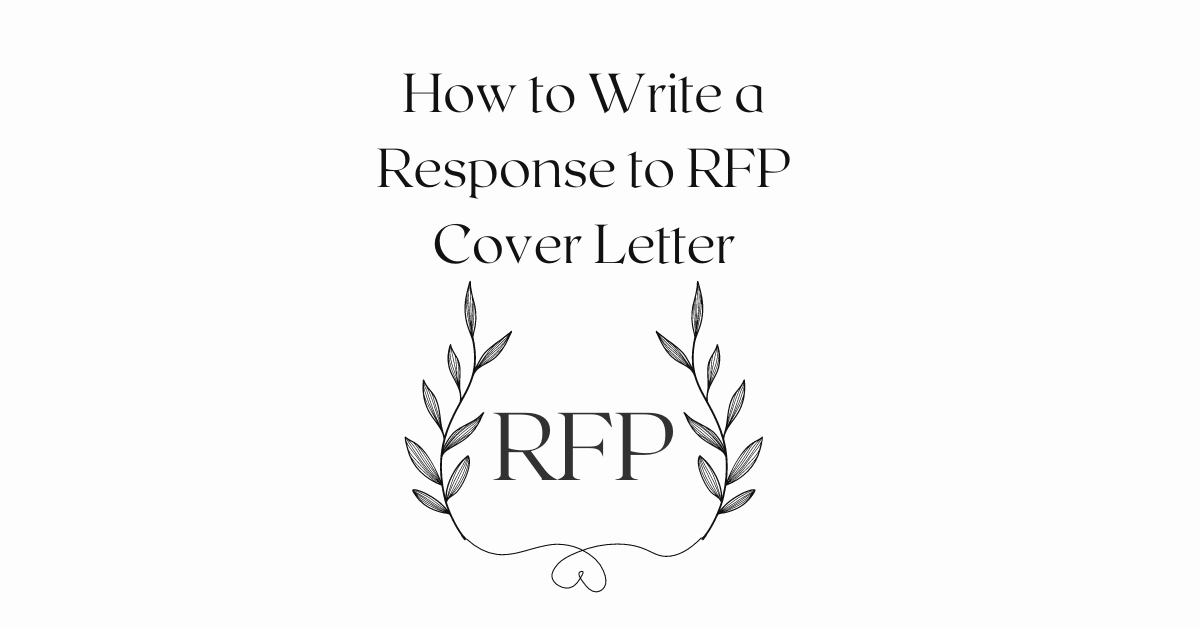
1. Understanding the RFP
Before you begin writing your response to an RFP, it’s crucial to fully understand the requirements and expectations outlined in the RFP document. Take the time to carefully review the RFP and make note of any specific instructions or criteria that need to be addressed in your cover letter.
2. Researching the Company
Research the company issuing the RFP to gain a better understanding of their needs, goals, and values. This information will help you tailor your cover letter to address the company’s specific needs and demonstrate your understanding of their business.
3. Highlighting Your Qualifications
In your cover letter, highlight your company’s qualifications and experience relevant to the RFP. Showcase your expertise, capabilities, and past successes to demonstrate why you are the best fit for the project or contract outlined in the RFP.
4. Outlining Your Proposal
Outline your proposal in a clear and concise manner in your cover letter. Provide a brief overview of your approach, methodology, timeline, and cost estimates. Avoid using technical jargon and ensure that your proposal is easy for the recipient to understand.
5. Demonstrating Value
Demonstrate the value that your company can bring to the project or contract. Explain how your unique capabilities, experience, and expertise set you apart from other potential vendors and how they align with the needs of the company issuing the RFP.
6. Closing Strong
Close your cover letter with a strong conclusion that reiterates your interest in the project or contract and your confidence in your ability to deliver results. Thank the recipient for considering your proposal and express your eagerness to discuss the opportunity further.
7. Editing and Proofreading
Before submitting your response to the RFP, carefully edit and proofread your cover letter to ensure that it is free of errors and conveys your message clearly and professionally. Consider asking a colleague or mentor to review your cover letter for feedback.
FAQs about a Response to RFP Cover Letter
Navigating the intricacies of responding to a Request for Proposal (RFP) can be daunting. Here are some commonly asked questions regarding the process of writing a response to an RFP cover letter:
1. What is the purpose of a response to an RFP cover letter?
The purpose of a response to an RFP cover letter is to introduce your company and proposal, highlight key points, and persuade the recipient to consider your proposal further.
2. How should I format a response to an RFP cover letter?
Your response to an RFP cover letter should be formatted professionally, with clear headings and sections. Use a formal tone and language, and ensure that your letter is well-organized and easy to read.
3. What should I include in a response to an RFP cover letter?
In your response to an RFP cover letter, you should include a brief introduction of your company, an overview of your proposal, and a closing statement expressing your interest in the project or contract.
4. How can I make my response to an RFP cover letter stand out?
To make your response to an RFP cover letter stand out, focus on highlighting your company’s unique qualifications and experience, and tailor your proposal to address the specific needs outlined in the RFP.
5. What should I do after submitting my response to an RFP cover letter?
After submitting your response to an RFP cover letter, follow up with the recipient to ensure that they received your proposal. Be prepared to answer any questions or provide additional information as needed.
Response to a Demand Letter
Response to a Complaint Letter
Letter to Sammi Jersey Shore
Offer to Settle Debt Letter
609 letter to debt collector
Leave a Comment Cancel Reply
Your email address will not be published. Required fields are marked *
Save my name, email, and website in this browser for the next time I comment.
RFP Cover Letter: The Dos and Don’ts
Table of Contents
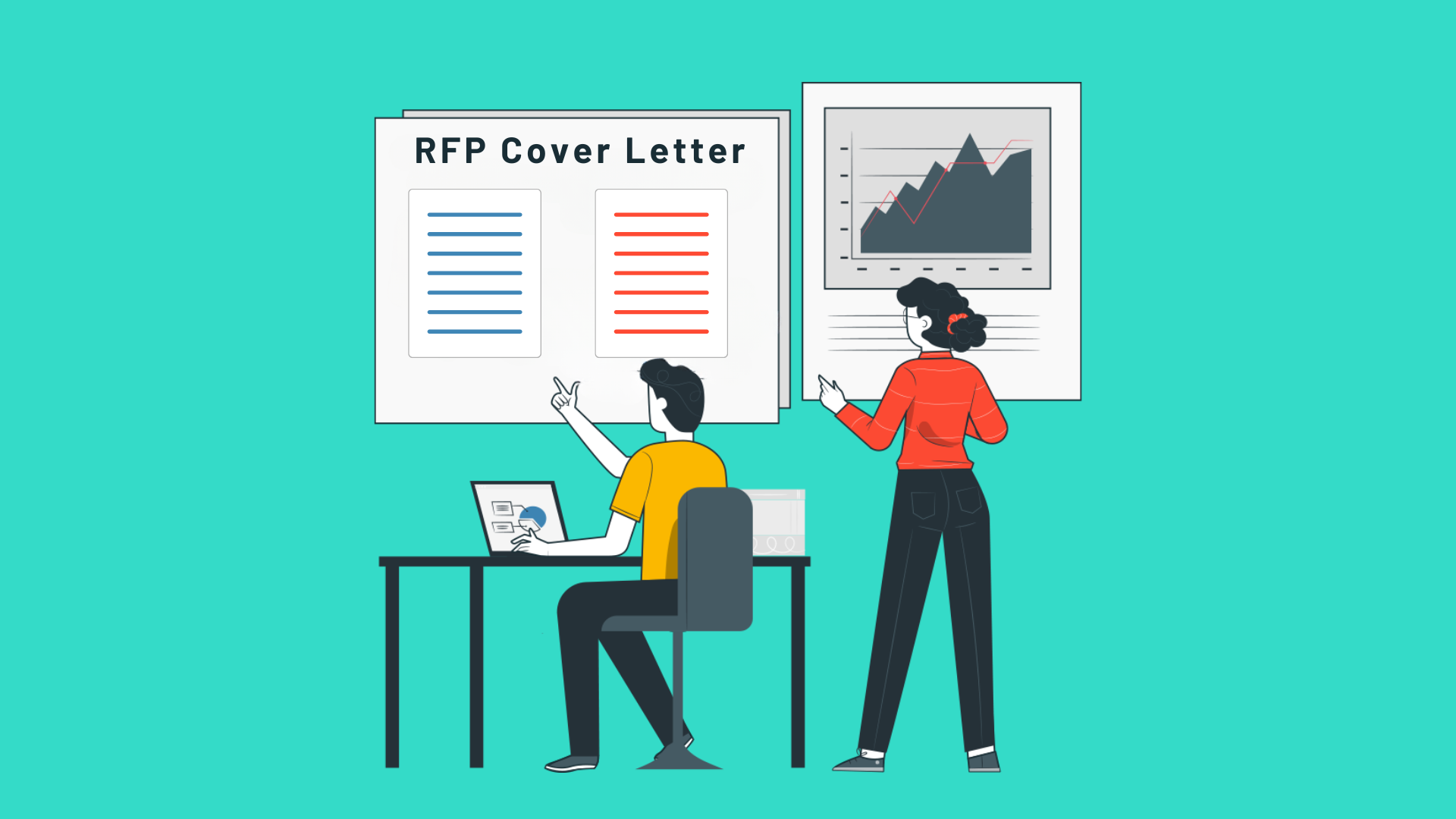
You’re not alone if you feel like completing RFPs is a never-ending process. Time, research and planning all take an organized effort from your team. There are myriad documents to assemble and requirements to meet. But, just when you think you’re finally finished, you may realize that you’re forgetting that all-important ‘first impression’: your RFP cover letter. Cover letters are often not on the list of the issuer’s requirements, so they’re easy to forget. Some people also feel uneasy writing cover letters because they’re so different, both in purpose and tone, from the rest of the bid. But, as with the icing on the cake, the cover letter tops off your information-full RFP with a personalized touch.
Your RFP cover letter’s objectives are:
- To thank the company for the opportunity to bid.
- To provide a short explanation of who your company is.
- To quickly summarize why your company is qualified to meet the requirements of their RFP.
In this article, we share some notions of what to do (and what not to do) when writing your RFP cover letter.
Do: Match Your Style to the RFP
As the cover letter is the first page of your RFP package, tailor the formatting to align with the issuer’s requirements. Issuers typically include a specific formatting guideline they ask responses to follow, including font and font sizes. For example, if the issuer requires the response to be in Times New Roman in 12-point font, implement the same into your cover letter.
Don’t use any fonts meant for party invitations (i.e., Comic Sans, Scripts, or any that reflect handwriting). If the issuer does not list a requirement, select a font that’s clear, professional and easy to read (i.e., Roboto, Arial).
Don’t: Write a Lengthy RFP Cover Letter Introduction
Your response is filled with many pages detailing, defining and fulfilling a complete scope of work. The procurement manager will be spending all of their time reviewing and comparing your response to others with similar information. Don’t overburden the reader by writing a long, overly detailed cover letter.
Rather, impress them with a quick, smart and to-the-point RFP cover letter not exceeding one page in length. Your team has put together the perfect set of responses to all of the questions of the RFP. So, leave that information to speak for itself within the remainder of the document.

Do: Follow All the Rules of Business Letter Formatting Etiquette
Although the RFP cover letter is an introduction to your fun and exciting team, this isn’t the place to go rogue by using perfume-infused paper. Rather, stick to proper business letter formatting . However, you may introduce a visual of your business logo using your letterhead. This also adds a pop of color to the sea of black-and-white information that follows.
We then recommend applying formalized business letter etiquette rules such as:
- Include the issuer’s business name, address and contact information.
- Insert the final date of when your response was completed.
- Address the letter to the key person at the organization who’s reviewing your bid. Don’t address your letter “To Whom It May Concern” or the like. If the RFP doesn’t list a contact person, take the extra step and contact the organization to ask for the contact name(s). This little bit of effort shows the reader that you’re invested in creating a relationship with them. As simple as it is, the person on the other end of the RFP will likely continue reading your full introduction letter.
Do: Be Compelling
When writing RFP cover letters, it’s easy to come off as sounding impersonal or even repetitive. But don’t fall into this trap! Introduce your company’s compelling personality by directly engaging the customer.
Do follow these steps when crafting your letter:
- Thank the issuer for the opportunity to bid. But not right away! Avoid starting the opening line in your RFP cover letter using any “Thank you for…” statements. Instead, be creative and address a fact about your potential client. For example, “ Our team recognizes the impact DigitalSolutions Inc. made by upgrading the software solutions for the University of Neptune. “ Now, you’ve gained the attention of the reader. Because you’ve directly addressed a successful project they completed in the past, they’ll pay attention when you discuss continuing that success in the future.
- Reiterate the details of their RFP. Next, address their pain point(s). This should quickly sum up the details of their RFP and state that your business is prepared to resolve that need.
- Explain why your organization is qualified to respond. By now, you’ve done your homework on your potential client. So, use this part of the RFP cover letter to state why your team is uniquely situated to deliver solutions. Remember, it’s not a sales pitch; it’s an alignment pitch.
- Provide a short list of deliverables. This should acknowledge your inclusion of their requested main requirements. Don’t get into too much detail.
- Close the cover letter. Close your RFP cover letter with a call to action. A simple sentence letting the team know that you’re happy to provide them with any additional information is usually a safe bet. Then finish with a handwritten signature. This small step is the sprinkle on the cake that tops off the total investment you put into the bid.
Final Thoughts
Remember, the RFP cover letter should be the icing on the cake, and you want the reader to enjoy it. And you should also enjoy creating it. After all, your team dedicated their hard work, time and resources to crafting a perfect response for that customer. Your company is more than just a black-and-white response; use this area to your advantage and convey your commitment and personality! Just know that the more you engage, the more memorable you’ll be.
You Don’t Have to Go It Alone
At The Bid Lab, we work with clients who don’t have the time, resources, or experience to manage, write and build their bids. So whether you’re still learning the RFP process basics, looking for the perfect RFP recipe , or trying to avoid making common mistakes , The Bid Lab has your back. (Yes, even if you’re looking for non-RFP ways to expand your business altogether.) After all, we’re experts on both sides of the equation. We know how to write an RFP and how to respond to an RFP. Bids and RFPs are our business – all day, every day! So reach out for a free consultation by calling 1-844-4BIDLAB or emailing [email protected].
Need a Cover Letter Template?
A great cover letter can help you get started with your first bid. Download our proven template below and get a sneak peek into our secret sauce.
Download Our FREE Cover Letter Template
Interested in working together, get in touch with us by phone, email, or form submission..

- Bid Manager
- Bid Builder
- Case Studies
- Learning Center
This website and its content is copyright of The Bid Lab © 2024. The Bid Lab is a trademark of Bid Lab, LLC. All rights reserved.
- Privacy Policy
- Website Terms of Use
- Disclaimer Policy

How to create a stand-out RFP response (examples & tools)

When responding to a request for proposal, if you don’t stand out, you don’t win. But this doesn't mean you have to sacrifice efficiency for personalization.
Your end goal should be to sway the prospect in your favor with persuasive and engaging proposals. But you should also leverage templates and tools that allow you to do this at scale.
Read on as we explore tips and tools that will streamline your process and increase your chances of closing the deal.
The 6 elements of an effective RFP response
An RFP response is a written sales proposal that answers how a company can meet the requirements outlined in a request for proposal (RFP) from a potential client.
It typically includes a detailed description of the company's proposed solution, approach, capabilities, experience, and pricing.
The purpose of an RFP response is to demonstrate to the client that the company has thoroughly understood their needs and can deliver a solution that meets or exceeds their expectations.
Because every RFP response will compete with another company’s proposal, writing a winning proposal is all about standing out.
Stand-out RFP responses should be personalized to the prospective client and project but should always include a few key elements—plus any additional information the client has asked you to provide).
Here are the six elements to include in your RFP response, along with RFP response examples you can use to draft a winning proposal.
1. Cover letter
Begin your RFP response with a concise and well-designed introduction that informs the prospect how your solution solves their problem. Use language that puts the focus on the potential client and highlights your company’s interest in working with them.
Ideally, your cover letter should mention the following:
- who you’re as a company
- what you can offer the client; and
- how your offering meets their needs better than your rivals
This creates a human connection that tells the prospect you understand their project requirements and shows enthusiasm about helping them reach their goals.
Example RFP cover letter
We appreciate the opportunity to respond to your Request for Proposal (RFP) for [Project Description]. Our team at [Your Company Name] is excited about the possibility of working with [Client Company Name] and we believe that our qualifications make us the ideal partner for your project. Our proposal includes [Brief Overview of the Key Features of Your Proposal, such as Methodology, Scope of work, Timelines, and Deliverables]. We have a wealth of experience in similar projects, as demonstrated by [Examples of Successful Projects]. At [Your Company Name], we're committed to excellence, delivering results that exceed our client's expectations. We understand that effective communication and collaboration are critical to achieving project success, and are dedicated to working closely with you to ensure that we deliver a solution that's tailored to your needs. We're confident that our proposal showcases our commitment to providing the highest level of service and value to your company. Thank you for your consideration, and we look forward to discussing our proposal with you in further detail.
2. Executive summary
The executive or problem summary is a high-level overview summarizing the most crucial parts of your proposal. It proves your company is qualified (and the best option) to meet their needs.
Focus on the prospect’s unique “asks.” For example, if the prospect wants a solution with flexible pricing, mention you have both annual and monthly plans—or that you offer a generous free trial.
To effectively address your customers’ biggest concerns in the summary, you need accurate information that helps you speak directly to the customer.
Consider the following questions to start:
- Why did the prospect issue the RFP?
- Was it because their last supplier failed to deliver?
- Are they simply looking to add more suppliers to accommodate their business’s growing needs?
Think of the executive summary as your elevator pitch that should hook the prospect and makes them go, “Okay, this company knows what we want.“ Keep it within one page and use bullets to help the prospect absorb information faster.
Example RFP executive summary
As a top player in the [Client's Industry] offering [Client's Main Service], you're well aware of the difficulties your customers face during this time of year. At [Your Company Name], we recognize the importance of delivering exceptional results at an average cost of $[Total Sum Amount] to support your mission of [Client's Mission Statement]. As these challenges become increasingly common, we believe that providing customers with a solution that's driven by the latest knowledge and expertise in [Your Industry] is more important than ever. Our goal is to help [Client Company Name] by: • [Client-focused benefit #1] • [Client-focused benefit #2] • [Client-focused benefit #3]
3. Deliverables and implementation plan
This is the meaty part of your RFP response.
Go into detail about your implementation plan and/or the deliverables you plan to produce for the prospect.
Also, mention the team members the client will work with and the things you’ll need from them (for example, training timelines, user roles, and process documentation) to ensure a successful engagement.
Dig deeper into how you’re going to meet the prospect’s needs, but also be crystal clear about the requirements you cannot fulfill. Transparency goes a long way.
RFP deliverables example
As outlined in the executive summary, our proposed deliverables, order of operations, division of labor, and projected completion dates aim to provide benefits to [Client Company Name]. These operations are expected to improve efficiency and customer satisfaction throughout our [length of project or proposed contract] partnership. Note that the following items are not included in the deliverables presented below: • [Product/service not included] • [Product/service not included] • [Product/service not included] Please refer to the table below for a breakdown of our proposed deliverables, team members assigned to each, start dates, and deadlines:
4. Pricing and contract terms
Create a pricing table breaking down the price by deliverable and included add-ons and services if any. Mention the service name, included deliverables, and the total cost for each.
Give the prospect a solid plan for what's to be done and how much it’ll cost them. Additionally, justify the cost by explaining what they get for each item on the list and how it’ll contribute to their business’s ROI. For example:
- total money saved
- percentage of sales/leads increased
- inefficiencies eliminated/efficiency gained
This is super important: provide accurate and transparent pricing quotes . Use clear language to avoid any confusion. Not only will this build trust, but also make the prospect more likely to consider your company for future requirements.
[Your Company Name] is incredibly excited to work with you to help [Client's Company Name] in addressing [Client Challenges Mentioned in Executive Summary]. Here's a brief overview of the services included in this partnership:

5. Additional product information
This part of your RFP response serves as a library to give the prospect any information they may need to determine your solution’s suitability for their needs. You can also include demo recordings, meeting recordings, and mutual action plans .
However, don't just send additional product information as email attachments or links on the side of your proposal.
It's possible the prospect may miss it. For example, if you send an RFP proposal and a demo link in the email, the buying team may never see that demo link. Luckily, you can use Dock to embed content within the RFP response itself. This ensures anyone who sees the proposal sees the additional information as well.
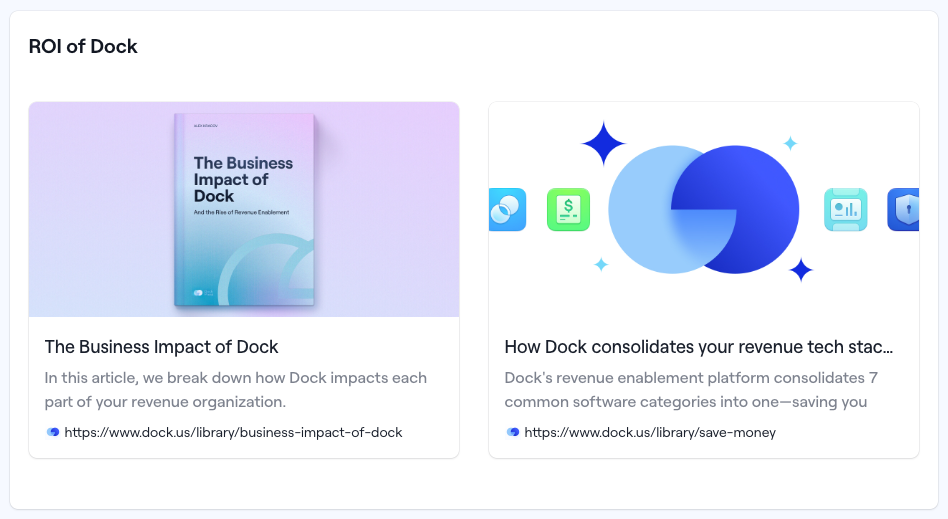
6. Social proof
The purpose of responding to an RFP is to win the deal, so you should include anything that strengthens your case and makes you stand out from the other responses.
Highlight references from companies you‘ve worked with in the past or continue working with professionally. Add testimonials or case studies that give the prospect more insight into your experience and see measurable results you achieved for clients.
You can also include awards and certifications your company has won to gain a competitive edge.
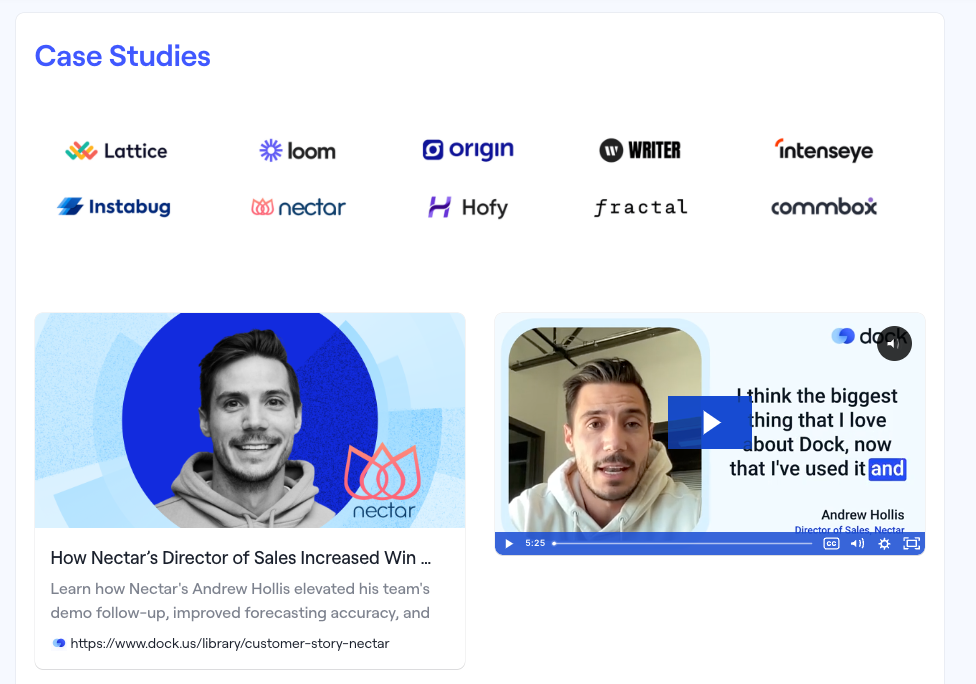
RFP response best practices and tips to improve win rates
Your RFP response should show and convince the prospect you’re absolutely the best choice for them.
Here are a few best practices and tips you can apply when responding:
1. Qualify every RFP opportunity
Many organizations make the mistake of wasting time and resources writing proposals for opportunities they don’t qualify for. Don’t be like them—have the confidence to walk away from deals you're unlikely to win.
Qualify each opportunity by identifying whether you have a strong buyer champion who can convince the client from the inside.
This person is someone from the client’s team who stands to benefit from the arrangement (for example, learns a new skill or gets a promotion) and is influential enough to sway the purchasing decisions in your favor.
Here are a few more questions to qualify opportunities:
- Is the prospect serious about the opportunity, or are they using the RFP for benchmarking or other reasons?
- Does the opportunity align with your long-term business goals?
- Do you have a genuine shot at winning the deal?
- Does your team have the capacity to take on the project?
There’s no shame in focusing on safer bets. Dedicate your time to opportunities you know a lot about and feel confident about winning.
Tip: If you’re looking for a great sales qualification framework, check out the Sandler Selling System or MEDDIC sales methodology .
2. Identify key decision-makers and stakeholders
To win traditional enterprise deals, your RFP response has to do more than just impress the main point of contact. It'll need to win over the entire organization, including the COO, CFO, IT heads, and other decision-makers who have a stake in your solution.
Here’s the main challenge: your buyer may not always make the stakeholders obvious.
To overcome this obstacle, get the organizational chart of your enterprise buyer for account mapping. Identify all potential influencers, blockers, and champions, and then build a strategic plan for how you’re going to multithread into their organization .
Work with your champion to do thorough research on each stakeholder.
- Who are they?
- What are their values?
- What are the KPIs for their role?
This will allow you to present your product or service in a way that makes sense to each stakeholder.
Once you better understand the stakeholders and decision-makers, put the requirements outlined in the RFP into context. Make sure your response directly engages with the specifications and addresses each one of them with a concise, clear answer.
3. Avoid sending static PDFs
Attaching static PDFs to your RFP response does nothing to make you stand out. Not only are they hard to edit or update once published (creating more work for you down the line), but it’s likely the RFP issuer may not read them at all.
Even the World Bank acknowledges that nearly one-third of its downloadable PDFs have never been downloaded. Yes, not even once. As the data marketing experts at Pricenomics conclude, “the lesson we should all probably be learning from the World Bank’s overly honest look at itself is that PDFs are terrible.“
So what should you do instead?
Instead of using a static PDF, create a dynamic workspace or digital sales room to share relevant proposal content and deliverables and provide a more interactive and unique experience to the RFP issuer.

A cloud-based solution like Dock, for example, lets you:
- Share and embed different types of media content to effectively communicate your product’s value to the client
- Better collaborate with the client and champion, where you can update your workspace with new information instead of sending tons of email attachments and risking overwhelming them
- Track engagement insights to guide your follow-up and drive customer success
All data is centralized in one place, so the client won’t have to waste time searching for different files and links. They can access anything from a single link removing any unnecessary friction and earning you brownie points.
4. Leverage templates and synced sections
If you’re replying to multiple RFPs that require similar answers, start from a template rather than starting from scratch every time.
With Dock, you can create a repeatable RFP response template that's easily customizable and shareable. In your template, include embedded content, mutual action plans, and quotes and order forms .
You can use a Dock template to:
- Personalize your response to reflect the client’s identity and needs
- Detail the value your product can provide the client
- Keep team members in the loop
- Track detailed engagement metrics to forecast interest
💡 Dock tip: You can use synced sections to scale your RFP responses. When you make a change to a synced section, it will update across all your RFP responses. For instance, you can always include your three latest case studies in a specific customer segment. You can use them to provide customers with accurate and relevant information to improve your chances of securing the deal.
5. Personalize your RFP response
While templates are handy, you can’t rely on completely templated RFP responses—personalization is still necessary to win.
Tailor your response based on the insights you learned about the decision-makers and stakeholders’ requirements, pain points, and values during research. This will immediately differentiate you from the competitors.
Be sure to provide specific answers and deliverables, as the client wants more than just a vague timeline. For example, go into detail about what the onboarding process and expected time-to-value look like.
Here are a few additional ways to personalize your RFP response at scale:
- Leverage variables in your template (e.g. the company name)
- Create templated RFP responses for each customer segment (e.g. a template for selling to an HR team vs. a marketing team)
- Personalize the content to the customer segment (e.g. case studies/testimonials from other customers in their niche)
💡 Personalization tip: Dock's dynamic variables let you pre-populate your RFP responses with the account name, contact details, and more:
6. Involve SMEs and sales engineers
If you’re selling to bigger companies, you have to assure them your solution fits right in with their processes—or they won’t buy from you.
Luckily, your sales engineer can use their expertise to better understand the client's specific challenges and propose solutions that best fit their needs. Use them to make customization recommendations, outline implementation plans, and provide detailed estimates.
Also, involve subject matter experts (SMEs) early in the drafting process so that they have enough time to fact-check answers and provide technical feedback on how to move forward. Other team members can also assist with the research and requests to help the experts contribute to the scope of the project.
7. Get ahead of security reviews with security profiles
Your prospective client may ask you to complete a security assessment as a part of your RFP response. You can contact your security team to answer specific technical questions and find security documents, but if they’re too slow to respond, you may end up losing the business opportunity.
That’s where security profiles come into the picture.
With Dock's pre-made security profiles , you can stay ahead of security reviews and avoid compliance obstacles. By uploading security documentation and FAQs to a secure space, your security admins can easily provide the necessary information to the sales team, who can then incorporate it into their RFP responses.
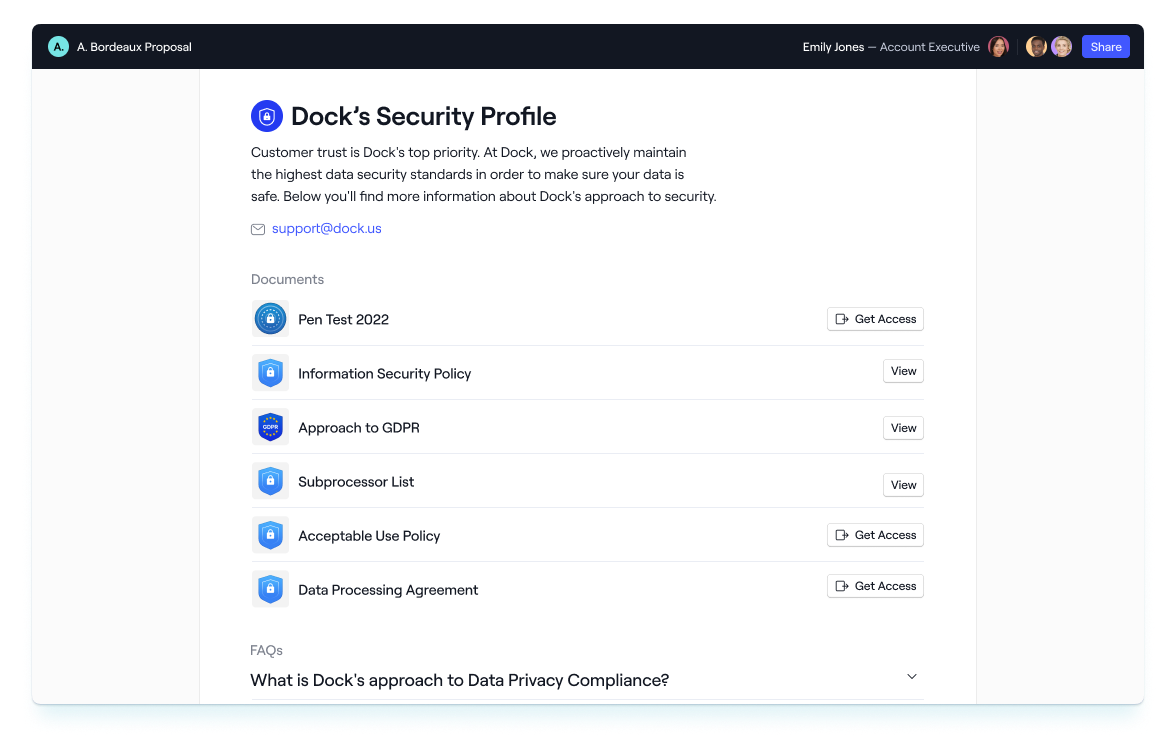
This way, your client will have all the information they need about your organization’s security posture, along with other deliverables like demo videos and pricing lists, without the need for any back and forth.
8. Send regular follow-ups
After sending your final proposal, it’s important to follow up and ensure your proposal is getting the attention it deserves. Don’t make the mistake of assuming your proposal will stand out on its own, or that the client will take initiative to reach out to you.
Rather take the time to follow up and engage with the client.
One way to do this is to include a link to your RFP in your follow-up email. This serves as a reminder to the client, making it easier for them to review your proposal again and explore more about your company and its offerings.
When following up, be sure to personalize your message and provide additional information that may be relevant to the client.
Our Dock experts always share a success story or case study when sending follow-ups to demonstrate our experience and expertise in a similar project or industry. This has nearly always gotten us a response from prospects.
RFP response software and tools
Here are the best RFP software and tools you can use to create and manage RFP documents and streamline proposal processes, increasing your chances of winning new business:
Dock's collaborative workspace offers a dynamic and effective alternative to static RFP submissions, increasing your chances of winning new business.
With our content management/company templates or customizable RFP response template, you can save time and improve efficiency when responding at scale. Powerful analytics and insights allow you to track client engagement with your RFP, including who has accessed your workspace and which content they interact with the most.
This enables you to tailor your follow-up and adjust your proposal to better meet your client's needs.
Dock also offers robust security features, including security profiles with clickwrap NDAs and access restrictions based on specific email domains. This ensures that only authorized individuals can view your proposal, making it ideal for organizations that handle sensitive or confidential information.
In addition to these features, Dock provides tools to improve collaboration and build scalable sales processes, enhancing the customer experience beyond the initial proposal.
RFPIO is a feature-packed RFP automation system with high-quality import and export functionality, project management solutions, and a dynamic repository. It makes a great choice for companies that send out RFP responses in large volumes and would benefit from a highly automated system with numerous customizations and options for custom quotes.
The tool offers an "at-scale" solution with various moving parts that streamline the entire process, making it more efficient and time-saving. But it won't give you Dock's personalized and content-heavy approach, so RFPIO may not be the best option if your priority is personalization.
Loopio is another proposal management tool that centralizes and automates your RFP responses.
A Smart Library provides your team members with the information they need to improve response quality, while the collaborative project workspace makes it easy to tap into your colleagues' expertise and add more depth to your responses.
A host of intelligent automation tools eliminate tedious tasks and maximize time. If you're looking for more hands-on help with your proposal tool, you'll find Loopio a good choice. But since it's a relatively new tech, it does have glitches and bugs.
Close more deals with with Dock
Dock helps prospects understand the value of your business.
In addition to being a workspace to sell effectively, it also creates a dynamic environment where you can discuss and collaborate with the client, giving you unprecedented access to their thinking process. You can truly own and design your brand’s client experiences to make maximum impact.
To learn more about how Dock simplifies RFP responses, try Dock for free today .

Related Revenue Lab Articles
.jpg)
Templates for Sales, Onboarding, Projects and Portals
Customize and share with clients

- Client-Facing Workspaces Sales Proposal & Order Form Software
- Sales Content Management Software
- Client Project Management Software
- Digital Sales Room Software
- Customer Onboarding Software
- Client Portal Software Mutual Action Plan Software Sales Proof of Concept Software Sales Portal Software
- About Us Careers Request Demo
- LinkedIn Twitter
Legal & Support
- Help Center
- [email protected]
- Privacy Request
- Privacy Policy
- Terms of Service
How to Write a Winning RFP Response + Free Template
Table of Contents
What is an RFP response?
Rfp response process, how to respond to an rfp, rfp response best practices, rfp response template, rfp response software, speed up the rfp response process with ai.

- December 26, 2023
Anna Fitzgerald
Senior Content Marketing Manager at Secureframe
Emily Bonnie
The average request for proposal (RFP) includes 77 questions , and each question takes approximately 25 minutes to answer. That means it takes an average of 32 hours to respond to a single RFP.
Now imagine you get multiple RFPs a week. Responding to them is highly manual, tedious, and time-consuming. Having a standardized process in place can help save your team valuable time, improve the quality of your RFP responses, and win over more new clients.
To help you simplify the RFP response process and improve your win rates, we’ll outline a step-by-step process, explain how RFP software can streamline your efforts, and provide request for proposal templates.

A request for proposal (RFP) is a common step in the vendor procurement process. It’s an effective tool for companies to learn about multiple vendors and select the one that best meets their needs.
An RFP response is a bid from a qualified vendor or contractor to complete a project that was publicly announced and described in an RFP or RFI (request for information). This response should show that your organization can meet the client’s criteria for skills, budget, and timeline, among other factors.
Essentially, an RFP is an organization saying, “We need a vendor to help us do XYZ.” Companies issue an RFP and various vendors submit their bid through an RFP response, which explains how the vendor can meet that need and why the organization should choose them over the competition.
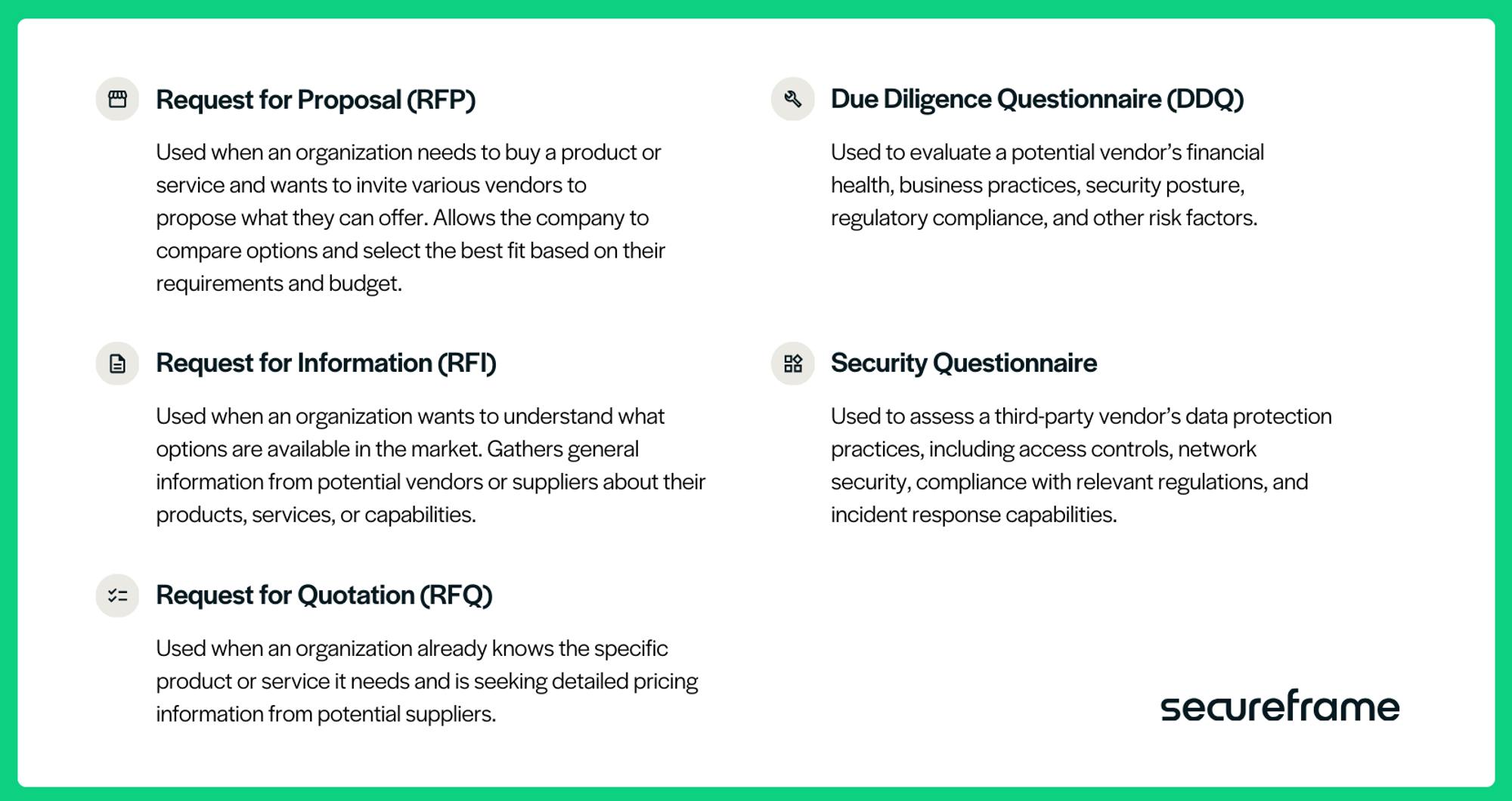
Recommended reading

What is a Request for Proposal? + Template
The RFP response process
An RFP response process is a set of interrelated and repeatable steps you follow to respond to an RFP. This process can help you determine which RFPs are worth responding to, assign deliverables and deadlines to the right people, and ensure you submit a draft that’s already been reviewed and proofread by the due date.
Having a standardized process can ensure that RFPs are responded in a consistent way, even as your organization grows and looks to take on more clients.
Let’s take a look at the individual steps involved in the process below.
Follow the step-by-step RFP response process below to showcase how your organization can meet the client's needs.
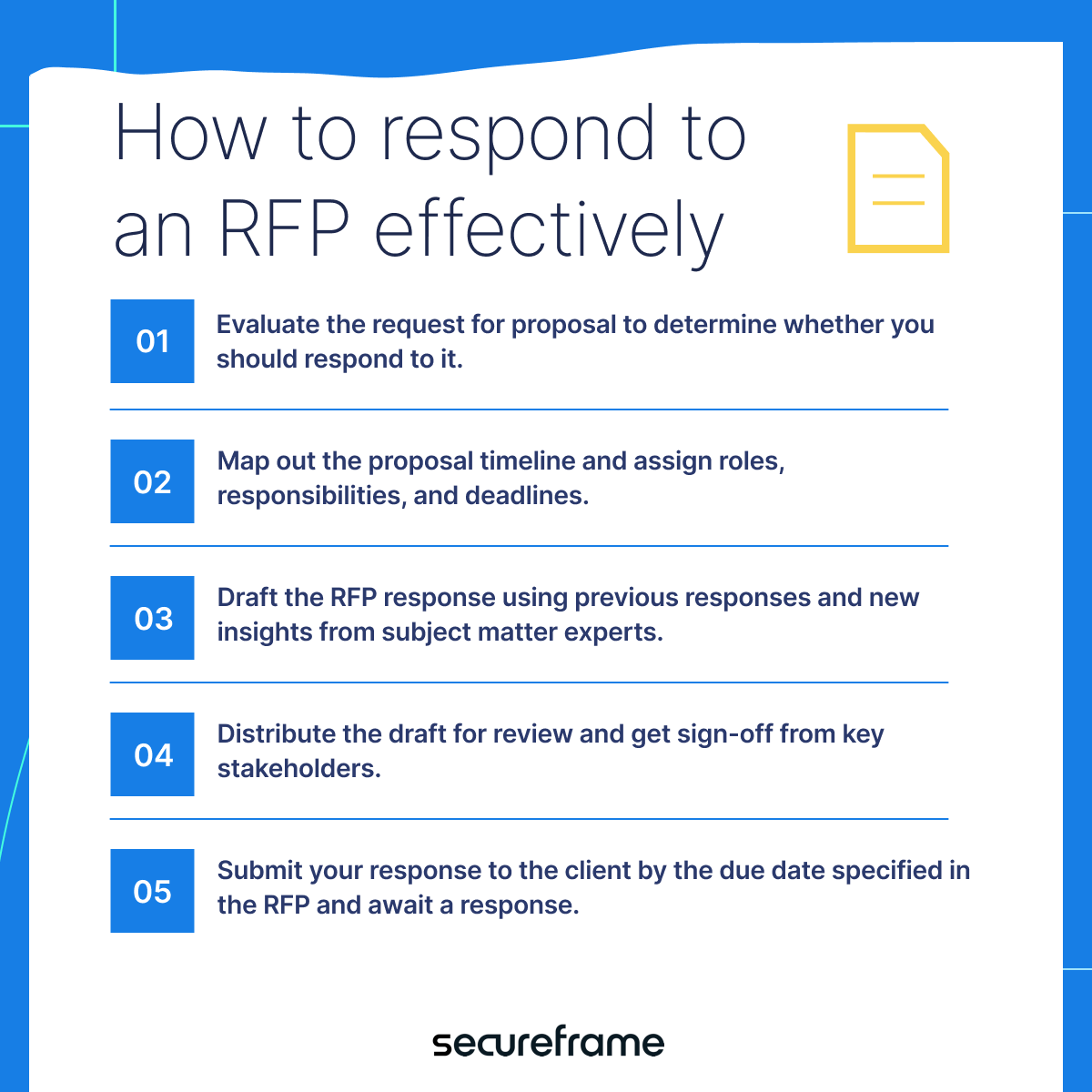
1. Evaluate the RFP
The first step is to evaluate the RFP to ensure you understand exactly what the client is looking for and decide whether you should respond to it. Based on the scope of work, you may determine that it’s not a good customer fit or that you don’t have the resources to complete the project on the expected timeline. Or perhaps the return on investment will likely be lower than the cost of completing the project. Whatever the reason, you can decide not to respond, saving your team valuable time and resources.
If you determine it is a good opportunity for your organization, then you can continue on to the next step.
2. Map out the proposal timeline and assign deliverables
To ensure you submit the RFP response in a timely manner, it’s important to clearly assign roles, responsibilities, and deadlines.
While there are different project management approaches you may take, a common methodology is to break down each task required to complete the RFP response into individual steps and assign an owner and due date or milestone for each.
For example, the task of evaluating an RFP may be broken down into several steps, like:
- Reviewing and summarizing the RFP by a proposal manager and account executive
- Making the go or no-go decision after consulting with legal, finance, and an executive stakeholder
- Creating and publishing a proposal timeline with the proposal manager
3. Draft the RFP response
Write the cover letter.
The cover letter accompanies your RFP response and is the first document the reviewing team will see. It’s a crucial introduction to your company and a valuable opportunity to highlight any unique qualifications or expertise that make your organization the best fit.
Here’s what you should include in your RFP cover letter:
- Brief introduction: Include your company name and contact info, and a short statement about your organization’s qualifications. Clearly state that your letter is in response to the specific RFP you’re answering and include the RFP title and/or reference number.
- Summarize your proposal: Give an overview of your proposal, highlighting how it meets the specific requirements outlined in the RFP. Demonstrate a clear understanding of the client’s goals, challenges, and requirements.
- Detail the attachments: Mention that your detailed proposal is attached, along with any other relevant documents, case studies, or materials.
Keep your cover letter concise and professional. Make sure you proofread for any spelling and grammatical errors, and follow any formatting or submission guidelines specified in the RFP.
Write the executive summary
The executive summary offers a brief overview of your proposal, highlighting the key points and making a compelling case for why your organization is the best choice for the project. It should highlight how well you understand the client's needs, your proposed solution, and the unique benefits or value your company brings.
Here’s what to include in your executive summary:
- Key Requirements : Begin by demonstrating a clear understanding of the challenges or requirements outlined in the client’s RFP to shows the client that you have thoroughly digested their requirements and are responding specifically to their situation.
- Proposed Solution : Outline your proposed solution or approach. This should be a high-level overview, focusing on how your solution addresses the client's needs and the outcomes you expect to achieve. Pay special attention to the Scope of Work section of the submitted RFP when specifying your deliverables and implementation plan.
- Differentiators and Value Proposition : Highlight what sets your proposal apart from the competition. This could be your company's unique expertise, innovative approach, cost-effectiveness, superior technology, proven track record, or any other factors that give you an edge.
- Benefits to the Client : Clearly articulate the benefits the client will receive by choosing your solution. These benefits should be direct responses to the client's objectives and pain points as outlined in the RFP.
- Call to Action : Conclude with a statement that encourages the client to read the detailed proposal and a note of readiness to discuss any aspects in further detail or clarify any points.
The executive summary should be concise, usually no more than one or two pages. However, it should be complete enough that if a decision-maker reads only the executive summary, they will grasp the essence of your proposal and its primary advantages.
Explain pricing and contract terms
Explaining pricing and contract terms in an RFP response requires detail and transparency. Here’s a list of information to include:
- Clear Breakdown of Costs : Provide a detailed breakdown of the costs associated with your proposal. This can include one-time costs (like setup or installation fees) and recurring costs (like monthly or annual service fees). Clearly explain what each line item covers to help the client understand exactly what they’re paying for.
- Total Cost of Ownership : If applicable, discuss the total cost of ownership, which includes not only the initial costs but also any ongoing maintenance, support, or operational costs.
- Value Proposition : Explain how your pricing correlates with the value you are providing. If your solution offers benefits like increased efficiency, reliability, or innovation, make sure to highlight these. If your solution is more expensive than some alternatives, justify the additional expense by highlighting the superior benefits or long-term savings.
- Flexible Pricing Options (if applicable) : If there are different service levels or optional add-ons, lay these out clearly. This can include tiered pricing, discounts for longer commitments, or additional services at extra cost.
- Contract Terms : -Duration : Specify the proposed contract length and any terms related to renewal. -Termination Clause : Outline the terms under which either party can terminate the contract. -SLAs and Performance Metrics : Include any service level agreements (SLAs) or performance metrics that you commit to. -Payment Terms : Detail the payment schedule, invoicing procedure, and any late payment policies.
- Customization and Scalability : If your pricing can be customized based on the client’s specific needs, make that clear. And be sure to discuss how costs will be affected if the scope of the project expands.
Add social proof and case studies
As an attachment, include any success stories from clients that are similar to the new business you’re trying to win — highlight organizations from similar industries, company size, business challenges, and use cases. Testimonials from real customers can offer a compelling argument in your favor and give prospects a clearer idea of the value your company delivers and what it’s like to work with your team. Even better if you can provide contact information for a customer that’s willing to serve as a referral and speak to potential clients directly.
When drafting an RFP response, you can likely repurpose some answers from previous responses. You may see repeat questions asking about your firm, team structure, related project experience, and project approach as well as references and a cost proposal.
You will likely also need to consult subject matter experts for net new content or for help tailoring responses to the specific client. For example, responses to security and IT questions may require input from your CISO or information security team members.

4. Distribute the draft for review.
Before you submit your response to the client, you should get input and sign-off from key stakeholders in business operations, marketing, IT and security, finance, and legal, plus at least one executive decision-maker.
5. Submit your response to the client.
Before the due date specified in the RFP, submit your response to the client. Be sure to follow up with the customer to ensure they received it and answer any questions they may have.
8 Tips for writing a winning RFP response
When responding to an RFP, you’re likely competing against several vendors. What can you do to ensure your response stands out from the crowd? Here are best practices for writing a winning proposal that leaves potential clients with a stellar first impression.
- Follow the client’s instructions: Make sure you respond to all required questions and follow the submission instructions specified in the RFP. Instructions might dictate the length and format of your RFP response, when it should be submitted, and more.
- Focus on the client’s needs : Every section of your RFP response should be dedicated to proving how your organization’s proposed solution is the best choice to meet the client’s needs. Make sure to continually reference the RFP and requirements outlined in that document when writing your response.
- Customize your proposal response to the client : While you can repurpose answers from previous RFP responses, you should take the time to tailor the response to the unique client and requirements of their RFP. Position your features around their current pain points, use client-specific visuals, and reference the prospect’s needs as directly as possible. For example, you can customize your company’s boilerplate messaging to mention the client specifically. Say Secureframe was responding to an RFP. Instead of saying, “Our company can help companies of all sizes achieve and maintain compliance with rigorous global standards,” we might say “Our company can help ABC Company achieve and maintain SOC 2 compliance.”
- Be specific : Be as specific as possible in your RFP response. After reading your response, the client should understand what tasks you are able to complete, how you plan to complete them, by what date, and with what budget.
- Include visuals : When possible, use visuals like charts and graphs to make your response more engaging and memorable. Customize your visuals to the potential client whenever possible.
- Share industry and security certifications: Be sure to mention your level of compliance with any applicable industry or regulatory requirements and security frameworks such as SOC 2 , ISO 27001 , and PCI DSS . If compliance involves an annual audit or certification, include the issue date or audit window.
- Automate your RFP response process : Automation can significantly speed up the RFP response process by suggesting answers based on previously answered RFPs, enabling you to assign subject matter experts to individual questions, and keeping an up-to-date knowledge base of previous responses.
These tips can help you write high-quality, effective RFP responses that clearly demonstrate why your organization is the best fit for prospective clients.
Download this free RFP response template to get a better understanding of what prospective clients might ask when trying to evaluate vendors and how you should answer. This can help you respond to RFPs faster and easier and increase your win rates.

Improve your win rates with RFP response software
Responding to RFPs is an important part of winning opportunities with new organizations, but it can eat up valuable time and resources for startups and large enterprises alike.
Some questions are the same from customer to customer and require you to repeat yourself or track down previous responses. Some questions vary from customer to customer with no standardized format, set, or order of questions, which means you need to bring in subject matter experts to repeatedly answer questions or update previous answers.
RFP response software can help automate the process, save time, and improve the overall quality of your RFP responses.
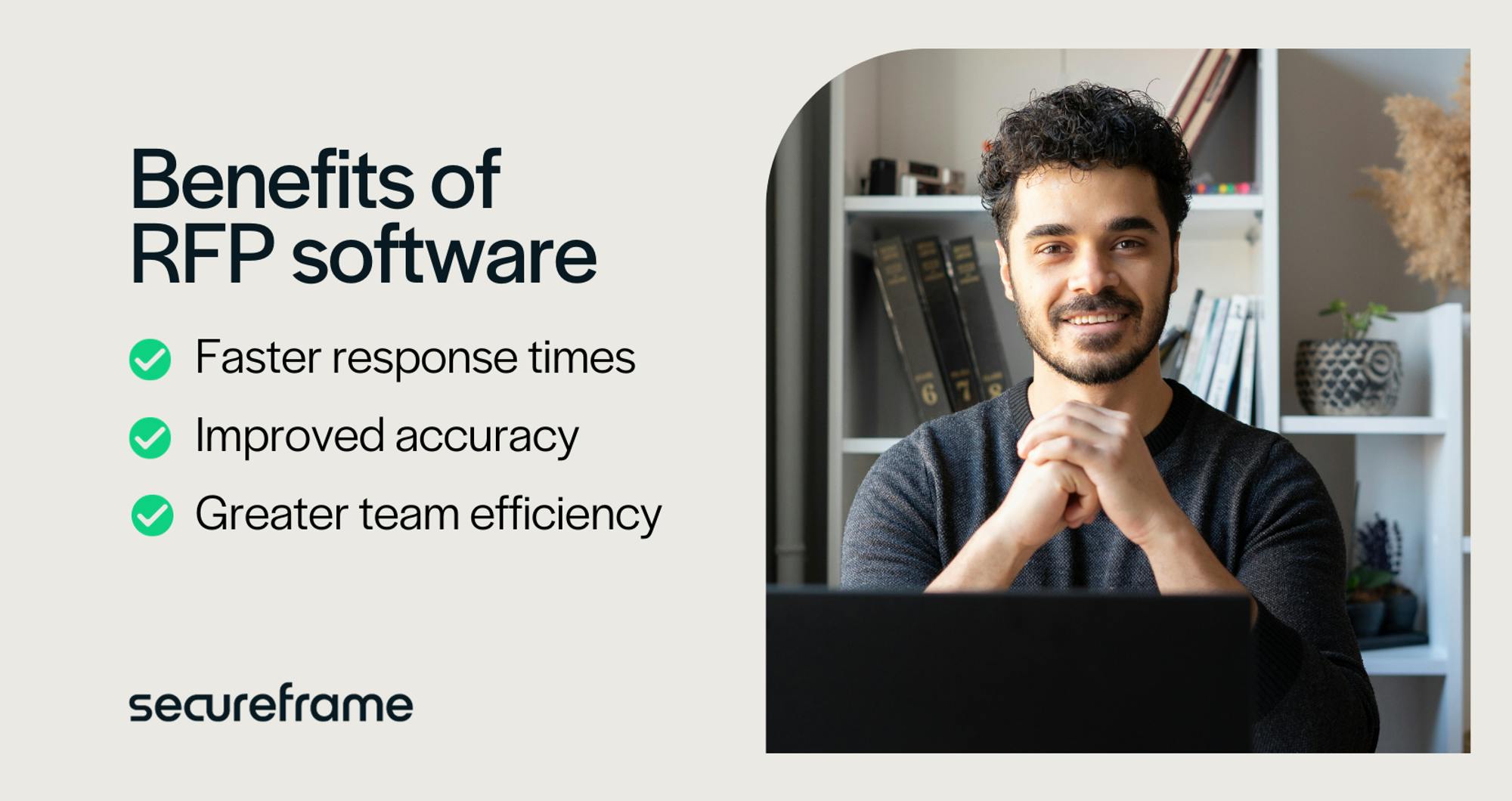
- Save time : Maintain a single knowledge base to improve response accuracy and speed up the RFP response creation process. AI and machine learning capabilities allow you to automatically include the best answers to fill out an RFP or security questionnaire quickly and easily.
- Improve team efficiency : RFP automation tools store the best content used in responding to previous proposals. By answering a question once in the knowledge base, your senior staff and subject matter experts can avoid fielding a flurry of incoming questions and focus on high-priority tasks.
- Avoid mistakes : Automation ensures all your RFP answers will be accurate and up-to-date.
With RFP software, you won’t have to spend hundreds of hours of manual work assigning incoming RFP questions to subject matter experts, combing through documents and folders to find previous responses to RFPs, and then copying and pasting them into the new proposal.
Instead, RFP software like Secureframe Questionnaire Automation and Knowledge Base can:
- Suggest responses based on previously answered RFPs using AI and machine learning
- Store previous responses in a knowledge base, which you can use to auto-populate future questionnaires
- Automatically update answers in the knowledge base as new responses to RFPs are finalized
- Allow you to assign subject matter experts to edit answers in an RFP response or knowledge base
- Export the completed proposal to the original format to send back to your prospective client
With Secureframe’s questionnaire automation , you’ll get hundreds of hours back to focus on other high priorities. And because you’ll be able to complete RFPs in less time, you’ll be able to edge out the competition and increase your win rates.
Automate the RFP response process with the power of AI
We built Secureframe Questionnaire Automation and Knowledge Base to make it fast and easy to respond to RFPs using artificial intelligence (AI).
Simply upload an RFP or security questionnaire to Secureframe, verify Secureframe’s suggested answers from the Secureframe Knowledge Base, and export the completed document in the original format to send back to your customer.
Schedule a demo of Secureframe Trust to see Secureframe Questionnaire Automation and Knowledge Base in action.
Use trust to accelerate growth
Rfp response faqs.
How do you write a response to an RFP?
- Read the RFP Carefully : Understand every requirement and question in the RFP. Pay attention to the details about the scope of work, deliverables, timelines, and evaluation criteria.
- Understand the Client's Needs : Understand their industry, challenges, values, and what they are likely looking for in a vendor. Tailor your response to align with their needs and goals.
- Assemble the Right Team : Ensure that the people who are knowledgeable about the topics addressed in the RFP are involved in preparing the response. This may include subject matter experts, project managers, finance professionals, and legal counsel.
- Outline Your Response : Start with an outline that maps your response directly to the requirements in the RFP. Make sure to cover all the points and questions raised in the RFP document.
- Develop a Compelling Executive Summary : This is often the first section read, so make it engaging and concise. Summarize your key value propositions and how they align with the client's needs.
- Address the Requirements : Clearly and thoroughly respond to each requirement in the RFP. Be specific about your capabilities, experience, and approach to meeting these requirements.
- Highlight Your Differentiators : What sets you apart from your competitors? This could be your expertise, unique methodology, innovative solutions, superior customer service, or any other factors that give you an edge.
- Provide Concrete Examples : Use case studies, client testimonials, or specific project examples to demonstrate your experience and success in similar projects or challenges.
- Be Clear and Concise : Avoid jargon and overly technical language unless it is industry-appropriate and necessary. Make your proposal easy to read and understand.
- Price Competitively : Provide a pricing structure that is competitive and clear. Ensure that your pricing model aligns with what's requested in the RFP (e.g., fixed cost, time and materials, etc.).
- Review and Edit : Proofread your proposal for any errors. A well-written, error-free proposal reflects your professionalism and attention to detail.
- Follow Submission Guidelines : Adhere to the format, length, and other submission guidelines outlined in the RFP. Submit your proposal on time and in the correct format.
- Follow-Up : After submitting your proposal, it’s often beneficial to follow up with the client to confirm receipt and offer to answer any further questions they might have.
Remember, each RFP is unique, and your response should be tailored to the specific requirements and context of the RFP. The goal is to demonstrate that your organization understands the client's needs and is the best choice to fulfill them.
How long should RFP responses be?
The length of an RFP (Request for Proposal) response can vary significantly depending on several factors, including the complexity of the project, the requirements outlined in the RFP, and the industry norms. There's no one-size-fits-all answer, but here are some guidelines to consider:
- Follow the RFP Guidelines : If the RFP specifies a page limit or word count, adhere to it strictly. Failure to comply with submission guidelines can sometimes lead to your proposal being disqualified or perceived negatively.
- Complexity of the Project : More complex projects often require more detailed proposals. If the project involves multiple components, such as software development, implementation, training, and ongoing support, your response will need to be comprehensive enough to cover all these aspects.
- Depth of Information Required : The RFP may ask for detailed information on your company's background, case studies, technical methodologies, or project management approaches. Ensure that you provide enough detail to thoroughly answer each question and demonstrate your capability, but avoid unnecessary filler.
- Clarity and Conciseness : While it's important to be thorough, clarity and conciseness are key. Avoid overly long, verbose responses that can make it difficult for the evaluator to find the information they need. Focus on being direct and to the point.
- Industry Standards : Different industries may have varying expectations for RFP response length. For example, a government contract RFP might expect more detailed and lengthy responses compared to a private sector small business RFP.
- Executive Summary : Even if your response is lengthy, having a clear and concise executive summary at the beginning can be very helpful. This section should be a high-level overview of your key value propositions and how you intend to meet the client's needs.
- Appendices and Supporting Documents : If you have extensive supporting information, such as detailed technical specifications, case studies, or team member resumes, consider including these as appendices to keep the main body of your proposal more concise.
As a general rule, your response should be as long as necessary to fully answer the questions posed in the RFP and to provide a convincing case for your company's selection, but no longer. Overly lengthy proposals can be time-consuming to review and may dilute the impact of your key messages. Always prioritize quality and relevance of content over volume.
5 Tips for Personalizing Your RFP Cover Letter
A proposal cover letter is a great way to address your bid requester. Learn how to craft a great cover letter for your RFP response.

After weeks of hard work, the response deadline is nearing and it will be time to submit the proposal you and your RFP team have been working on. You’ve included all the details, double-checked the numbers, and personalized your proposal . Before you submit your proposal, ask yourself: did I write a personalized proposal cover letter?
What Is a Proposal Cover Letter?

A proposal cover letter is a one-page letter that is addressed to your prospective bid requester. It contains high-level information about your proposal. Cover letters are sometimes called RFP response cover letters, RFP cover pages, or bid proposal cover letters. The cover letter is an important aspect of your RFP. Personalizing it gives you the chance to introduce your business, your solutions, and show in a glance how your business is best suited to the RFP you’re responding to.
To save time, it might be tempting to use a standardized or generic cover letter ; however, by doing so, you are losing an opportunity to make your proposal stand out from the crowd. Think about it this way: if most proposals are submitted with a generic letter, your personalized proposal letter makes your proposal even more memorable. It shows that your team has gone the extra mile and is completely up for the task at hand.
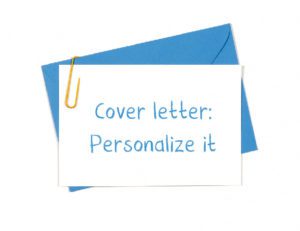
What to Include in an RFP Cover Letter?
Since a cover letter is only one page long, it’s important to include key details that are impactful and memorable in a concise manner. Not sure where to start? Consider including these key components:
- Introduce your company to the decision-makers and anyone else who might review your RFP
- Provide a brief overview of the company’s needs
- Clearly state why your business is uniquely qualified to win the RFP opportunity
- Express your vision for the future partnership
- Briefly explain how you can help the business reach its goals
- Be conversational, genuine, and confident
Even though personalization is important and helps you stand out, there are key components you may want to standardize as part of an RFP cover letter template. Make sure not to leave out:
- Addressees (and make sure everything is spelled correctly!)
- Brief greeting and introduction to your company
- Summary of RFP needs
- Your company’s broad qualifications
- Thank you and closing
5 Tips for Personalizing an RFP Cover Letter

Address the Right People
When submitting an RFP letter, make sure it is addressed to the right people. Although it might seem obvious, note that several people might read it. Before you hit submit, do some online research (or go old school and pick up the phone) to find out who will be reviewing your RFP throughout the process. You might be surprised to learn that your RFP will be reviewed by more people than you expected.
To make each proposal stand out, submit a cover letter addressed to each individual participant. For example, if you are submitting to eight committee members, each member will receive a cover letter that addresses them by their name, rather than a generic ‘To whom it may concern’ or ‘Dear committee member’. The easiest way to do this is with variable data printing (VDP). VDP is printing that customizes each printed document by designating text and graphics that are specific to each recipient. Variable data printing allows you to personalize text fields and images without placing multiple orders just to get specialized versions of the same document.
Introduction and Greeting
Consider avoiding standard introductions or greetings and instead use an introduction that is specific to the company and the people who will read your letter. This demonstrates that you have done your homework and that it isn’t just another generic RFP response. It might be a small gesture, but it will showcase that you’ve personalized your proposal to the client.
Catch Their Eye with Design
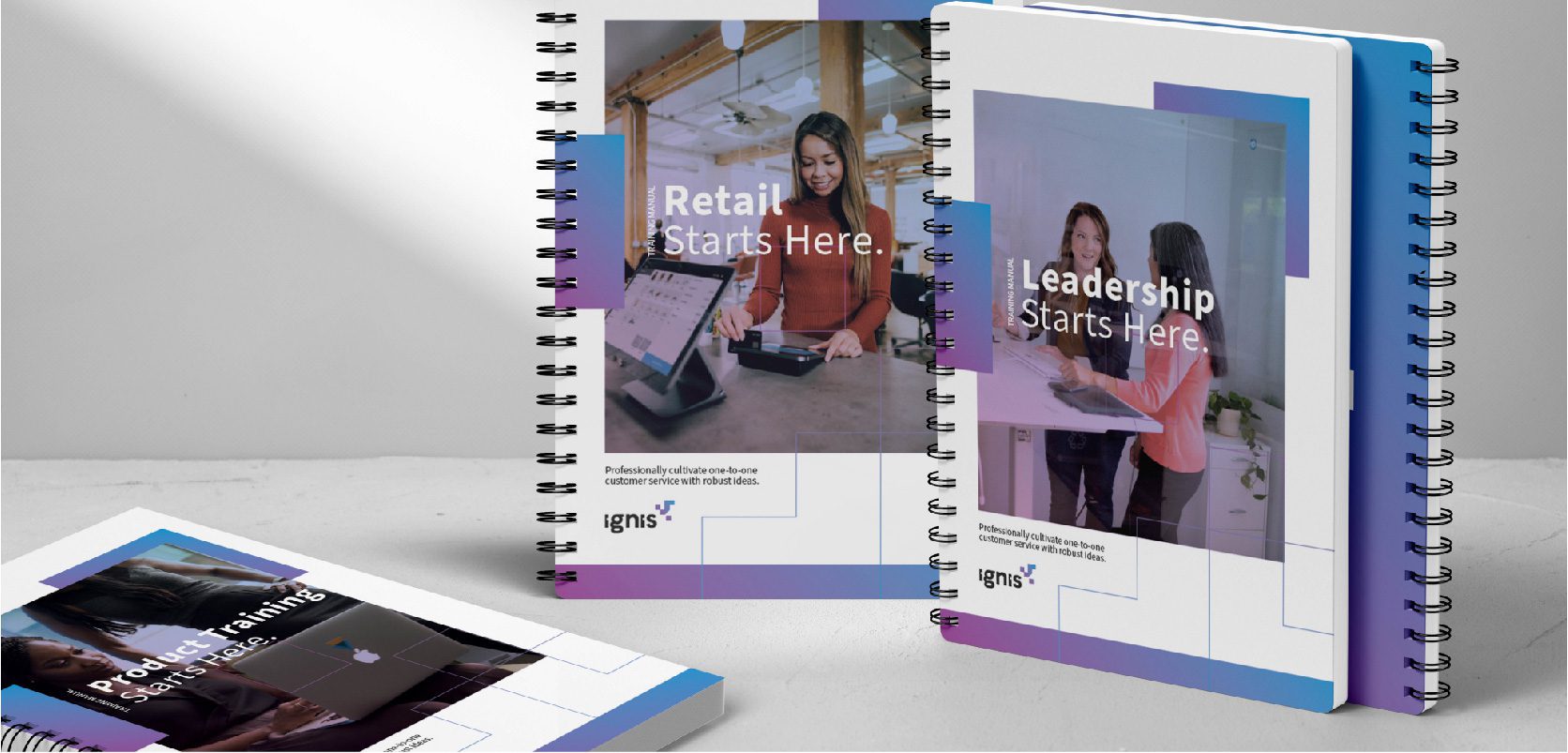
RFPs usually call for specific and strict specifications, and varying from them in your response can sometimes cost you your bid. But an RFP cover letter has less strict requirements and offers a space for using enticing, tasteful design to help make your proposal more noticeable. Consider adding your company’s logo or even including your selling committee members’ pictures on the letter. Small design nods can really make an impression and add that personalized touch.
Address the Client’s Situation and Challenges
You have the entire proposal to explain how your company and its products are best suited to meet the client’s needs. Yet providing a succinct and digestible version of how you understand their unique challenges showcases that you have a clear understanding of their needs, and are able to address and solve them.
Provide Your Solution
After you discuss their unique challenges, don’t forget to briefly explain how you are going to solve them. Even if your solution is complex or requires a deeper understanding of technology, providing a simplified version of how your solution addresses their needs shows that you truly understand their RFP and are ready to help.
Highlighting your solution in a variety of ways can ultimately help clients remember your proposal more clearly than the rest of the competition. In Mimeo’s Talk of the Trade podcast , Eve Upton, a psychology enthusiast and bid winning consultant at BidCraft, explained it this way: “If there are certain words and phrases you want that reader to remember and associate with your quality, whatever it is, then use them frequently, put them in bold, use alliteration, do whatever you can to make that stick in their head.” Beginning to tap that psychological tip in the RFP cover letter can ultimately strengthen how your proposal lands.

Adding that personalized touch to your cover letter is an easy and impactful way to make your proposal stand out. To learn more about RFP best practices or how to personalize your entire RFP , check out our blog about increasing your win rates with personalization.
- twitter Tweet
- facebook Share
- pinterest Pin
Mimeo Marketing Team
Mimeo is a global online print provider with a mission to give customers back their time. By combining front and back-end technology with a lean production model, Mimeo is the only company in the industry to guarantee your late-night print order will be produced, shipped, and delivered by 8 am the next morning. For more information, visit mimeo.com and see how Mimeo’s solutions can help you save time today.
Schedule a Print Consultation Today!
A representative will be in touch with you in the next 24 hours. See how much you can save.
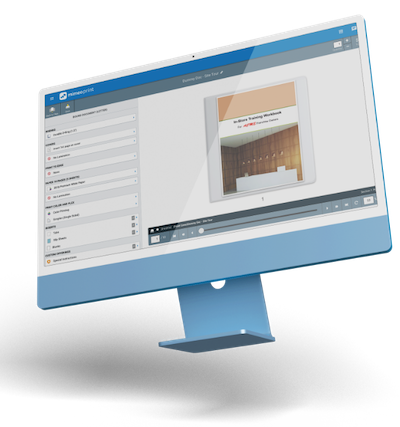
Search Perspectives
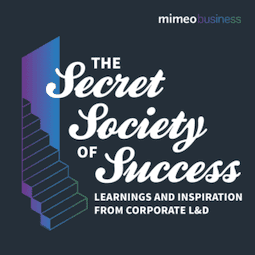
- Finance and Real Estate
- Human Resources
- Marketing and Sales
- Operations and Supply Chain
- Proposal Teams
- Retail and Hospitality
- Small Business
- Training Firms Consultants, Associations
- Document Printing
- Wholesale Printing
- Warehousing Fulfilment
- Direct Mail Services
- Promotional Products
- Mimeo Print
- Mimeo Marketplace
- Mimeo Digital
- Training and Consultants
- Manufacturing
- Restaurant and Hospitality
- Medical Equipment
- Associations
- Construction
- Oil and Gas
- Pharmaceutical
- Real Estate
- Presentations
- Newsletters
- Business Cards
- Display Signage
- Kitting and Bundling
- Marketing Folders
- Posters and Banners
- News and Perspectives
- Mimeo Schools
- Mimeo Photos
- Mimeo Business
- Proven Process
- Case Studies
Select your platform to login.
How to Craft a Winning Response to an RFP
- Digital Asset Management
- Project Proposals
- rfp response
Posted by: OpenAsset
Responding to an RFP can feel like a time-consuming, cumbersome chore that stands between you and a potential new business win, but they are also a terrific opportunity to show your potential client why you’re the perfect fit for the business.
RFP Response Tips and Tricks: Project Proposal Best Practices
This guide has everything you need to make the RFP response process easier, and more efficient. Here are six tips to help you knock your next project proposal out of the park.
1. Identify The Client’s Needs
Before you begin writing your proposal, it’s important to take stock of all of the information you can glean from the RFP and your external research, such as:
- the client’s underlying concerns,
- key issues plaguing their business, and
- the goals that they wish to achieve.
This process will enable you to deliver a more custom response that speaks directly to their needs, and which is more likely to get a positive response.
2. Analyze The RFP Requirements and Determine Whether or Not You Can Meet Them
The next step is to look at the client’s requirements and make sure you’re able to deliver the expertise and service they need. If you feel like your company can’t deliver, it might be best to decline the opportunity and turn your time and attention to other projects.
If it looks like a good fit, then create a list of the essential requirements and make sure that they are at the core of your response.
3. Assemble a Powerhouse Team
Responding to an RFP can be a labor-intensive task, made more complicated by the pressure of a looming deadline. Rather than tackle it alone, it’s best to gather a team of people from across your business. Working together will make the job easier and more efficient, and likely yield better results.
Depending on your industry, your team could include representatives from these areas:
- Sales and account management
- Senior management
- Procurement
4. Create a powerful proposal
Once your team is in place and prepped, get to work creating a response that consists of several essential components. Together they create a compelling argument for selecting your company over the competition. Be sure to include:
- A cover letter
- An executive summary
- A response to the main proposal request
- Case studies, and
Here are a few tips to make the most of each piece:
Cover letter
Your cover letter should introduce your business and demonstrate that you understand the client’s business. Show them why you’re the right choice.
Executive summary
Your executive summary is where you deliver a concise overview of your offering. It’s your opportunity to convince key decision-makers that your proposal is the best option. Avoid making it a pure sales pitch by remembering that you are looking to offer the client a solution, not just selling a product.
Use the executive summary to:
- State their objectives as you see them (“ you listen” )
- Show that you understand their objectives ( “you empathize” )
- Display your expertise and how you can help ( “you can deliver” )
A proposal is a place for you to demonstrate your expertise, so don’t distract the reader from your message with pricing. Save pricing info for a separate section at the end.
Case studies
Look at your previous and current clients and find a few that share similar challenges as your prospective client. Showcase how your business helped them solve those challenges and improve their overall business.
Final checklist
You’re not finished yet. Once you’ve drafted the proposal, read through it, make sure your answers are clear and concise and double-check spelling and grammar.
If you’re repurposing an old proposal, check the document properties to make sure no other client names or sensitive information is mistakenly used. Finally, look at your response objectively and think, “Does this address their needs?” and “Would this proposal convince me if I were the customer?” Does your response:
- Comply with most of their requirements?
- Empathize with their needs?
- Offer a compelling story as to why they should choose you over the competition?
5. Brand Your Response
Never underestimate the power of visual appeal. Make sure your proposal looks professional and accurately represents your brand and its attributes. Include your logo and make it easy for the client to learn more about your company by providing contact information, website address and social media links.
If you’re required to provide a hardcopy of the RFP response, consider printing it on higher quality paper, for example, at least 100 g/m2 weight with a matte or satin finish. It’ll look sharp and stand out from the others in the pile!
6. Leverage Technology to Streamline The Process
No doubt, responding to an RFP is a lot of work. It can be overwhelming—from start to finish—and winning new business depends on the overall quality of the end product.
Fortunately, there’s technology that can help make the process easier. Consider investing in a digital asset management solution to help leverage your digital assets more efficiently . It’ll save you time and stress and help create a more impactful proposal.
Final thoughts
Feeling better about creating a standout proposal? You’ve got this.
We’re always here to help. Check out some helpful tips on managing the pressure of tight deadlines —a given with most RFPs—and explore our digital asset management solution to learn more about how we can help streamline the entire process.
Get Started With OpenAsset Today
Unlike traditional DAM systems, OpenAsset is a project-based digital asset management solution specifically designed for AEC marketers and proposal writers. With dozens of integrations and useful features, OpenAsset is the martech you need to create high-converting content, proposals, presentations and much, much more. Contact OpenAsset today to get started .
Get OpenAsset DAM Insights

How to Create Winning Proposals
What to read next.

Air vs. OpenAsset
Choosing the right Digital Asset Management (DAM) system can be a game-changer for businesses aiming to streamline their digital asset organ...

OpenAsset Achieves Best Meets Requirements Award in G2 Report
OpenAsset is proud to announce that our Digital Asset Management (DAM) software has achieved the Best Meets Requirements Small-Business Awar...

Engineering Websites: 10 Web Design Tips + 30 Examples
For those passionate about engineering and looking to draw more clients to their firm, a website is undoubtedly the top tool for marketing. ...
Template: RFP Cover Letter

RFP Cover Letter Explained
Responding to a request for proposal (RFP) is a standard step in the buying process. With RFP responses, there are always opportunities to improve the quality of your content and improve your conversion rates as a result.
90% of successful marketers at B2B companies prioritize the audience’s informational needs over a sales/promotional message. The introduction of an RFP response involves a cover letter and an executive summary—these sections offer golden opportunities to develop content that is laser-focused on your prospect’s needs.
What is an RFP Cover Letter?
First up is the RFP cover letter . For positioning on your RFP response, this section should come before your executive summary. A cover letter should be no more than one page in length.
An RFP cover letter is a conversational introduction at the beginning of your RFP response . Similar to a cover letter you submit for a job opportunity, this letter is your chance to tell a little bit about yourself and why you’re the best candidate. It is almost always a requirement of an RFP, even if the issuer does not include a specific section.
The RFP cover letter:
States that you are bidding for their business by responding to the RFP.
Reiterates details from their RFP (i.e. company name, service/product requested).
Explains why your organization is qualified to respond to the RFP.
Reveals key benefits they will experience while working with you.
Lists anything you are providing in your RFP response.
Demonstrates your excitement for the potential partnership.
The RFP cover letter is not:
An excuse to jump into a sales-y spiel about your product or service.
Formatted with images or headers…it’s a letter with a greeting and sign-off.
The time to go into great detail about your strategy or execution.
An RFP Cover Letter Example You Can Replicate
The goal of your RFP cover letter is to eloquently introduce your organization as the right partner. By the time the issuer reaches the last sentence, they should feel confident about spending their time reading the rest of your RFP responses.
RFP cover letter example:
Hello [first name of RFP issuer]:
I speak on behalf of the entire [RFPIO] team in saying how thrilled we are to have been selected to respond to an RFP to become [Company]’s preferred partner for [Company – service or product need].
We look forward to showing the [Company] team why [RFPIO] is a strategic solution that will address the current and future challenges that [Company] is facing in their [response process]. With [RFPIO] as your partner, we will help:
[Create a more consistent process across international regions.]
[Save your team time to focus on other initiatives.]
[Provide insights into all RFP analytics across your organization.]
Included in this RFP, you will find responses that meet and exceed your requirements along with the [Company – additional materials] you requested. Should you need any other information to move this process forward and further validate your decision, please let us know.
We are grateful for this opportunity with [Company].
Thank you for your time, Kylie
Team and Org Chart
Andrew logemann, weekly standup template, allison daley, quarterly business review (qbr) memo template, brie wolfson, prd template, katherine kampf, guide: asynchronous communication, darren murph, product roadmap template, clare price, go-to-market plan (gtm plan) template, yelena kozlova, template: the build/measure/learn loop worksheet.
- Manchester Office
- London Office
- RFP Writing
- Proposal Ready
- Proposal Writing Services
- Testimonials
- Meet the team
- Free RFP Cover Letter Template
- RFP Writer Response Guide
- RFP Cover Letter Guide
- Government Bid Writing Guide
- Government Bid Management Guides
- Government Solicitation Guide
- Federal Bid Writing Guide
- State Government Contracts Guide
- Sources Sought Notice Guide
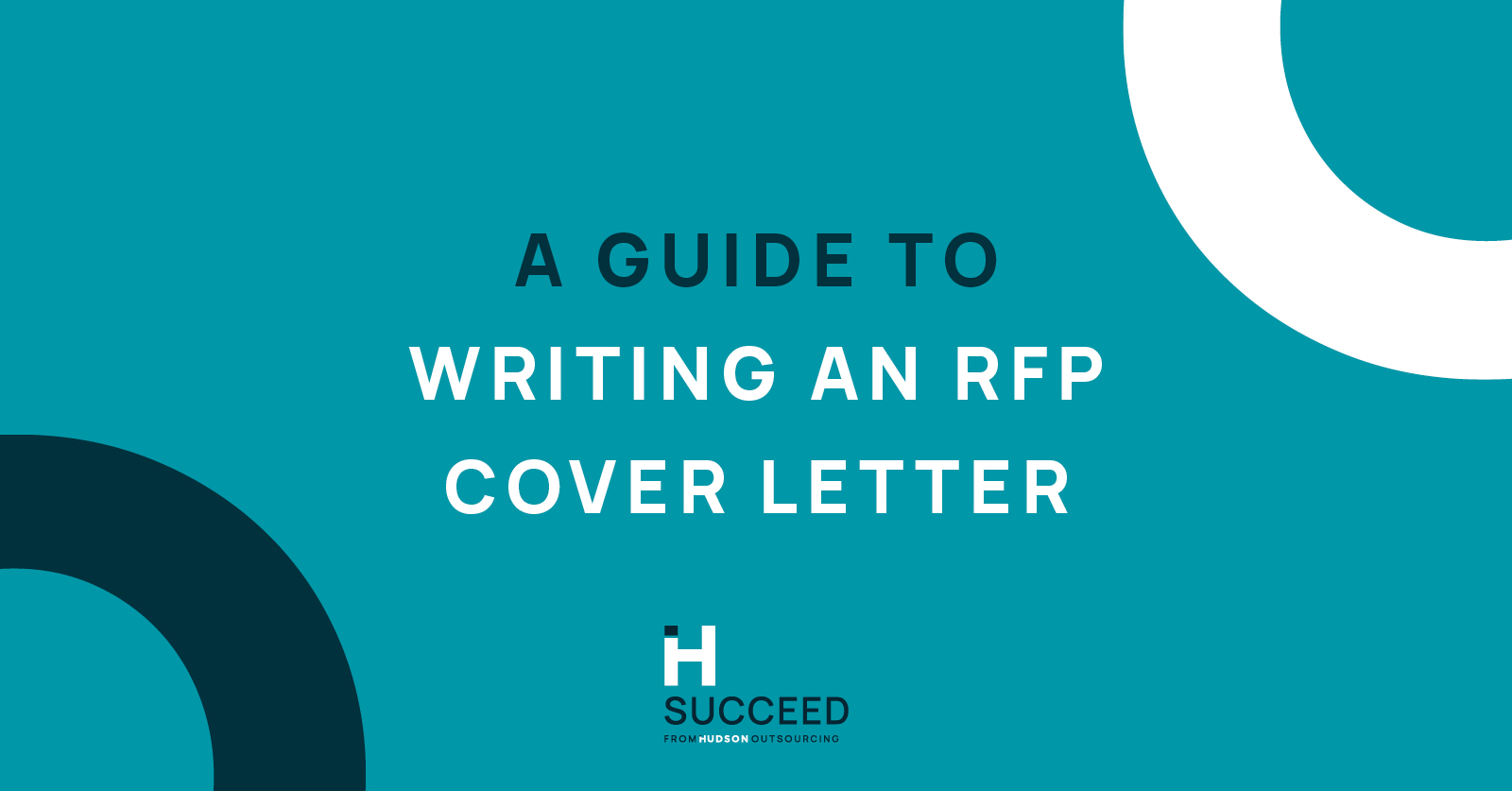
5 Tips for Writing a Better RFP Cover Letter
May 17, 2021.
Table of Contents
RFP cover letter template
When responding to a request for proposal (RFP) you may be asked to include an RFP cover letter. RFPs are used by local and federal governments and organizations in order to procure goods or services.
Your RFP cover letter will be the first thing that the contracting authority will read when looking at your proposal. Due to this, you want to make a good first impression, conveying your excitement about the opportunity. RFPs are greatly competitive so you want to stand out from other vendors.
What is an RFP cover letter?
First, let’s address the simplest question regarding what an RFP cover letter actually is. Your RFP cover letter is the first thing a contractor will see when looking at your RFP proposal . It should be no more than one page in length, and it’s almost always required with a request for proposal.
It’s more of a conversational introduction to your RFP response and your chance to tell a little bit about yourself. You could think of it as a cover letter for a job application. It is kind of similar, as you’re wanting the contracting authority to hire your business for the contract. You should detail what you’ll offer them and why you think they’ll benefit from hiring you.
Why is an RFP cover letter needed?
You would be forgiven for wondering what difference an RFP cover letter actually makes to the bid process. Well, if you think about it, your RFP cover letter is essentially your business’s first impression to a contractor. As you know, first impressions count and while the cover letters aren’t usually marked, you should still make the effort. This is why it’s just as crucial as your bid proposal and why you should put in the time.
DOWNLOAD FREE COVER LETTER TEMPLATE
What’s the difference between an rfp cover letter and an executive summary.
When talking about RFP cover letters, you’ll often hear the term of an executive summary thrown around. However, they are quite different. An executive summary is a high-level overview of your RFP response. It should capture the most important elements of your proposal on one page.
As I’m sure you’re aware, your RFP response can range from 10-pages to 50. Many contracting authorities have stakeholders that are key in the decision-making process. They don’t always have the time to read multiple 50-page proposals. This is when the executive summary comes in. They can have a read and understand a vendor’s proposal in mere minutes.
An RFP cover letter:
- Reiterates details from your RFP (including company name and the service or product requested)
- States that you’re bidding for their contract by responding to the RFP
- Explains why your organization is qualified to respond to the RFP
- Reveals the key benefits they’ll experience while working with your business
- Demonstrates your excitement for the potential partnership.
The cover letter should give the contractor the context of who you are before reading about what you do.
Here’s our go-to RFP cover letter template:
You may be wondering how to make your government bid RFP cover letter stand out. Below is our go-to RFP cover letter template that can help you outshine your competitors. Typically, there are five key points you want to cover in your letter.
Address your letter to a named contact at the organization
Always address your cover letter to a named contact within the contracting organization. If you’re not sure, get in touch and find out. Ask for the names of the key contacts that weigh in on the final decision.
Specifically addressing key personnel shows that you put the effort in to find out who is involved in the project. It will also increase your chances that they will actually read the cover letter. It suggests that you’re invested in developing a deeper professional relationship. Starting your letter with “To whom it may concern” suggests laziness and that it’s a generic copy and paste job. If all it takes is a simple phone call to find a name, why not give them a ring? Those two minutes can score you extra brownie points and show that you’ve done your research.
Introduction and greeting
Don’t start off your RFP cover letter thanking the commissioner. It’s overdone and boring and is likely what all your competitors will be doing. Put yourself in the commissioner’s shoes, if you’re reading 30 cover letters starting the same, it’s a little repetitive. You want to stand out and be memorable. Try starting with something complementary and specific about the contracting authority. This demonstrates that you have done your homework and that it isn’t just another generic cover letter.
Summary of RFP needs
You should convey that you understand what the commissioner is needed from their RFP. The evaluator doesn’t want to read a boring, robotic cover letter. You want to demonstrate you not only understand their business but their needs and how to best deliver them.
Your business qualifications and unique selling point
This section should highlight your business qualifications and differentiators. Include your business’s unique selling points (USP) and what you excel at. Here, you should really be persuasive and sell your company. Do you have any innovative solutions or cutting-edge features? Do you excel at customer support? This is the time and place to proudly showcase these to the commissioner.
A closing call to action
Concluding your cover letter with a closing call to action is a great way to close the pitch. After all, your RFP cover letter is basically a sales communication. Remember to thank them for their time and consideration for the contract and opportunity. You should state what you want them to do next and who they can contact should they need it. For example:
- Let me know if I can put you in touch with another client for a reference
- Please reach out with any questions you may have
- Should you need any further information to move this process forward, please let us know.
Tips on how to make your RFP cover letter stand out
As mentioned above, your cover letter should go against the grain. You want to stand out and be memorable and this is your chance. Below are some helpful tips on how to make your RFP cover letter stand out:
- Match your tone to that of the contracting authority
- Keep it fresh and genuine, the evaluators are human after all
- Stay true to your brand, if your business prides itself on being down to earth, use that style
- Be creative with your formatting, including a branded heading is always a nice touch.
So, hopefully, you have a better idea of how to create a memorable RFP cover letter. Avoid being generic and unspecific. Show the contracting authority that you’ve done your homework and are excited to work with them. An RFP Consultant will be able to help you with the whole RFP process. They understand what commissioners are looking for and how to best convey it.
Our services
Our RFP Writing service is the perfect solution to ensure that you submit a high-quality bid, even when you’re busy. Our RFP Writers will break down the solicitation documents, allowing you to see what the bid and the contract involves. This will help to ensure that you have all the specified evidence and meet the requirements of the contracting authority. Our RFP Writers will then craft persuasive, high-quality responses, attach supporting evidence and even submit the bid on your behalf. Upload the solicitation documents for a free quote.
Have you already written a bid but need a second pair of eyes to review your work? Our RFP Mentor service will do just that. Simply send over your bid responses and the solicitation documents. Our writers will then assess your work, ensuring that your responses are in line with the specification. They will also check for any spelling or grammar errors. You can then submit your bid with confidence. Upload your work for a free quote.
Do you need help with preparing a bid proposal? Proposal Ready can help businesses that are new to tendering or those in need of rejuvenating their content. Our Bid Consultants can offer you proposal writing services , creating:
- 3 designed and company branded case studies
- 5 company branded and professionally designed resumes for key personnel
- 1 company branded bid proposal credentials document that can be used to respond to future RFPs.
Find more helpful tips and advice in our blogs. We cover topics including:
- Working with RFP Writers
- Government bids
- Federal contract bids
- RFP cover letters
- Government RFPs
- Bid proposals
- Federal government RFPs
- RFP Consultants
- How technical Bid Writers can help your business
- And many more.
All information and data on this blog site is for informational purposes only. Hudson Outsourcing LLC make no representations as to accuracy, completeness, suitability, or validity, of any information. Hudson Outsourcing LLC will not be liable for any errors, omissions, or any losses, injuries, or damages arising from its display or use. All information is provided AS IS with no warranties and confers no rights.
Hudson Outsourcing LLC will not be responsible for any material that is found at the end of the links that may be posted on this blog site.
Because the information on this blog is based on Hudson Outsourcing LLC’s own opinion and experience, it should not be considered professional financial investment advice. The ideas and bidding strategies should never be used without first assessing your own personal and financial situation, or without consulting a financial professional. Hudson Outsourcing LLC’s thoughts and opinions will also change from time to time as the market changes and as Hudson Outsourcing LLC develops.
Share This Insight
Contact a bid writer, recent posts.
- Hudson Secure Another Technology Bid! – iMs
- Hudson Secure Another Facilities Bid! – Rise to the Top Escalator Cleaning Service
- Hudson Secure Another Construction Bid! – Native Sun Construction
Our Global CEO visits Dubai to meet our Middle East Bid Writing Clients!
2023 procurement changes in saudi arabia, bidding on government contracts across states, secure government contracts in the middle east from the us, finding rfps, bid writing in the middle east: how to win government contracts in uae, saudi arabia and qatar..
- Facilities Management Bids
- Business Proposal Writers: What do they do?
- RFP Compliance
- Top 10 Ways to Improve Your RFP Response
- Avoid These Top 10 RFP Response Mistakes
- What Makes a Good Bid Writer?
- Preparing to Bid
- Technical Proposals: The Ultimate Guide
- RFQs: What do they mean?
- Proposal Writing Services Near Me
- Federal RFP Writers
- Government Bid Management
- Bid Writing Services Near Me
- Technical Bid Writers: What do they do?
- What is a commercial cleaning proposal?
- RFP writers for hire
- RFP response template
- Bidding on Government Contracts for Small Businesses
- Bid Management
- Capture Management
- How proposal requests can make or break startups
- Bids: The What, How and Why?
- Government vs Private Sector
- Contractor Past Performance
- Jockey for the Win with RFP Consulting Firms
- Sole Source Contracts
- SAM.gov: A Registration Guide
- RFP Meaning – A Guide to the Request for Proposal
- What Exactly Does SOW Stand For?
- What is an RFQ?
- Clearing up the ‘What are RFPs?’ question
- A Comprehensive Sam.Gov Registration Guide
- How bid writing can supersize your profits
- What is the meaning of an “Invitation to Tender”?
- How to Find and Secure 8(a) Government Contracts
- Contractor Past Performance: The Make Or Break Factor
- How to Assemble a Winning RFP Response Team
- 5 Tips for a Knockout Construction Bid Proposal
- How to Find and Win Federal Cleaning Contracts
- RFI vs. RFP: What’s the Difference?
- Bidding for Work: 7 RFP Process Steps
- What Does RFP Mean in Business?
- What are RFPs?
- How to Bid on Cleaning Contracts
- What Buyers Are Really Looking for When Evaluating RFP Responses
- How can a Bid Specialist improve your chances of winning contracts?
- How to Become a Government Contractor in 6 Steps
- Bid for Healthcare: Everything You Need to Know to See SUCCESS!
- Outsourcing a Business Proposal: 5 Questions to Ask Yourself
- What is a Proposal Writer? All the Details You MUST Know!
Similar Insights
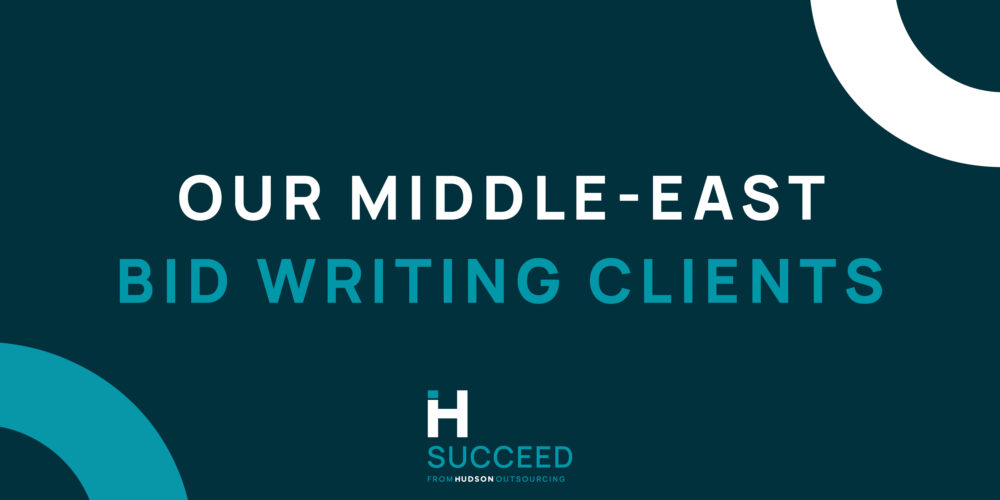
Our Global CEO visits Dubai to meet our Middle East Bid Writing Clients! Over the…

What recent changes have there been to procurement in Saudi Arabia? In recent years,…

What to know when bidding on government contracts across states? When your business bids on…

How can my US-based business secure government contracts in the Middle East? 5 key things…
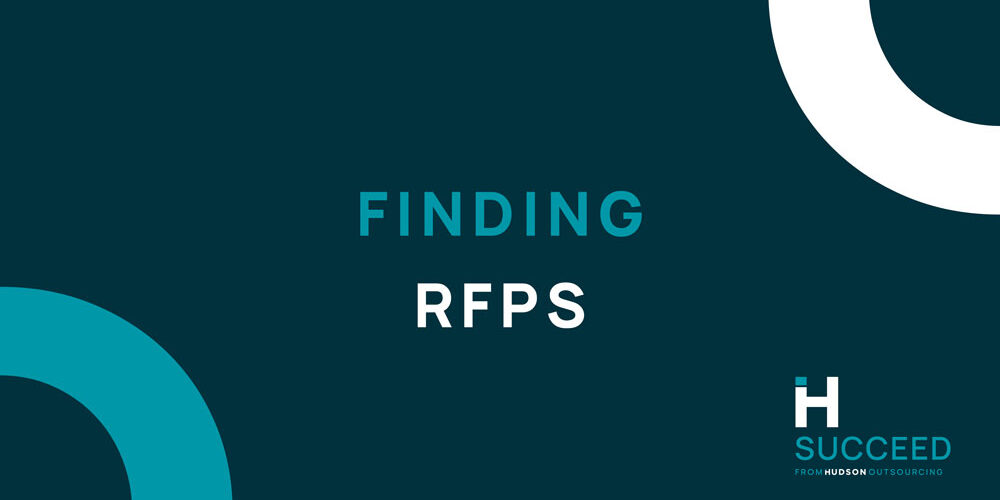
Finding RFPs Finding relevant RFPs can make all the difference to your growing organization. Whether…
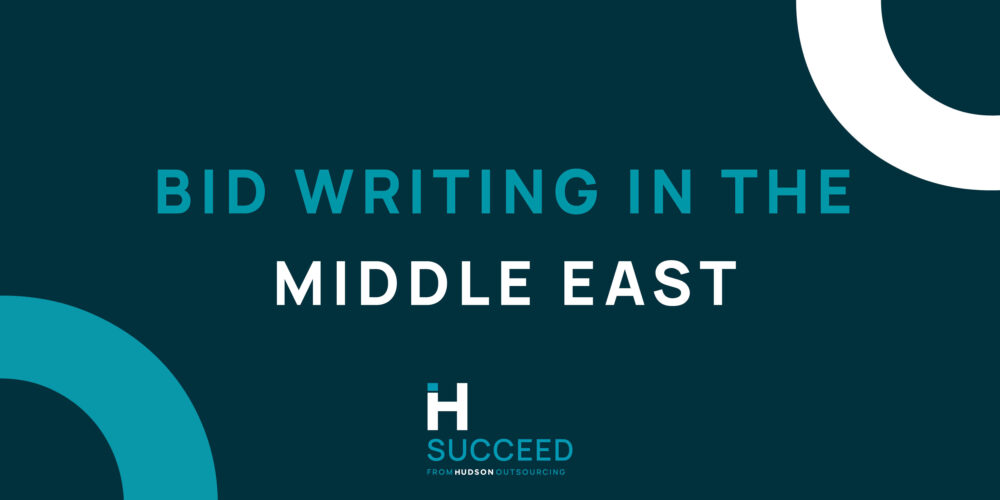
Bid Writing in the Middle East: How to win government contracts in UAE, Saudi Arabia…
Request a Callback
- Find More RFPs
- Bid Resources
- RFP Writing Testimonials
Privacy Overview

- Contract Management
Supplier Management
Savings Management
- Data & Security
FAQ’s
oboloo FAQ's
How to write a cover letter for rfp response.
Are you tired of submitting bland and generic proposals for Request for Proposals (RFPs)? Do you want to stand out from the competition and increase your chances of winning that lucrative contract? Look no further than a well-written cover letter. In this blog post , we will guide you through the step-by-step process of crafting a compelling cover letter that showcases your expertise, highlights your unique value proposition, and captivates the reader’s attention. Whether you are new to RFP responses or looking to refine your skills, our tips and tricks will help you master the art of writing an effective cover letter. Let’s dive in!
What is an RFP?
When submitting an RFP response , you’ll need to cover all the bases. Follow these tips for writing a great cover letter for an RFP response:
1. Begin by introducing yourself and your company. Let the reader know what type of business you’re in and why they should care about your response.
2. Explain how your skills and experience match up with the needs of the organization, and why you’re the best candidate for the job.
3. Share examples of your work – highlight any awards or accolades that may have come your way. This will show that you are qualified and deserving of consideration.
4. Summarize your qualifications in one or two sentences, emphasizing anything that makes you stand out from other applicants.
5. End with a persuasive statement – explain how working with you would be a good fit for the organization, and why they should choose you over others.
What are the different components of an RFP?
When submitting an RFP, there are a few important components that should be included: the RFP itself, the cover letter accompanying it, and the response. The RFP should be easy to read and understand and include all of the necessary information for awarding the contract.
The cover letter should provide specific information about why the company is interested in contracting with the respondent and what skills or experience they have that would make them a good fit for the project. It is also important to highlight any relevant experience or connections that the respondent may have within the industry.
The response must present detailed information about how applicant would meet all of the qualifications outlined in the RFP and should also include any relevant references. If applicable, it is also helpful to include a proposal outlining how applicant would carry out the project if awarded it.
How to write a cover letter for an RFP?
To write a cover letter for an RFP response, be sure to address the following points:
1) Introduce yourself 2) Explain what motivated you to respond to the RFP 3) State your qualifications and why you believe you would be a good fit for the position 4) Share any relevant experience or information about the company or product 5) Summarize your strengths and how those skills would benefit the company
Writing a cover letter for a Request for Proposal (RFP) is an important part of the job process. By following these tips, you can ensure that your cover letter is both well-written and persuasive. Whether you are applying for a new position or trying to showcase your skills to an existing one, a well-crafted cover letter will go a long way in getting you the promotion or job you desire. Thanks for reading!
Want to find out more about procurement?
Access more blogs, articles and FAQ's relating to procurement
The smarter way to have full visibility & control of your suppliers
Contract Management
Partnerships
Charities/Non-Profits
Service Status
Release Notes
Feel free to contact us here. Our support team will get back to you as soon as possible
Sustainability
- Product Overview
- Sales Teams
- Product Marketing
- Proposal Managers
- IT Security
- Startup Founders
- Finance Professionals
- RFPs and RFIs
- Security Questionnaires
- Due Diligence Questionnaires
- RFP: The Complete Guide to Request for Proposal
- RFP Response Automation
- 20 RFP Response Examples & Strategies
- Ultimate Guide to Sales Ops
- Presales for Boosting Sales Success
- Guide: Security Questionnaires for IT Buyers and Vendors
- RFP Response Guides Galore!
- Glossary of Sales Terms
January 17, 2024 3:40 pm
4 Tips to Master the RFP Cover Letter
Do you remember when you were in school, and you had to write an essay? If your experience mirrors mine, you had teacher after teacher hammer home the same point – the first paragraph is critically important. After all, it’s the first thing that the reader sees.
In the world of proposals, the RFP cover letter (also called a proposal cover letter, RFP response cover letter, bid proposal cover letter, RFP cover page, cover page for business proposal, etc.) is the first thing that the buyer sees. For all the time that companies spend crafting proposals, it’s surprising that the RFP cover letter is often an afterthought, rambling corporate pablum. But for you, dear reader, this presents an opportunity….
In the paragraphs that follow, you will learn
- What is an RFP cover letter?
- The value of an proposal cover letter.
- The components of an RFP cover letter.
- The best approach to a proposal cover letter.
Read on and find out how investing time in your RFP cover letter can boost your chance at a winning RFP response !
Don't have time to read the whole article? Here are the key elements of an RFP cover letter.
Take Notes : Keep good notes when reading the RFP, keeping in mind that you want to reflect the pain and goals back to the issuer in the cover letter. The RFP itself is the roadmap to best understanding the issuer's desires.
Start Strong: Consider playing up the pain of the pre-solution state and/or describe the positive outcome of a successful partnership. By reminding them of the issue they're trying to solve and its negative impact, you can increase the emotional resonance of your messaging.
Address Concerns: The RFP cover letter gives you, anticipate and address potential buyer concerns like your firm's size or lack of specific experience. Reframe these weaknesses as strengths: highlight past successes with similar clients or emphasize personal attention from your smaller team. Don't excuse, recast!
Run Through the Tape: A killer RFP cover letter finale reignites the problem you solve, extends a confident invitation for further discussion, and shines with genuine passion for your solution. This powerful combo leaves a lasting impression that speaks to their needs and sparks excitement for what you offer.
We go into greater detail about these specific tips later in the article. Keep reading to learn more!
What is an RFP Cover Letter?
Let’s begin by understanding what an RFP cover letter isn’t. It is not a multi-page document where you meticulously lay out your bid details, expound at length on the value of your product or service, and include matrix-style comparisons. Instead, your RFP cover letter should be a single page and addressed – yes, actually addressed as it is a letter after all – to the prospective customer. It should contain high-level, rather than super-detailed information, but still be customized for the recipient. The proposal cover letter is the first page in your submission and should be followed the rest of the proposal.
That’s it. And if you’re wondering why you’re reading an article that is longer than any good RFP cover letter should be, I want to remind you about where we started and think back to the intro paragraph to an essay that grabs the reader’s attention and sets the tone for the rest of the paper. This is your first and best chance to captivate your prospect.
The Value of a Proposal Cover Letter
You’ve poured hours (32 on average) into developing the perfect proposal, meticulously answering every RFP requirement. So, at this point, you simply want to call it a day. After all, who wants to spend one more minute working on a brief introduction? The best sales executives and proposal writers realize that like sprinters, they need to run though the tape. The race isn’t over when the proposal is written. You have an opportunity to stand out from the crowd before your prospect even gets to the meat of your proposal.
Let's be honest, most cover letters fall into the " Dear Sir/Madam " black hole. "Thank you for the opportunity, blah blah blah..." <Yawn> Your letter? It's the first handshake, where you look the counterparty in the eye and introduce yourself. This isn't just about meeting specs; it's about leaning into to authenticity and igniting excitement. Why did the prospect issue the RFP to you? There is a problem or need that your company is qualified to address.
A generic greeting, an RFP cover letter than reads like boilerplate, can undermine even a strong proposal. I get it; no one gets excited about responding to an RFP. But you’re close to the finish line and surely you can get excited about winning the business. Before we get into the contents of an RFP cover letter, here are three things to keep in mind when crafting your killer cover letter:
- Lead with authenticity. Your company may be providing the product or service, but the prospect is buying from you . Put a little personality into it.
- Connect to the pain/need. Whatever it is that you’re proposing should solve a problem for the prospect. Reiterate the problem in your own words to frame the rest of the proposal.
- Don’t oversell features and capabilities. Remember, this is just the first page of a proposal. The proposal itself is where you’ll have ample space to explain why your solution should be the winning one.
The Components of an RFP Cover Letter
Odds are that you’ve applied to a job and submitted a resume along with a cover letter. Unsurprisingly, there is a lot you can apply from a resume cover letter to an RFP cover letter. The major difference is that you’re representing your rather than yourself.
When drafting an RFP cover letter, you want to be sure to include the following:
- Addresses and date: You cover letter is, at its heart, a business letter. Make sure that it’s formatted as such and include the names of the key stakeholders as well as the physical address – even if you send it via email. You might be thinking, “Duh,” but a surprising number of people miss this and it conveys a lack of professionalism.
- Brief greeting: It’s enough to spend a sentence or two telling the recipients that you enjoyed meeting them and appreciate the opportunity to earn their business. Space is limited so you don’t want to invest too much here.
- Recap needs/pain: This is the first part of the aforementioned framing. You are going to restate the buyer’s needs in your own words. Lean into the “pain” if you can do so subtly.
- Summarize your value proposition: Again, this is the RFP cover letter, not the proposal itself. You want to briefly explain why your solution is a perfect fit for the buyer. If possible, cite other success stories and spell out areas of differentiation from competitors.
- Close: You can thank them again, invite them to send you questions, etc. But aside from that, just make it short and sweet.
Some suggest including visual design elements. Given the limited space you have (we’re not kidding about the 1-page rule), you are generally going to be better off not using them unless they are going to make a huge impact on your narrative.
As you write, remember that the prospect is, at least for the moment, the center of the universe . All of the things that you highlight that made your company special should apply specifically to the prospect. If you have offer X and Y and offer the world’s best X, it’s not worth mentioning if the buyer only wants Y. There are ample opportunities in the rest of the proposal for this kind of information.

The Best Approach to a Proposal Cover Letter
Every time you respond to an RFP, you are building a bespoke piece of content. It doesn't matter if you've received RFPs that were almost identical. We encourage you to incorporate elements of previous responses, particularly if they are successful. But it's important to bear in mind that regardless of the similarities when it comes to requirements, budgets, et al., the issuer of the RFP has its own concerns. Consequently, your RFP cover letter should speak specifically to that issuer. In this section, we'll cover key tips on how best to do that.
Take Notes When You Read the RFP
The person who writes the cover letter should be involved in the proposal process and certainly should have read the RFP. I’m not suggesting that this person re-read the entire thing, but rather take notes while doing the initial reading. This is an important step anyway as you want to track the requirements, nice-to-haves, identify areas where your solution provides differentiated value, etc.
The only difference is considering the cover letter while you are reading the RFP and taking those notes. You’ll want to keep your eyes open for a few things:
- Are there any specific things that come up repeatedly? Maybe there is an aggressive timeline, a budget constraint, or a usability concern. This is something you’ll certainly want to address in a cover letter.
- What is driving the initiative? Or put differently, what is the big honking problem that prompted an RFP in the first place? Be warned – this might not be explicitly detailed in the RFP itself. If that’s the case, you might consider reaching out to the buyer and inquiring. The answer will not just improve your RFP cover letter but could improve the proposal itself.
- What is the desired end state? If you can put the reader in a place where he or she feels psychologically comfortable, you could find yourself one step ahead of the competition.
Get to the Good Stuff Quickly
Odds are that you are not the only proposal that has landed in the issuer’s inbox. And while you aren’t asking for much time here – remember, the RFP cover letter should be limited to one (1) page – there is a strong possibility that there is more skimming than reading. This doesn’t mean that the cover letter isn’t important! But what it does mean is that you want to grab the reader’s attention immediately. You do this by putting your hook in the very first paragraph.
There are numerous ways to do this. A few ideas include
- Starting at the end. What? Specifically, describing the end state of a successful engagement in the beginning of the RFP cover letter. If you can get the reader feeling warm and fuzzy early on, that’s a win.
- Lean into the pain. An organization develops an RFP when they want to spend money to address a specific issue. What is that issue? How does the fact that the issue is unaddressed negatively impact the current state? Warm and fuzzy has its benefits, but turning up the pain is another approach that is often employed by successful salespeople.
- Remind them who you are. In some situations, you might receive an RFP from a buyer with whom you have previously developed a professional relationship. You should absolutely incorporate this into your cover letter, particularly highlighting past successes together. Positive experiences can sway buyers by adding a measure of emotional safety to an uncertain process. “I feel comfortable working with this person/company,” is a compelling sentiment.
Confront Your Weak Points
The RFP Response itself is going to provide a ton of detail about what your company does, how it does it, prior success having done it, etc. In terms of how you would provide a solution, it might be comprehensive. But it may not touch some of the points that could give a buyer pause.
When dealing with prospects that resemble the organization that issued the RFP, what are the concerns that they have? This is your opportunity to take control of the narrative around those concerns. Here are a couple examples:
Concern: “We’re concerned that you’re not large enough to take on this project.”
Answer approach: Discuss how you’ve worked with companies that are as large or larger, if possible. You can also turn your smaller size into an advantage by promising more executive attention and engagement as a deal with your smaller company would be relatively more impactful than it would be for a larger company.
Concern: “You don’t seem to have done a project like this before.”
Answer approach: Discuss your successes taking on other projects that seemed to be outside your core area of expertise. See if you can find alignment between your company’s vision and the project.
Remember, the goal here isn’t to excuse yourself, but rather to recast your perceived weakness as a strength. For example, as it pertains to the size concern, you don’t want to write, “Even though we’re a small company, we are confident that we can deliver on time and on budget.” Rather, you might write something like, “As a smaller provider, we are able to cultivate much more intimate relationships with our customers, which ultimately leads to better outcomes. I would be happy to connect you with some of them to learn how.”
Close Strong
If you've done all of the above, you should make sure you're like a sprinter and run through the tape. The finish line is so close, it might be tempting to just downplay the ending of the RFP cover letter. That would be a mistake. Just as hooking the reader early increases engagement, closing strongly can have a meaningful impact. This is your chance to cement a lasting impression and reinforce the value you bring.
- Reignite the spark: Don't let the momentum fade. Briefly reiterate the core problem you address and remind the reader how your solution ignites their desired outcome. Use strong verbs and specific details from the proposal to paint a vivid picture of their success. This final punch reminds them why your offer is worth serious consideration.
- Extend the invitation: Make it clear you're eager to dive deeper. Whether you suggest a specific follow-up action, like scheduling a meeting, or simply express your availability for further discussion, project confidence and enthusiasm. Use active language like "We welcome the opportunity to discuss this further" or "We're confident our proposal can propel you towards..." This confident call to action leaves the reader with a clear next step and fuels their next move.
- Let your passion shine: Genuine excitement about your solution is contagious. Infuse your closing with an authentic spirit that reflects your team's dedication and belief in the project's success. This human touch builds trust and sets you apart from generic proposals.
Remember, a strong closing isn't just about summarizing, it's about sealing the deal. By reigniting excitement and providing a smooth transition to the next stage, you'll leave a lasting impression that sets your proposal apart.
It would be folly to think that the RFP response and the RFP cover letter are equally weighted. The response is clearly more important. But the cover letter serves as an appetizer in advance of the main course. Go to a good restaurant and a people may rave about the amazing appetizers. They'll still order the entree, but the appetizer sets the tone.
Given the time you'll invest in drafting your proposal (a time that can be dramatically shortened with an AI RFP strategy and specifically an AI application for RFPs ), it's worth being thoughtful in writing your cover letter. Every little bit helps.
Answer RFPs in minutes!
Sign up for Vendorful's AI Assistant for free.
About the Author
David Wadler
David Wadler is a co-founder and Chief Revenue Officer at Vendorful. Prior to Vendorful, he was the General Manager for Rich Media & Cloud at Lexmark Enterprise Software, where he was responsible for strategic direction of Lexmark’s initiatives as they related to rich media and cloud products. He came to Lexmark in 2013 with the acquisition of Twistage, where he was a co-founder and CEO. Prior to Twistage, he worked in a variety of industries and roles while trying to figure out what he was supposed to do with himself. David is a holder of a degree in economics from Brown University and is a resident of New York City.

Automated page speed optimizations for fast site performance
- Get started
Tips of the trade
How to Create a Standout RFP Response
Learn how to craft an RFP response that will catch the requester’s attention and win their business.
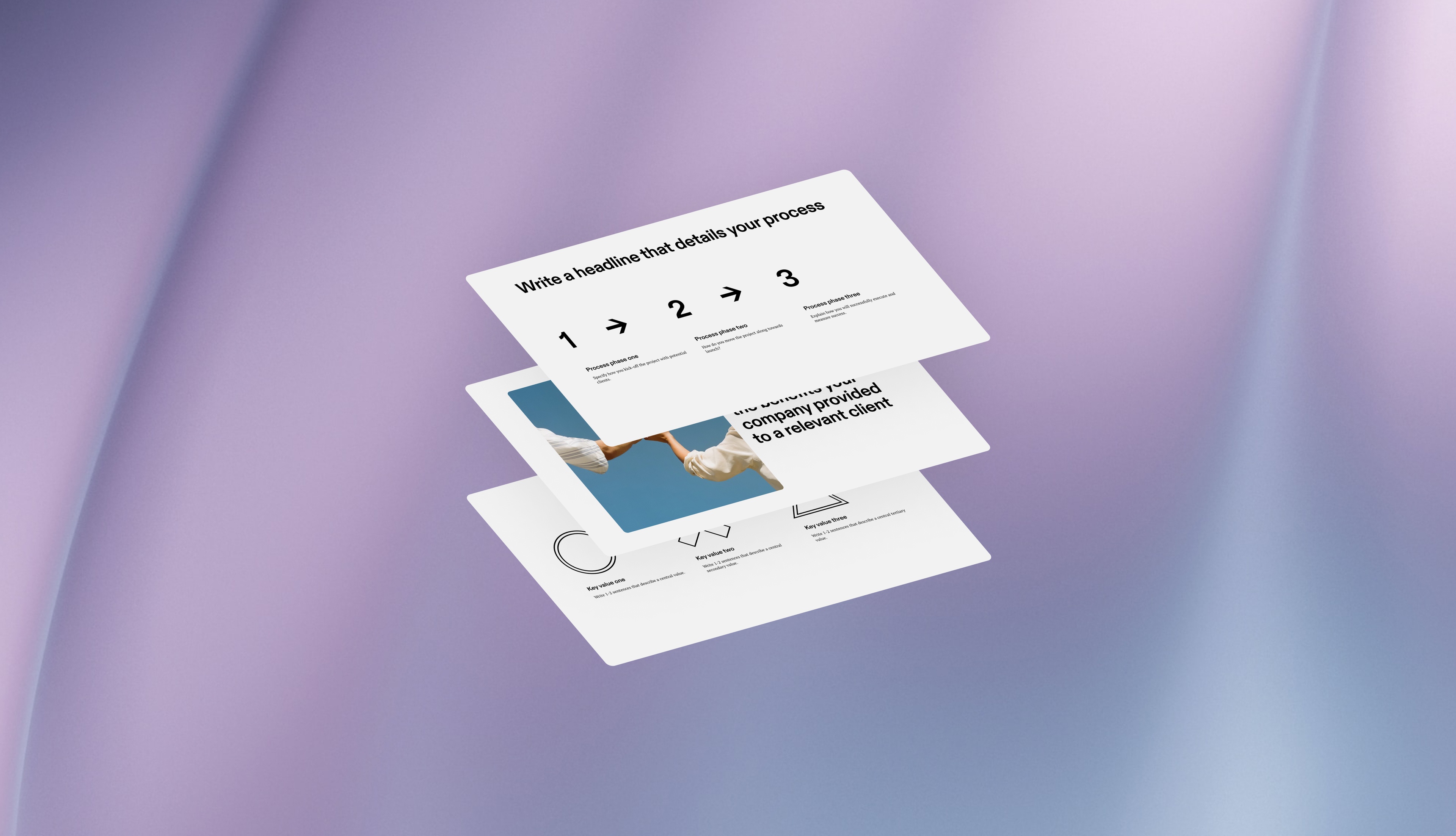
You know your team is great at what you do. You have the chops, the experience, and the enthusiasm. You’re confident you’d deliver great work on a project.
But first, you have to convince the client.
How do you do it? In various industries, companies will issue a Request for Proposal (RFP) when they have a need. It’s a formal document that details their project and invites potential service providers or vendors to submit proposals for solutions.
Winning that business means writing a successful response to the RFP: one that makes your company stand out, shows that you understand the challenge, and highlights why you’re a good fit.
What is an RFP response?
An RFP response is a document that a vendor or service provider prepares in response to an RFP. It’s a comprehensive proposal that outlines how the supplier’s product or service can successfully meet the requester’s needs.
An RFP is a structured way to gather information from various suppliers and compare offerings. Successful RFP responses present information in a corresponding fashion. Typically, they include information like proposed solutions and deliverables, the thinking behind the strategy, pricing, and details about your company including past experience. The ability to effectively write an RFP response is crucial to show you truly understand the client’s needs and can deliver valuable solutions to solve their problem.
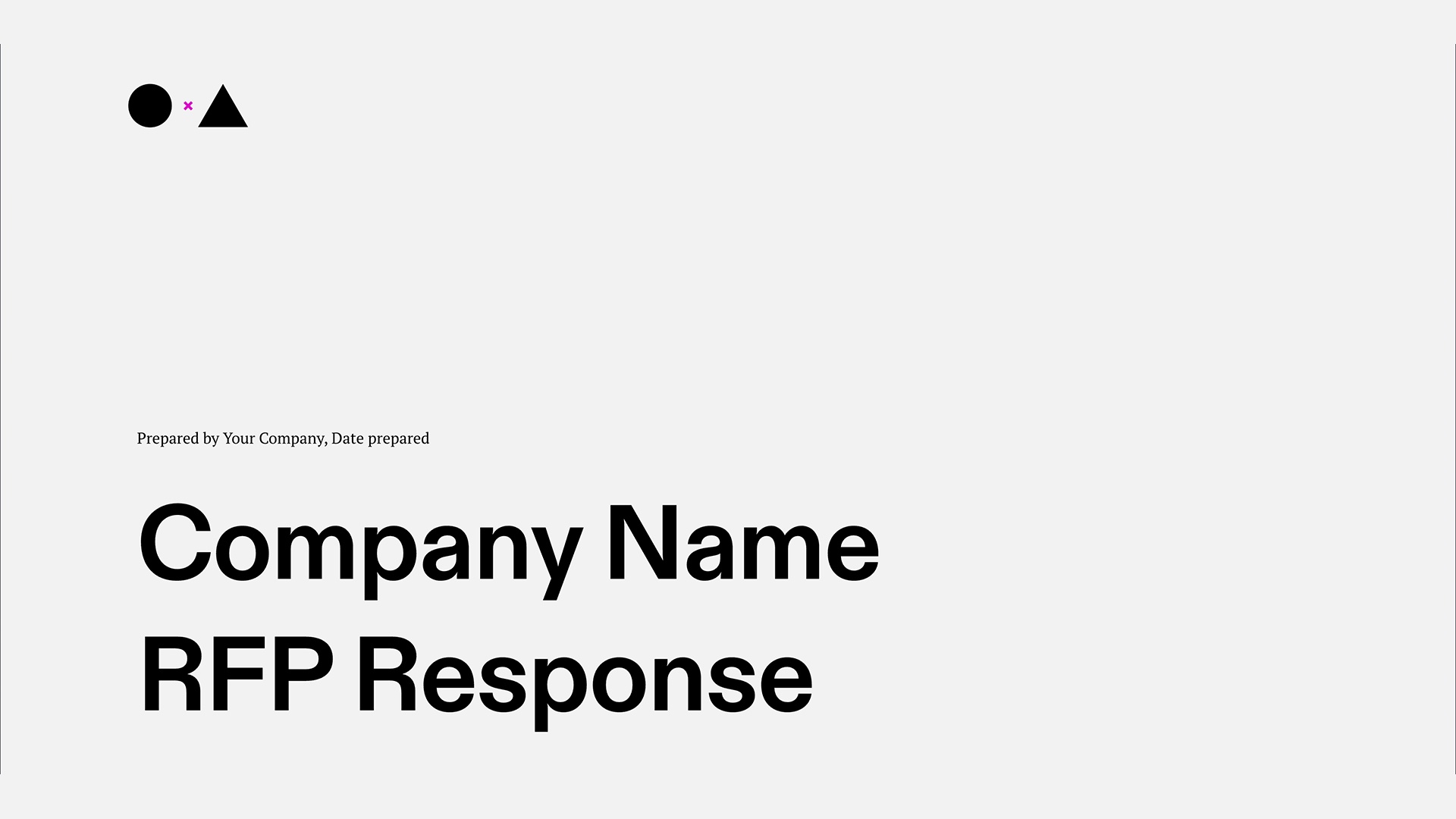
Try this tome:
RFP Response
How to structure an rfp response.
A wide variety of sectors use requests for proposals, so projects could include items like software development, marketing services, construction, information technology, website creation, and much more.
While each requester may ask you to respond to an RFP in a different way, speaking broadly, many RFPs seek similar information and structure. You should expect to include the following nine key sections in any RFP response:
- Introductory letter
- Table of contents
- Executive summary
- Solution, process, and deliverables
1. Cover page
The cover page of your RFP response serves as your first impression. It should reflect your brand identity with your firm’s style, color, and logo, and it should also include the logo of your prospective client.

2. Introductory letter
Just like a cover letter for an individual job application, RFP response cover letters are typically letters addressed to the RFP requester and signed by you.
Successful letters are centered on your potential client: proving that you deeply understand their needs and project requirements, showing your company is experienced and uniquely suited to serve them, and sharing at a high level how you’ll help them reach their goals. Tonally, think friendly, confident, professional, and enthusiastic.
Add your branding—including your company name and logo, as well as your contact information—at the top of this and every page, as requesters are often reading through a stack of responses.
3. Table of contents
Give your reader a very brief overview of the sections to come, including the page numbers, so they can easily navigate the document.
4. Executive summary
Write a concise summary of your RFP response. Successful executive summaries stay focused on the RFP’s specifications, recap the problem your client is trying to solve, highlight the key points of why your company and solution are the best fit for those s needs, and emphasize your unique value proposition. Consider the format, too: bullet points and bold lead-ins allow easy scanning, for example.
5. Solution, process, and deliverables
This is the meat of your RFP response, detailing your approach, specific solutions, process, and deliverables.
First, present your overall approach to the project—the strategy that will guide your execution. What’s the creative through-line or unique lens you’ll bring to the client’s problem? A bold strategy statement can help you differentiate from other RFP respondents.
Next, list your solutions, each under their own header. Depending on the proposal, these header categories might be something like “Phase 1, Phase 2, and Phase 3” for a project that unfolds over time, or “Creative, Email, and Social” for a marketing campaign.
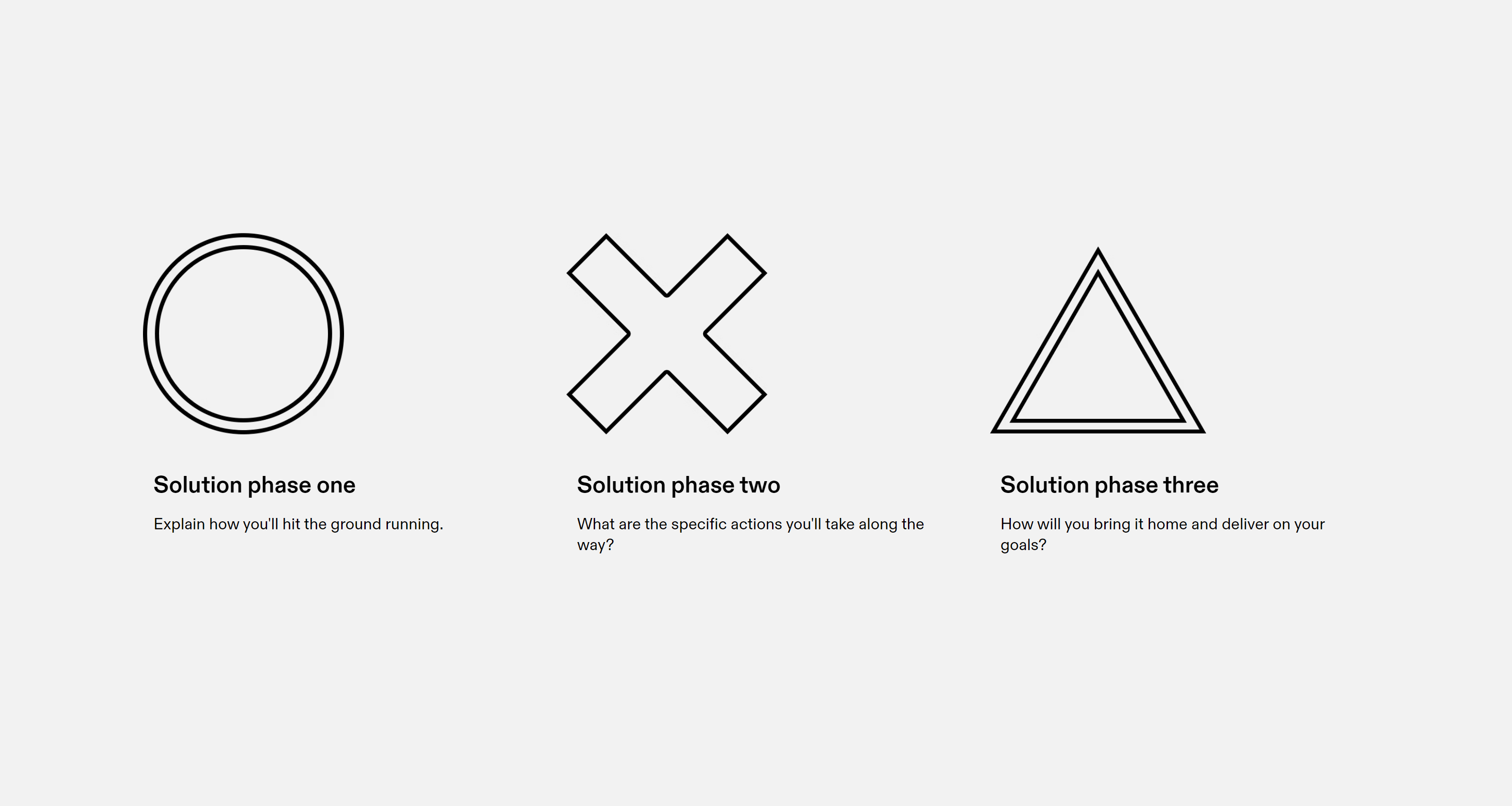
After that, explain your process: Describe what you’ll do as part of each solution, and be sure to explain why and how you believe these actions will help the client solve their problem. Call back to specific verbiage in the RFP as you concisely discuss the benefits and features of your solutions, explaining why they will address the client’s needs. Remember that the focus should always remain on the specifications in the RFP and the prospective client.
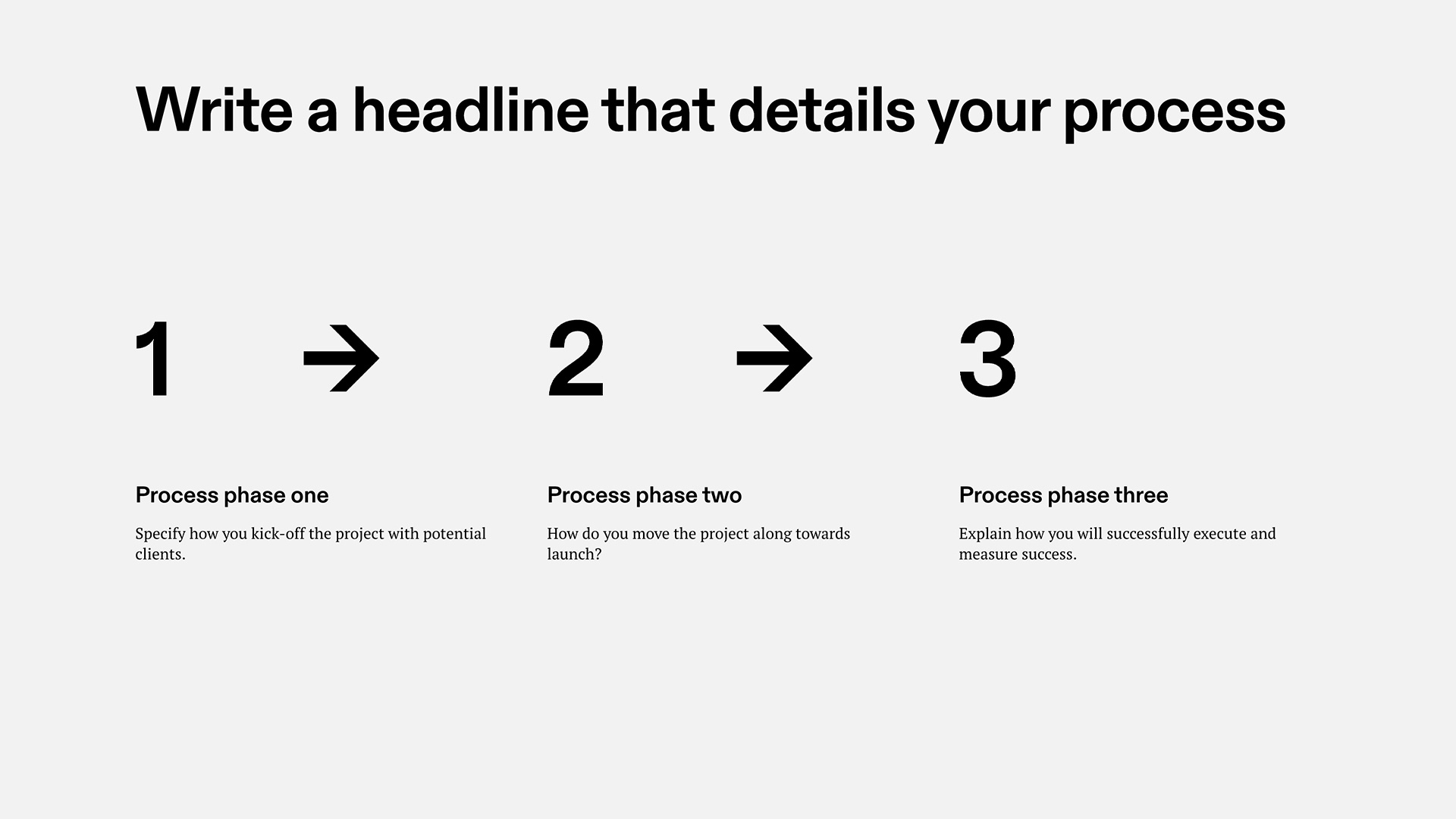
Visuals like charts or mockups can also help illustrate complex ideas. Ideas for visuals include venues or previous setups for event RFPs, mockups for ad-creative RFPs, and type treatments that align with your brand identity and the project’s needs.
Finally, include a list of specific deliverables for each solution. Again here, bullet points or numbered lists are easy to scan—while also making clear what is not included. Depending on the RFP, some companies choose to include information like the start and completion dates for each deliverable, quantity (think X number of social posts), and the team members assigned.
Note: Save pricing details for the next section. Here, you want your reader to remain focused on your compelling strategy—which can help start making the sale before dollar signs even appear.
By the time your client gets to this section of the proposal, you’ve already explained your strategy and your plan to execute it. Now, explain what it costs.
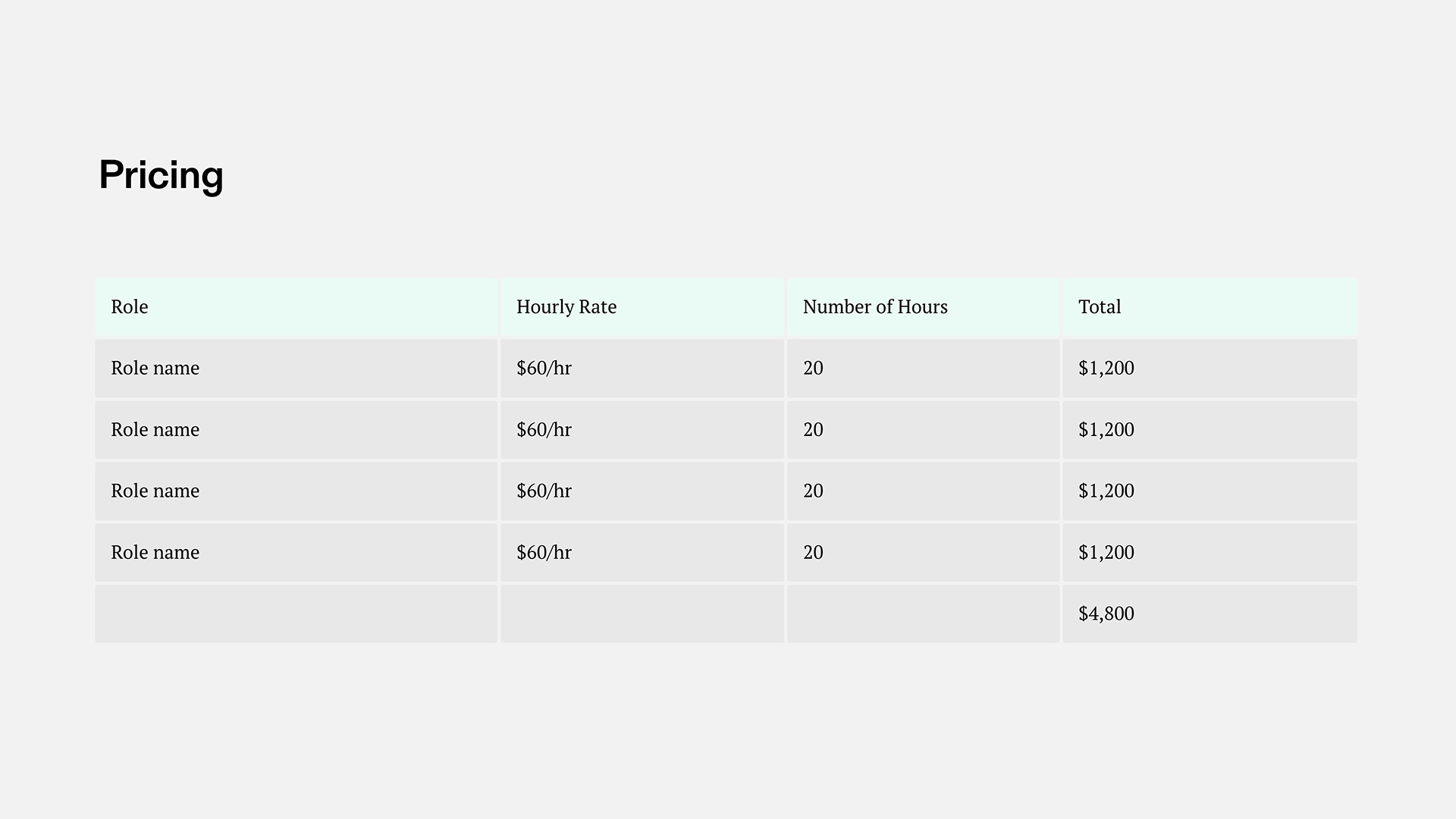
Your pricing section should clearly show the total cost of each solution. Depending on the specifics of the RFP and how you or your company works, you’ll either break that down by deliverable or by time spent.
List each of your solutions and their related deliverables or hours, with the rate and number of units for each. Then, add up the deliverables and provide a total for each solution. At the end, include a grand total for all solutions combined—the full cost of your plan, which should reflect the budget the client provided in the RFP.
Note: Avoid the temptation to offer a slew of plans, combinations, and options. You risk overwhelming the client by putting the onus on them, who is looking to you to present an informed strategy. Go in strong by providing a clear recommendation. Once you’ve attracted the client’s interest, you can make tweaks to solutions or packages later if needed.
7. About us
In this section, you’ll highlight your qualifications, philosophy, and relevant experience. Describe how your experience and skills directly relate to the project’s requirements and the client’s needs.
Start by briefly highlighting why your company’s unique benefits and solutions make you the right choice.

You may also include references, testimonials, or short case studies that underscore your company's successful track record. Choose clients and studies that are relevant to this project, and highlight specific impressive results as well as your clients’ satisfaction. Some companies also include brief bios for each team member who will be involved, which is an elegant way to name-drop previous clients and success stories throughout their careers.
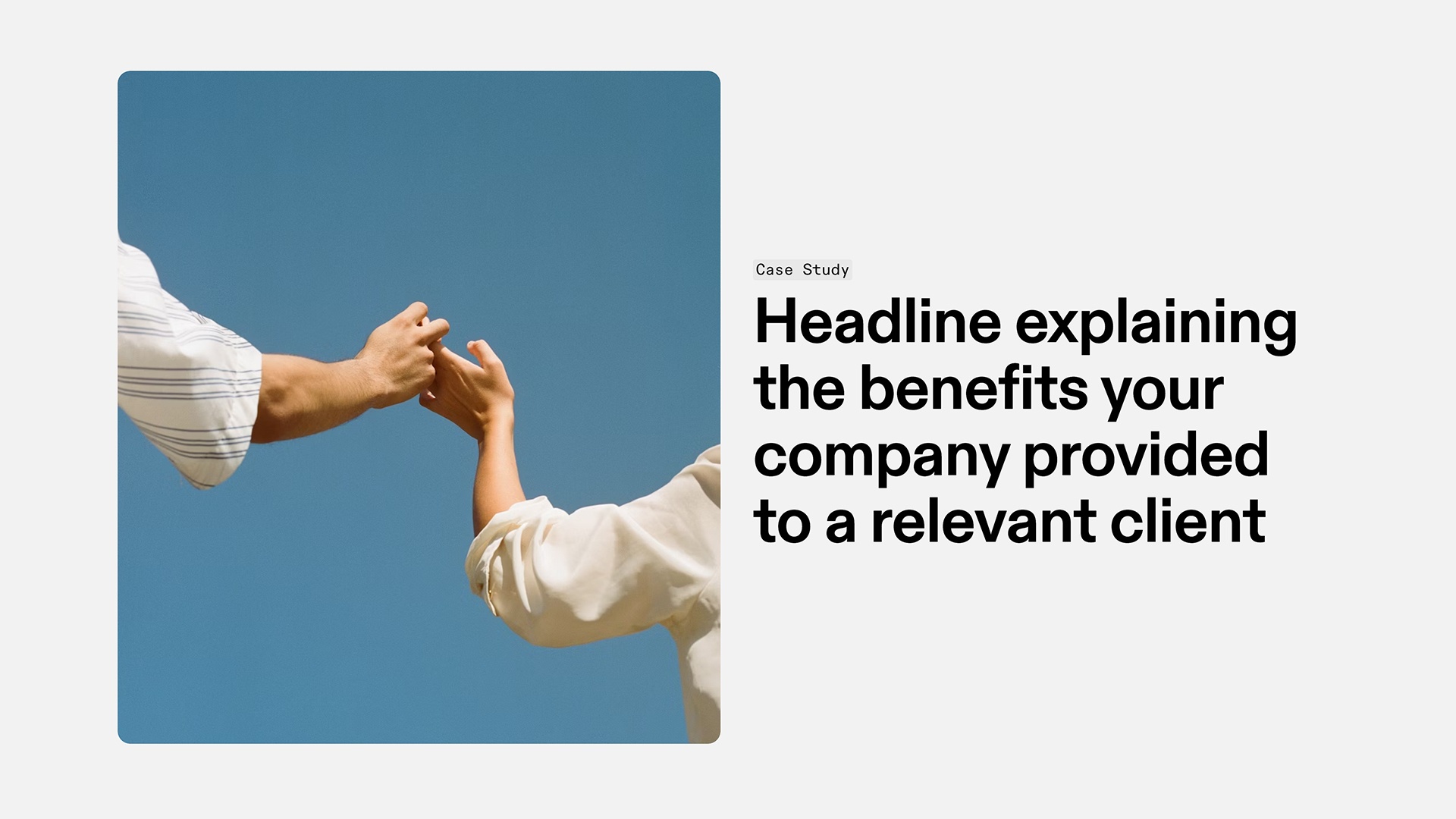
While some companies include this section earlier in their RFP responses, others prefer to focus first on how they can help the client—and go into more detail later once they’ve garnered interest based on their strategy. By placing this section at the end, you may give yourself a bit more space for information like case studies and team bios—rather than rushing through to get to the meat of your proposal.
8. Appendix (i.e. compliance statement, licenses, and any other related extras)
If needed, an appendix can serve as a sort of “miscellaneous” section. Depending on the type of RFP, some responses may require you to include proof of certifications, licenses, or other technical specifications. Others may benefit from inclusion of compliance statements around items like cybersecurity or personally identifiable information.
Avoid the temptation of going too long with the appendix, as it shouldn’t include any extraneous information. It simply serves as a catchall bucket for required or relevant information that doesn’t easily fit elsewhere.
After reading your compelling proposal, your reader may be ready to become your client. You may choose to include your boilerplate terms and conditions (which should align with industry standards and remain fair to both parties). In addition to project deliverables, pricing and scope, these terms may also include information about warranties, intellectual property, dispute resolution, and more.
4 tips for writing a winning RFP response
While every RFP is different, there are several “rules” that apply to writing successful responses. Here, two experts share their dos and don’ts.
1. Read the RFP very carefully, multiple times.
Quality RFP responses take work, and it would be a shame for your firm to be thrown into the “toss” pile because you missed a simple requirement.
“The good thing about RFPs is that they are generally extremely prescriptive—so the RFP will often tell you exactly how they would like you to structure your response and what to include,” says Anjie Zheng, Managing Editor of Strategic Proposals at a transit technology company.
That prescriptiveness is helpful—and consider it a mandate, not a friendly suggestion. If you fail to include requirements stated in the RFP, the requester may simply disqualify you in favor of other hopeful vendors who followed the directions.
“Read through the RFP several times, very carefully, to make sure you’ve checked every box,” Zheng says.
2. If you’re not sure, ask.
Still unclear on a point or two, even after multiple careful reads of the RFP? Don’t be afraid to ask one round of questions, says Michael Steele, Founder and CEO of technical marketing agency, Flywheel Digital .
“Don’t overwhelm the client, but it’s perfectly fine to get clarity on a few things to make sure you’re not leaving anything to chance,” Steele says. “If you do one thing and they meant another, you’re dead in the water. And if they balk at responding to questions or don’t give you helpful answers, it's a good indicator that they probably already have a specific vendor in mind anyway.”
“ If you do one thing and they meant another, you’re dead in the water. And if they balk at responding to questions or don’t give you helpful answers, it's a good indicator that they probably already have a specific vendor in mind anyway. ”

3. Use visuals and compelling language to keep your reader interested.
RFP responses tell a story, and you should avail yourself of any tactics you’d use in other formats to tell a good story.
“Think about RFP writing as you would think of any piece of content. Who's your target audience and what do they care about?” Zheng says. “Try to speak to them specifically by including information that you believe will be helpful and a tone of voice that’s appropriate.”
Think beyond text, too, she adds. Use diagrams, graphics, and other visuals to break up the text and draw your reader in—because giant, uninterrupted blocks of text can make a reader’s eyes glaze over.
4. Stay at the right altitude.
The requester wants to understand your company’s approach and why you’re the right vendor for the job. Yes, you should describe your strategies—but there’s no need to dive into the minutiae. In fact, getting too detailed in your response could hurt you.
“You run the risk of one person reading it and saying, ‘Oh, I don’t like that particular plugin, so maybe they’re not a good fit,’” Steele says. “People get caught up in those details sometimes, even though they’re easily changed. So stay focused on the overall picture: your approach and why you're the right partner.”
Using Tome to create RFP responses
Your style is dynamic—and your RFP responses should be, too. Tome’s impressive RFP template is designed to spotlight the solutions you bring. Follow the guidelines to create a persuasive cover letter that unites your values with the potential client’s. Break your process down into phases, and utilize the ability to insert a timeline or Gantt chart hosted on a different website, like Miro.
Tome’s generative AI helps you get to a first draft faster—create pages, text blocks, and visuals in seconds with prompts. Get a result that’s optimized for any screen size and immersive like an Instagram Story. Explore more of Tome's features and sign up for free.

Submit bids faster and help prospects see why you’re the right business choice.
You may also like...
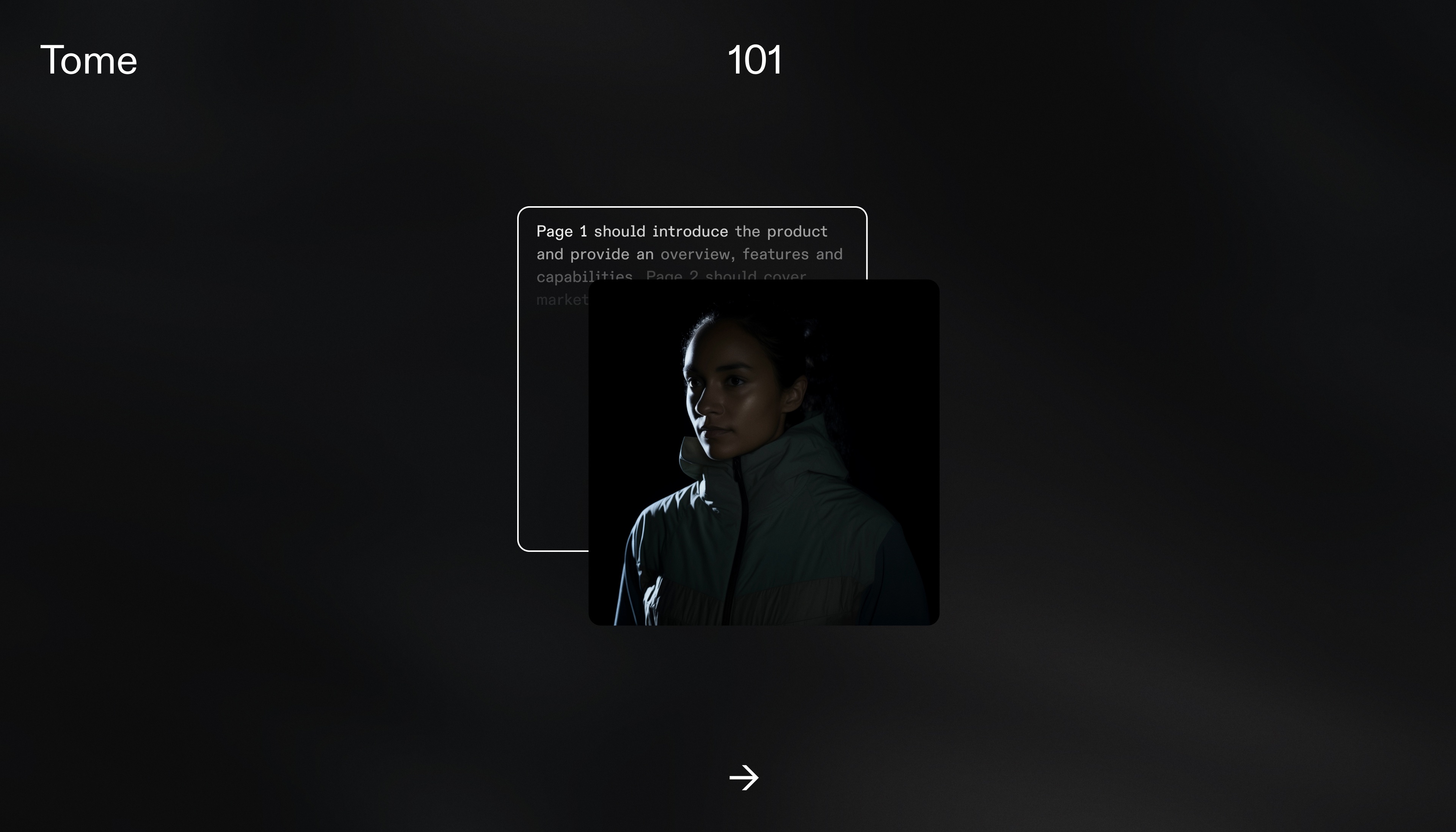
Tome for Founders: Key features, AI tips & real-world examples
All the tips, templates and AI thought-starters that founders and entrepreneurs need to grow their business with Tome.
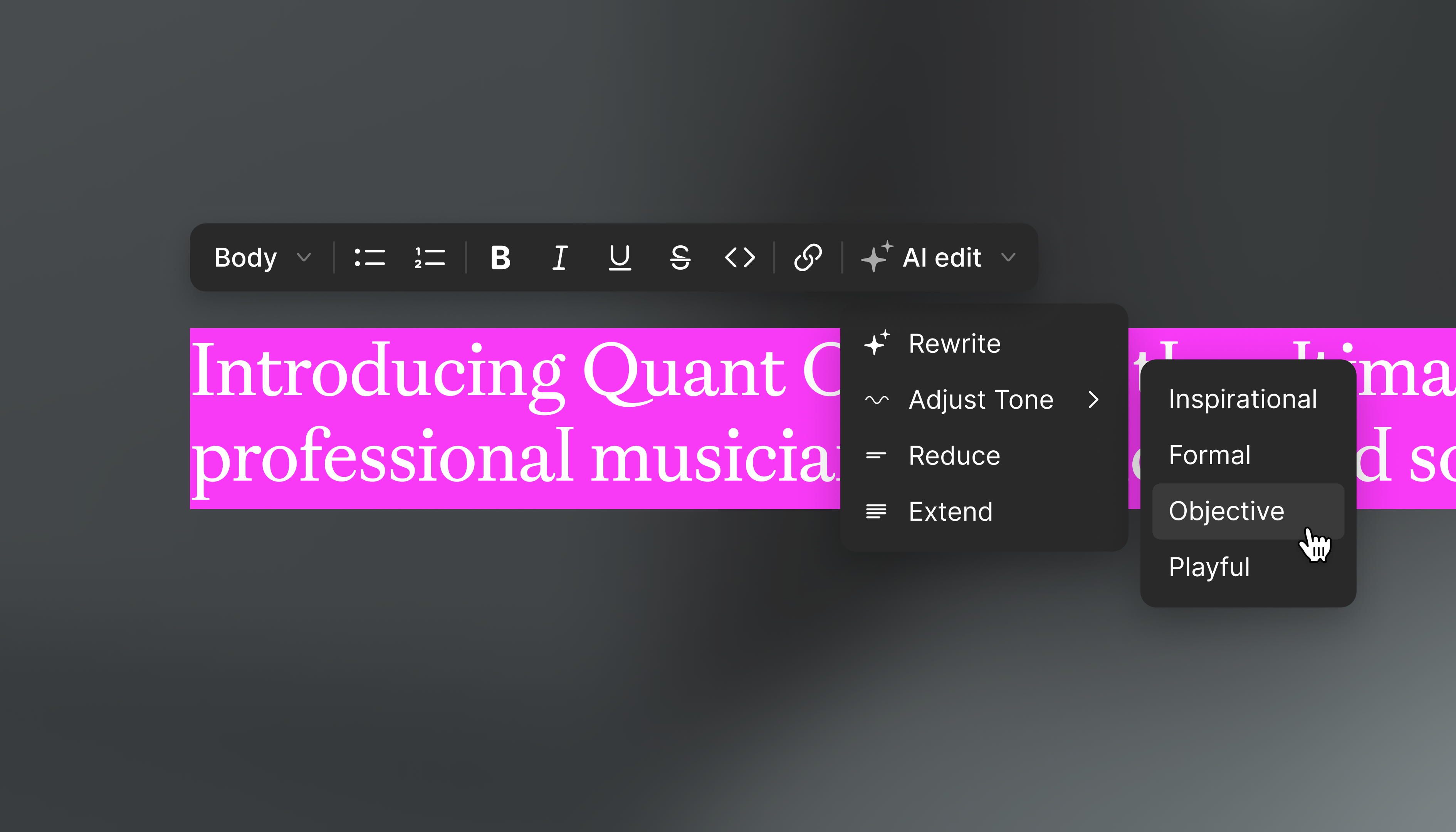
How Sales Leaders are Using Generative AI to Train Their Teams
Three popular ways to use AI in sales training, including materials creation, role-playing, and personalized coaching.
Craft your next great idea.
The RFP Response Formula That Gets an 80% Close Rate
Published: July 21, 2022
The opportunity to send a proposal can be exciting. Maybe you're exploring more work with an existing client. Or, perhaps you're responding to a request for proposal (RFP) .

If a current or potential client requests your proposal, you should consider the content of your RFP response as serious business. Because it probably means you're competing for your customer’s attention with other vendors who might have sent similar proposals.

For how time-sucking and frustrating proposal creation can be, your hopes of getting hired by a client are too often met with disappointment. So, what'll make your proposal stick out? What will give your team a creative outlet and make a difference for your own growth goals ?
Jason Swenk , an entrepreneur, and former agency owner, recently discussed his formula for creating proposals that had an 80% close rate and led him to work with brands such as AT&T, Legal Zoom, and Hitachi at HubSpot's Partner Day. Here are his steps for creating a killer proposal.
Table of Contents
How to Respond to an RFP
- Free RFP Response Template
RFP Response Examples
- Tips for Winning More Proposals
- Carefully review the RFP to understand what the client wants.
- Determine the deliverables with your team to determine whether your company can meet them.
- Create a draft using answers and insights from your team.
- Distribute the draft among the team.
- Edit the draft and use clear, concise language.
- Submit your final proposal to the client.
1. Carefully review the RFP to understand what the client wants.
When you receive an RFP, the first thing to do is carefully review it to understand what the client wants you to do. This first step will help you filter out projects that lie outside the scope of your organization or team.
2. Determine the deliverables with your team to determine whether your company can meet them.
Your team offers a fresh set of eyes that can help everyone get on the same page and determine whether the deliverables required can be completed by your organization.
3. Create a draft using answers and insights from your team
Before you create the proposal, it’s critical to determine whether the client is the right match for your services. Therefore, you should properly research the prospective client. Determine who they are, what their values are, their market, and what they’re all about.
It's also a good idea to request input and insights from the team. Combining your research with answers and insights from your team will help you to create a good first draft.
4. Distribute the draft among the team
Creating a great proposal requires having all the necessary information. Therefore, after creating the first draft, share it among the team for review and request their input on specific details.
5. Edit the draft and use clear, concise language.
Review and edit the draft and send out the final version for approval. Close the review and add finishing touches to the proposal.
6. Submit your final proposal to the client.
Finally, submit the finished proposal to the client and await their response.
With all that said, take a look at the six components Swenk says make for a proposal template that clients are more likely to respond to.
The RFP Response Template That Gets an 80% Close Rate
"It needs to be in a certain order, like a phone number," Swenk said. "You have to have the right order to reach the right person."
Take a look at the six elements you need to create the perfect RFP response, along with some abbreviated examples of the language you might use when drafting each element of your proposal.
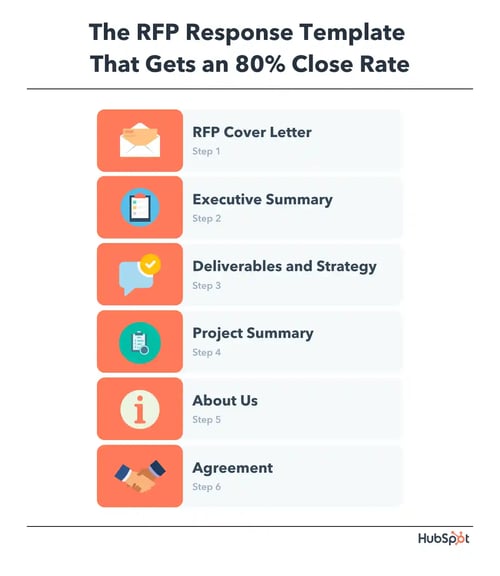
1. RFP Cover Letter
Don't just dive right into the strategy and the tactics. Set expectations upfront and entice the client to read more.
Think of the opening of your proposal or RFP response as the cover letter of a job application. It really is, after all; you want this company to hire your team, but they need a more digestible summary of what you'll offer them and why you think they'll benefit from working with you.
This cover letter gives them the proper context around who you are before reading about the services you intend to offer them. It also gives you the opportunity to remind them that they solicited the proposal they're about to read from you.
RFP Cover Letter Example
Dear [author of RFP]:
Regarding your request for proposal (RFP), [your company] is thrilled about the opportunity to provide you [type of service requested]. Having worked with [brief list of past clients], we believe a partnership with [company you're writing to] would have a tremendous impact on your customer satisfaction and bottom line.
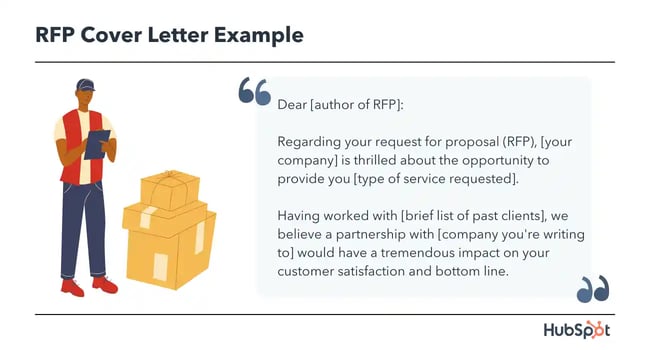
Don't just stop there. Follow the above introduction with a description of who you are, what qualifies you to work with the RFP's sender, and the benefits your potential client can expect to see as a result.
2. Executive Summary
The executive summary shouldn't just summarize what the proposal says. Instead, it should state what the prospect wants, where they want to go, and what they will need to get there. You will also want to cover the research you did, who you did interviews with, and the steps you took to pull together your recommendations. This document shows why the client should select your firm.
One important piece of advice from Swenk on the summary: State two obvious facts about the requester or the requester's needs up front. These should be things that the client knows are true. By doing this first, the reader will be more receptive to the remaining points. This isn't about tricking someone. It's about presenting the information in a way that prevents the client from becoming defensive when reading your recommendations.
Executive Summary Example
As one of [client's industry] leading providers of [client's main service], you know just how critical this time of year can be for your customers. On average, the cost to deliver is $[xxxx.xx], and [client name] is committed to "[client's mission statement]."
As these challenges become more common, it is increasingly important to provide customers with a solution that's driven by [your industry]'s latest knowledge and expertise. With this in mind, [your company] intends to help [client's name]:
- [Client benefit #1]
- [Client benefit #2]
- [Client benefit #3]
.png)
Free RFP Templates
Fill out the form to get these templates.
- One-Pager RFP
- Longer In-Depth RFP
- Designed PDF RFP
You're all set!
Click this link to access this resource at any time.
3. Deliverables and Strategy
This is the heart of your proposal document.
Categorize the proposal into different sections, such as creative, technology, etc. This will make it easy for the prospect to understand the different parts of the proposal and the different activities being recommended. In each section, you should list out the specific deliverables and also indicate what is not included. This last part helps to prevent scope creep from the beginning, and it also serves as an inspiration for clients who may want more.
Finally, don't include pricing in this section. It will stop people from absorbing the information, and it will prevent the reader from getting excited by the work you can do together. Instead, they'll just be thinking about dollar signs and their dwindling budget. Also, putting a price immediately prompts a person to begin comparing your pricing to another firm's price, no matter what the solution you are recommending actually includes.
Deliverables and Strategy Example
As stated in the executive summary, [your company] intends to help [client's name] [brief allusion to client benefits outlined in executive summary]. To do this, our team has outlined a proposed set of deliverables, an order of operations, division of labor, and expected dates of completion to ensure the partnership between [your company] and [client's name] is successful.
Throughout these operations, we expect your team to see heightened efficiency across your organization and progressively higher customer satisfaction over our [length of project or proposed contract] project. It's important to note, however, that the deliverables outlined below do not include:
- [Product/service not included]
4. Project Summary
After the Deliverables and Strategy document, you can then add an itemized list of all the deliverables and a price for each.
This isn't to give your client an option, where they cherry pick this and that and that and not this. The client wants a recommendation. You can't put the weight of the decision on their shoulders by asking them to choose between this package and that package. Give them a solid plan for what needs to be done and what it will cost them. Then, tailor the solution during a conversation.
Project Summary Example
[Your company] can't wait to work with you to help [client's name] in addressing [client's challenges described in Executive Summary]. To recap, please see below a brief overview of the services included in this partnership:
5. About Us
Save this part until the end. The client won't care about you until they know what you can do for them and their company.
The About Us section of your RFP response can be identical to the company description you likely created when starting your venture. As a general guideline, always open your About Us section with the name of your company. In the case of an RFP, keep in mind your potential client is receiving many responses at once, and it can be difficult to remember all the companies pitching to them.
6. Agreement
Lastly, include an agreement or contract in the proposal so that the client can sign as soon as possible. Don't make them ask you: where do I sign?
Oftentimes clients will flip directly to the agreement or contract section of your proposal, so make sure it's clearly labeled and the signature lines are visible at the bottom. After all, the signature of your client is some valuable ink to have ... you want to make their ability to provide it no less clear than the services you're offering them.
1. SaaS Services RFP Response
If you have a SaaS business model, you can look at this response example as a template.

[Your company] is thrilled about the opportunity to help you achieve [x goal]. Having worked with [previous companies you have worked with], we believe a partnership with [your company] would have a tremendous impact on your company’s overall productivity.
As one of the leading providers of [what your product achieves], you know just how critical this time of year can be for your industry.
As efficiency in [the challenge your SaaS product solves for companies] becomes more common, it is increasingly important to provide your company a solution that's driven by [your industry]'s latest knowledge and expertise. With this in mind, [your company] intends to help [client's name] with the following goals:
As stated in the executive summary, [your company] intends to help [client's name] [brief allusion to the benefits outlined in the executive summary]. To do this, our team has outlined a proposed set of deliverables, an order of operations, division of labor, and expected dates of completion to ensure the partnership between [your company] and [client's name] is successful.

2. Marketing Services RFP Response
If you are a marketing company, consider this template to start your RFP:
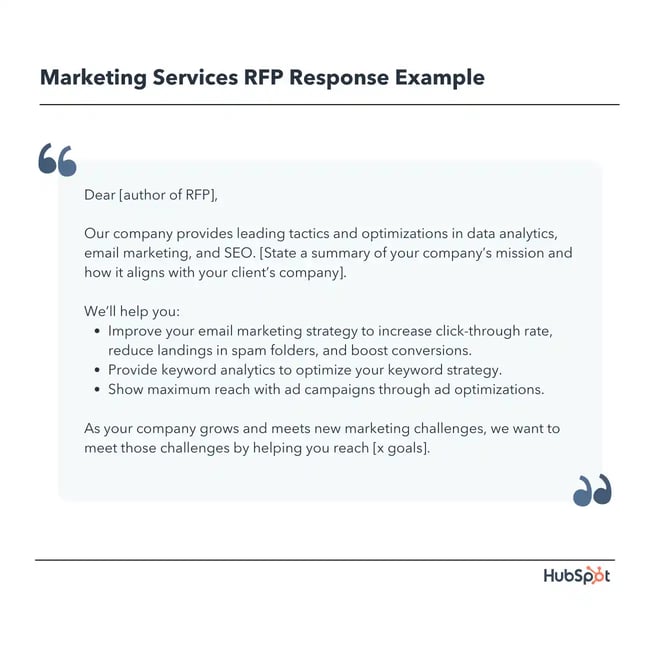
Dear [author of RFP],
Our company provides leading tactics and optimizations in data analytics, email marketing, and SEO. [State a summary of your company’s mission and how it aligns with your client’s company]. We’ll help you:
- Improve your email marketing strategy to increase click-through rate, reduce landings in spam folders, and boost conversions.
- Provide keyword analytics to optimize your keyword strategy.
- Show maximum reach with ad campaigns through ad optimizations.
As your company grows and meets new marketing challenges, we want to meet those challenges by helping you reach [x goals].
3. Coaching Services RFP Response
If you offer coaching services, consider this as a template for your RFP response:
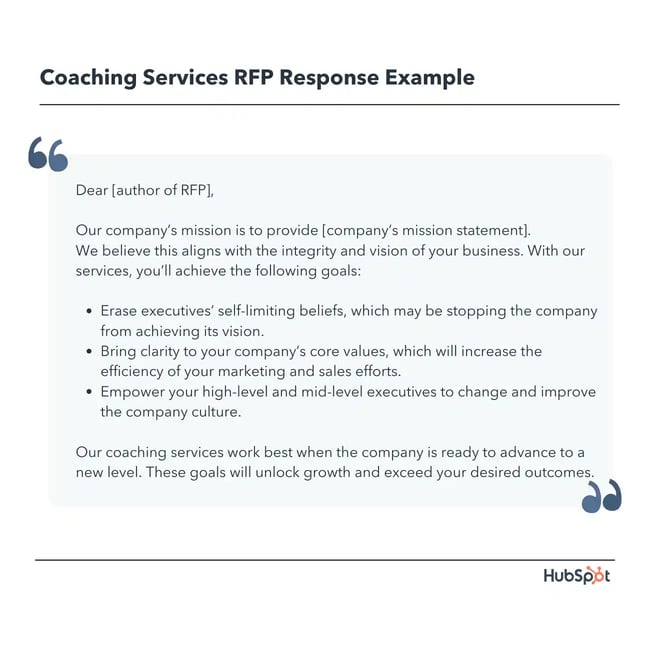
Our company’s mission is to provide [company’s mission statement].
We believe this aligns with the integrity and vision of your business. With our services, you’ll achieve the following goals:
- Erase executives’ self-limiting beliefs, which may be stopping the company from achieving its vision.
- Bring clarity to your company’s core values, which will increase the efficiency of your marketing and sales efforts.
- Empower your high-level and mid-level executives to change and improve the company culture.
Our coaching services work best when the company is ready to advance to a new level. These goals will unlock growth and exceed your desired outcomes.
4. Training Services RFP Response
If you offer training services, consider this template as an RFP response:
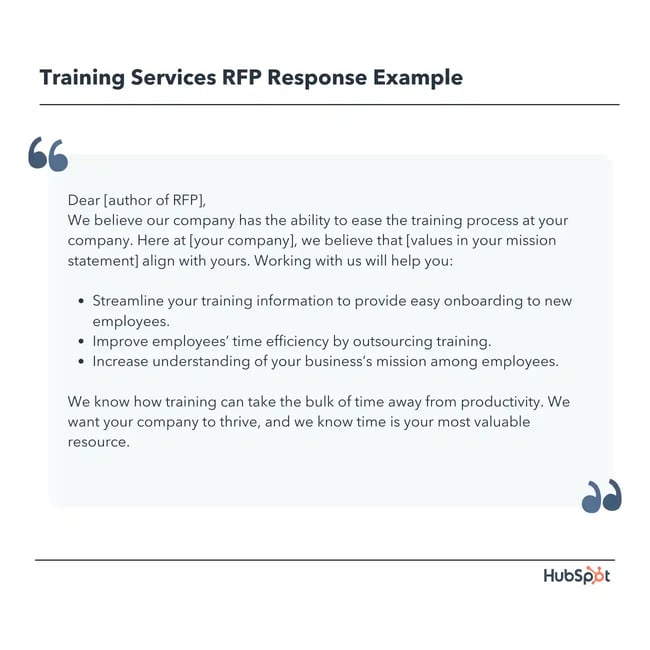
We believe our company has the ability to ease the training process at your company. Here at [your company], we believe that [values in your mission statement] align with yours. Working with us will help you:
- Streamline your training information to provide easy onboarding to new employees.
- Improve employees’ time efficiency by outsourcing training.
- Increase understanding of your business’s mission among employees.
We know how training can take the bulk of time away from productivity. We want your company to thrive, and we know time is your most valuable resource.
We recommend that you download our free proposal templates for even more proposal templates.
RFP Response Best Practices
1. don’t get ahead of yourself.
Oftentimes, during an informal discussion with a prospective client, the agency owner will hear the words, "Just send me a proposal." The owner thinks this is a sign that the client wants to commit. In fact, many clients just see this as a first date or even a "sure, just call me sometime."
So, the agency's staff spends hours and hours creating a detailed pitch deck , and the owner emails it within 48 hours.
I'm sure you can guess what comes next: silence.
It’s understandable to get excited when a prospective client expresses interest in your services. While immediately crafting a proposal shows dedication and speed, it’s important not to get ahead of yourself.
Make sure you’re sending over a flawless, thorough RFP response – which may take more time and effort than you were hoping for.
2. Ask the Right Questions
Before you even get to creating the proposal, you first need to determine if the client is wasting your time. If the client isn’t the right match for your services, why should you even make the investment in creating this document?
You can quickly avoid situations where you are just sending out proposal after proposal by figuring out the client's BANT .
- Budget: How much is the client prepared to pay for the need?
- Authority: Does the person reading your proposal have a say in the decision?
- Need: What is the client looking for?
- Timing: How long will the client need to decide?
”When you start taking on clients just because of the money, you are going to have problems later on,” Swenk said.
3. Emphasize Precision, Facts, and Proper Expectations
By switching your response strategy from being the first company to submit a response to being the best agency to submit a response, you set yourself up with a greater chance to close the deal and deliver on clear, feasible, and appropriate expectations for the prospective client.
This means moving away from generalized responses like “our agency is committed to completing the project on time and within budget every time,” toward hyper-focused responses such as “our agency will complete [set tasks] by [desired date] with a budget of [dollars], specifically by completing [action item #1], [action item #2], and [action item #3].”
4. Use an RFP Response Template [Outline Below]
Make sure you leave no topic unaddressed that your contact may want information on. Information about your company, the team your client would be working with, and expectations around budget, timeline, and deliverables should be crystal clear.
This specificity is even more necessary for contacts you have not yet spoken. Use the RFP response to explain your company’s background and your process for driving ROI.
Finally, you can do two important things to make your closing rates increase.
Review the proposal with the prospective client. Don't just send it over and hope for a response. And state that this is a mandatory requirement. When a client requests a proposal, schedule a meeting to review the information. If they can't commit to a meeting, you shouldn't be spending your time crafting this in-depth document.
“Be able to walk away," Swenk said. "They are just shopping, and they are going to waste your time.”
Next, build your proposal template . Once you have the ideal structure in place, build a template you can use with every prospect. There's no need to start from the beginning each time. This will save you time and will lead to higher conversions as the prospect won't have enough time for buyer's remorse to sink in.
A proposal should be the result of numerous discussions with the prospective client. There should be no surprises — either in price or the strategy that you are suggesting — and it should be seen as a written review of your processes and the conversations with your client.
Providing Value and Solutions For Your Client
When responding to an RFP, you want to make the scope of your project clear and communicate undeniable value to your client. Once you outline the scope of the project and the benefits the client will receive, you are more likely to close the deal and establish a successful business relationship with your client company.
Editor's note: This post was originally published in May 2015 and has been updated for comprehensiveness.
Don't forget to share this post!
Related articles.
![cover letter for responding to rfp What is a Marketing Proposal, and How Can You Create One? [Template Included]](https://blog.hubspot.com/hubfs/marketing%20proposals-1.jpg)
What is a Marketing Proposal, and How Can You Create One? [Template Included]
![cover letter for responding to rfp 8 Best Tips for Business Proposal Presentations [+Examples]](https://blog.hubspot.com/hubfs/business-proposal-presentations.jpeg)
8 Best Tips for Business Proposal Presentations [+Examples]

15 Proposal Software Tools for Proposal Creation and Management

7 Things to Consider Before Issuing Your Next RFP

How to Get Paid for Proposals

Why RFPs Fail When Choosing a Marketing Agency

Should You Respond to That RFP? 4 Reasons For Saying 'Yes'

4 Tips For Presenting Powerful New Business Proposals
![cover letter for responding to rfp Bidsketch Gives Agencies the Tools to Create Proposals — Fast [Tech Profile]](https://blog.hubspot.com/hs-fs/hub/53/file-1520221479-jpg/blog-files/ruben.jpg)
Bidsketch Gives Agencies the Tools to Create Proposals — Fast [Tech Profile]

5 Things Every Marketer Needs to Include in a RFP
Free, Unique RFP Templates to Start Using Immediately.
Marketing software that helps you drive revenue, save time and resources, and measure and optimize your investments — all on one easy-to-use platform
Looking for RFP360? Log in here
How to write a winning RFP response
Why you need the ultimate library for your rfp responses.
Blog , Respond to RFPs , Responding to RFPs
Updated: Feb 12th, 2024

RFP360 is a part of RFPIO, the leading response management software. To explore additional resources about how to write a winning RFP response, visit RFPIO.com .
There’s nothing more frustrating than spending hours writing, editing and collaborating with SMEs only to find out you lost another RFP opportunity. Your business puts hours into each proposal. So, if your hard work isn’t paying off as often as it should, it may be a good time to explore what goes into a winning RFP response.
Behind every winning RFP response is a proposal team. And as they can tell you, creating compelling and engaging proposals is a learned skill. Not only does it take time and practice, it also requires a bit of trial and error.
In this blog, I’ll break down an RFP response, section by section, to define the goals of each and explore how to accomplish them. Then, I’ll offer RFP response best practices as well as winning examples. Finally, I’ll conclude by exploring common challenges that come up during the RFP response process and how to overcome them.
Section-by-section guide to creating a winning RFP response
- Proposal content best practices
Common RFP response roadblocks and how to overcome them
Before we get into the nitty-gritty details of each section, let’s start with the golden rule of request for proposal responses: It’s all about the customer. In each section and in every response, keep the customer in mind. Remember, these incredibly busy people have a problem to solve. Therefore, if they feel like you’re wasting their time, you’ve already lost them. So, as we work through each RFP response section, remember these guidelines:
- Stay focused on the customer’s problem and the solution you deliver
- Keep it short and fluff free — for the customer, the RFP isn’t an invitation for you to give a sales pitch, it’s a fact-finding mission
- Stick to the project scope and remove any information that isn’t immediately relevant, save the upsell for later
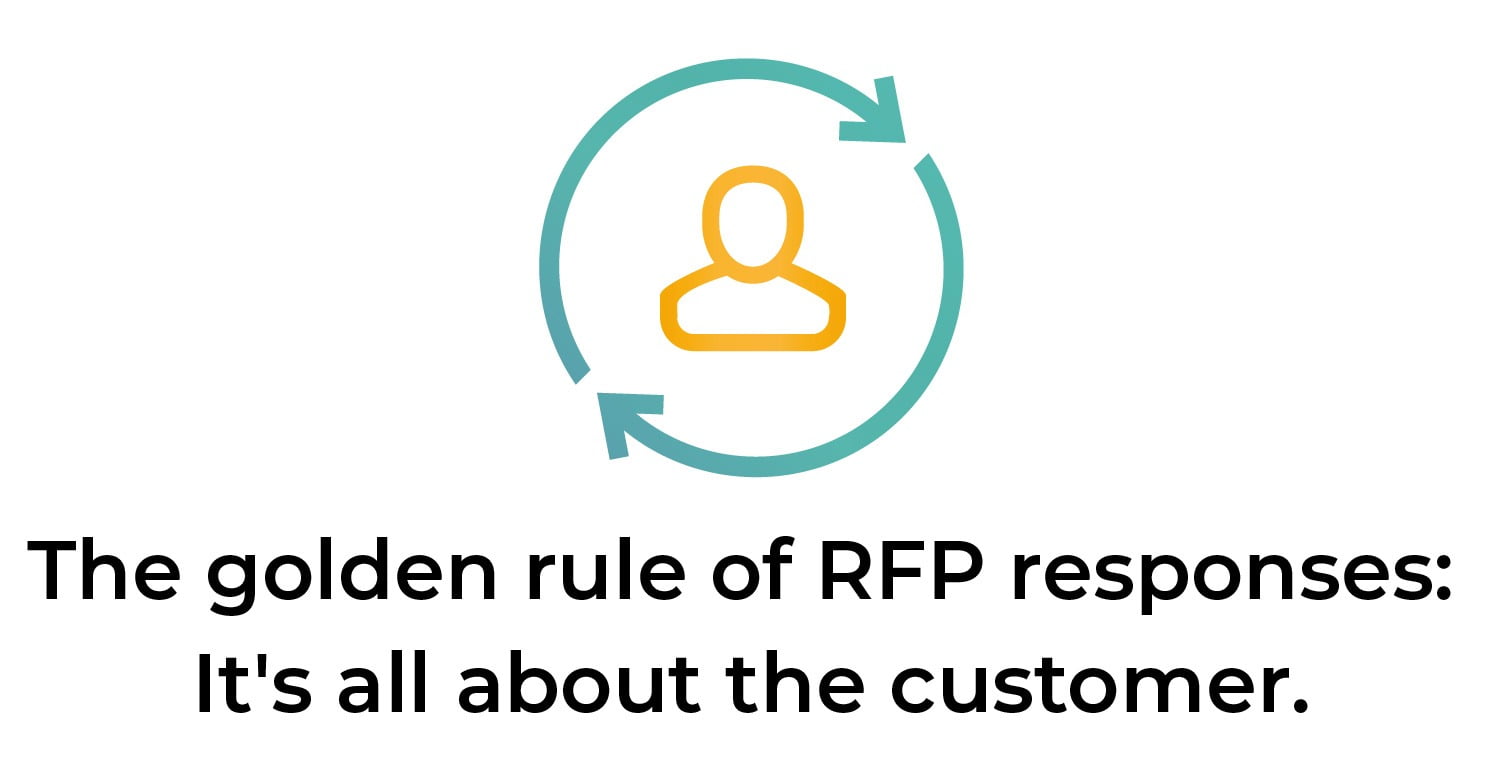
RFP response sections: Goals and how-to guide
Rfp cover letter.
The goal: Make a good first impression, create a human connection and let the customer know you truly understand their problem.
How to do it: Share your enthusiasm about the prospect of being a part of their future success. Then, restate their known objectives. Finally, paint a picture of how your solution solves their problem and makes their job easier. Make it all about them.
If you’re ready to write a killer cover letter, download this RFP cover letter template.
Executive summary
The goal: Give a high-level overview, summarize the most important parts of your proposal and prove you’re qualified to meet their needs.
How to do it: Research. Do your homework to ensure your executive summary addresses the customer’s biggest concerns. Find out why they’re issuing the RFP. Did their last provider fail to deliver? Is their business growing? The more you can speak directly to their needs, the greater your chance of winning the project. Remember, your summary needs to provide enough information to stand alone if it’s the only piece of the proposal an executive sees. However, it also must be short enough to read in a couple minutes.
Want to see what a stand-out executive summary looks like? Check out this executive summary template example for a guide.
Project implementation plan and schedule
The goal: Help the buyer picture themselves as your customer and prepare them for the next steps in the buying process.
How to do it: Be specific. Your project implementation plan and schedule sets expectations. For example, establish milestones and address any concerns the customer expressed. In addition, provide a full project plan outline from purchase to go-live date. Use the RFP timeline the buyer provided and set milestones assuming a start date almost immediately after the RFP’s final selection announcement.
It is also helpful to share key contacts and staff the customer will work with from subject matter experts to project managers. Finally, include what you’ll need from their business to ensure a successful engagement. For example, current process documentation, training timelines, user roles, administrator input and so on.
Contract management
The goal : Ensure a speedy contracting process that benefits both you and the customer.
How to do it: In this section of your request for proposal response, get your ducks in a row so the contracting process goes smoothly. For example, share what you’ll need to execute the contract and include who will be involved. Then, outline the approval process and required documentation. Consider preemptively providing your standard SIG assessment or security questionnaire as well as terms and conditions.
In addition, offer an overview of how you’ll continue to support the customer after the contract is executed. Include information about their customer success manager, any available self-service tools and who will supervise the delivery of contract terms.
If possible, provide very specific details — how often will someone check in, what will be covered and how feedback is addressed? Remember, it’s all about them. Make them feel confident that you’re in it for the long haul and prepared to be a true partner to them.
Customer references and case studies
The goal: Provide concrete evidence of the results they can expect.
How to do it : Share the positive return on investment you’ve achieved for customers similar to your prospect. Of course, don’t make them just take your word for it. Also include metrics and powerful quotes provided by happy customers. If possible, offer to connect them with a current customer for a reference call. Certainly, there’s nothing more persuasive than hearing candid feedback from a peer.
Explore everything you need to know about return on investment in this ebook: Measuring the value of RFP software.
Proposal content best practices with winning RFP response examples
Beyond hitting the goals for each RFP section outlined above, winning RFPs have great content. I’ve reviewed content from countless winning RFP response examples and they all have a few things in common. I’ve collected these themes and created a list of RFP response best practices and examples below.
Insert the customer into your answers
Remember, it’s never about you. Your audience doesn’t care how great you are. They only care about how you can make their lives easier and improve their profitability. All of your answers should support your argument that you will make them more efficient, effective and empowered.
In addition, don’t just explain what you do, but also why it’s important. This focus will help you write an about us and background statement that will make prospects pay attention.
Original RFP response: Our company improves efficiency and cost savings.
Winning RFP response example: XYZ solution , empowers ABC company to optimize efficiency and maximize savings.
Keep it simple and skimmable
Your evaluators are pressed for time. Write clearly and succinctly. Use headings, subheadings, call-outs, and bullets to make your proposal easy to skim. And, remember to keep it simple so your responses can be read and understood by anyone.
Original RFP response: With XYZ solution , which optimizes internal and external collaboration and communication processes, automates RFP management, improves workflow and empowers reporting, our current customers like ABC Company are able to not only respond to complicated RFPs, but also issue requests, security questionnaires and due diligence questionnaires for a full-circle procurement and proposal experience.
Winning RFP response example: Customers like ABC Company leverage XYZ solution to:
- Improve internal and external collaboration
- Automate complex RFPs
- View workflows and reports
- Issue RFPs and questionnaires
- Centralize procurement and proposal functions
Include visualizations
Charts and graphs quickly convey a more powerful message than a spreadsheet full of data. Use visualizations to help customers understand your impact.
Original RFP response: XYZ solution’s customer submitted 83 proposals in 2018. More than twice the number completed by their competitors.

Winning RFP response example: XYZ solution’s customer submitted 83 proposals in 2018. More than twice the number completed by their competitors.
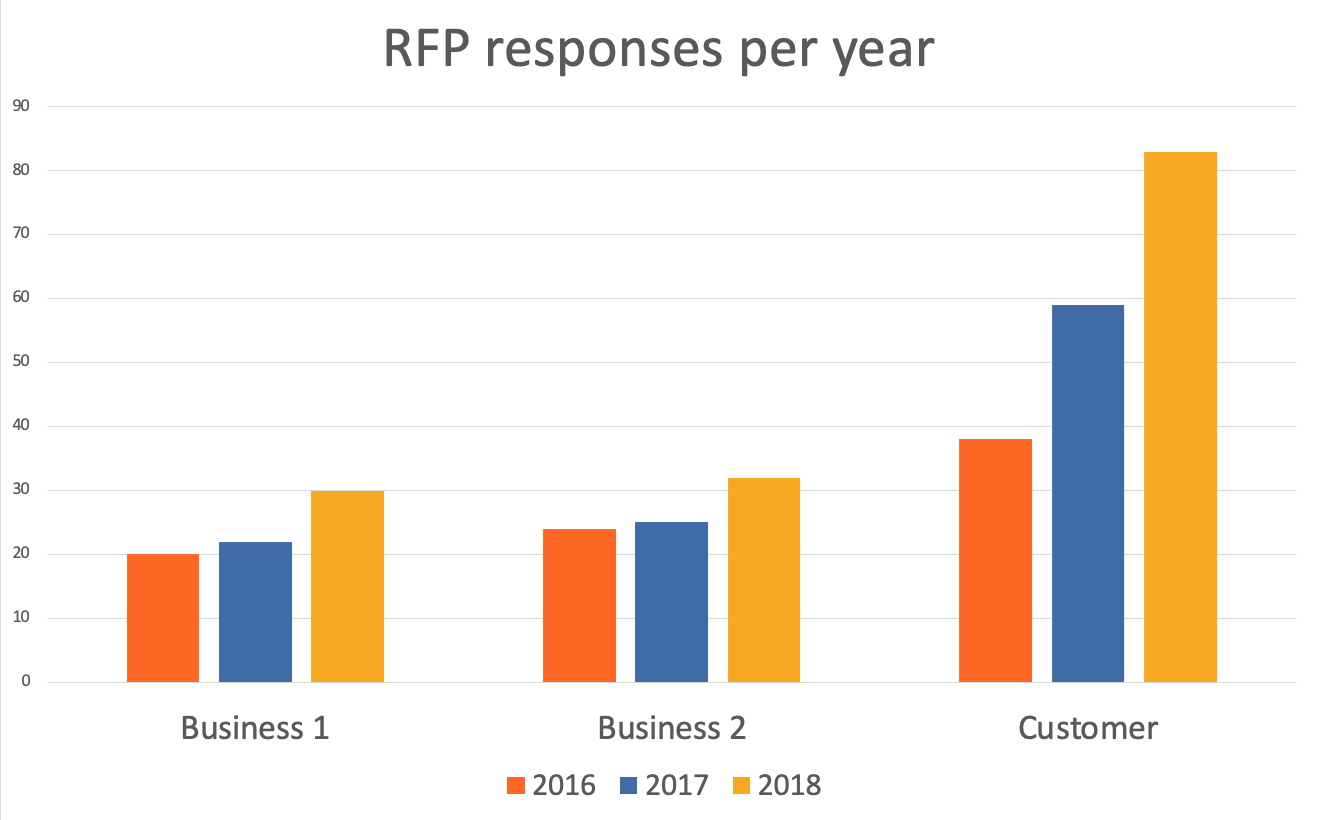
Review, revise then review again
Typos, style inconsistencies and abrupt changes in grammatical tense or tone can be incredibly distracting for your reader. Consequently, it’s important to review your responses and make sure they all work together and sound consistent.
In fact, try reading your responses out loud. It will help you catch a ton of errors or awkwardness that spell check won’t. A recent blog from Proposal Reflections offers five things to watch for (and remove) from your proposals including: long sentences, passive voice, empty words, nominalizations and incorrect words. Follow these guidelines to make your content stronger, more concise and more persuasive. The post also offers this example:
Original RFP response: Our COTS solution saves the Government time and money.
Winning RFP response example: Our COTS solution provides the Government with life-cycle savings of $250,000 in software development costs.
The customer isn’t asking the right questions.
The challenge: The customer missed something key in their RFP. Whether the gap in information makes it difficult for you to win or might also result in the customer selecting an incomplete solution, it’s worth mentioning. But how do you make sure the customer has all the information they need?
Work through the roadblock: Procurement professionals are skilled at finding the best vendor for a project. However, they may not be an expert in the nuance of your particular industry, good or service. So, they likely used stakeholder requirements and feedback to customize an existing RFP template. Unfortunately, that process often leaves gaps in knowledge and results in an incomplete RFP. It also puts you in a tough position of trying to explain additional value you deliver that the customer doesn’t understand and didn’t ask about.
Typically, at the beginning of the RFP timeline, there’s a period to allow for vendor questions. This is a good time to raise the concern. Simply include it in your questions. For example, you can ask: “Have you considered unaddressed factor , is that an area of need for ABC Company ? Alternatively, you could say, “Many of our customers ask about unaddressed factor , would you like us to include information about how XYZ solution solves this challenge?
Time consuming back-and-forth with subject matter experts (SMEs)
The challenge: One of the hardest parts of creating a request for proposal response is coordinating with your subject matter experts. They’re usually very busy people. And, while they’re experts in their field, they likely all have a different writing style. So, how do you make RFP responses from a dozen different sources look consistent and sound cohesive?
Work through the roadblock: Most SMEs are just as excited about winning new business as you are, but they can’t read your mind. Unfortunately, they won’t know intuitively what to cover just by reading the RFP question. So, be clear about what you need. SMEs are usually happy to provide answers that cover customer hot buttons, written in the company’s preferred proposal format — they just need to know what that is. It’s usually as simple as providing your SMEs with a company style guide for faster editing.
In addition, make sure you’re searching your knowledge library before asking an SME to weigh in on an RFP question. There’s nothing more frustrating and alienating than answering the same question over and over again. If you find an applicable knowledge record, send the response to the SME for review. After all, updating or customizing a response is a lot faster than writing from scratch. Certainly, this is a situation where RFP software that centralizes internal collaboration is an advantage.
SMEs are a key part of your proposal team. So, bring them into the fold and make the importance of their role clear. Include SMEs in proposal kickoff meetings, regular content updates and annual process reviews. Even if they can’t make every meeting, putting in the effort to keep them involved will help them feel invested.
The RFP clearly favors a specific vendor
The challenge: You recognize your competitor’s language in the RFP. It seems like they are the incumbent vendor or are heavily favored. You suspect their capture management team helped craft the RFP. To have a fighting chance, you’ll need to overcome an unfair preference with education and awareness.
Work through the roadblock: Some RFPs aren’t fair. That’s the unfortunate truth. We all know our competitors and for the most part, we’re all using the same tactics to try to win new business. For example, we all know how much easier it is to write a winning RFP response when your team helped craft the RFP itself.
If you notice the RFP favors a specific approach or if phrasing is overly specific, that’s a good indication of a competitor’s influence. Use your competitive intelligence to counteract their preconceived notions. Without naming the competitor, explain why your product or approach better addresses their needs.
Alternatively, just ask. Reach out to the RFP contact and look for more background information. Is there an incumbent vendor? If so, why has the project gone back out to RFP? What would sway the decision maker or what is the competitor lacking that would make the decision easy? Ultimately, addressing the lack of transparency head-on will help you make a well-informed decision to bid or not to bid.
The RFP response has a quick turnaround
The challenge: In the world of RFPs, time is typically your biggest adversary. Your proposal timeline can only be compressed so much and manual processes make submitting responses on time difficult.
Work through the roadblock: One of the best ways to fast-track your proposal process is to invest in RFP response software. Not only will it automate your responses by suggesting answers to previously asked questions, but it will also empower you to:
- Search and find past proposal content
- See who wrote the content and when it was written
- Review the revision history
- Verify when the content was last reviewed and updated
- Check how often it’s been used
Too many teams spend all their time writing answers but never organize them. If your team can’t find and reuse past RFP responses, collaborate on content and easily see team responsibilities and next steps, you’ll end up constantly reinventing the wheel.
Ultimately, everyone involved in the sales and proposal process is working toward a singular goal — to win new business. And, for proposal professionals, there is no greater feeling than hearing that your team submitted a winning RFP response. Follow these winning RFP response best practices to see all of your writing, editing, collaborating and waiting pay off.
- Product & Best Practices
- Selling & Enablement
- Content & Storytelling
- People & Teams
- Company & Events
- Customer Stories
Related Post

What proposal management tools do you need in your stack?
Without the right proposal management tools, responding to RFPs, RFIs and other information requests...

Why RFPs are a cornerstone in the enterprise sales cycle
Responders play a pivotal role in winning new business for enterprise organizations. You are a key...

Reducing RFx response time for a health insurance company from days to hours
Improving RFx response outcomes through automation, advanced content management, and winning trust from all users. Health insurance is one of...
See how it feels to respond with confidence
Why do 250,000+ users streamline their response process with Responsive? Schedule a demo to find out.
- Privacy Overview
- Strictly Necessary Cookies
- Marketing Cookies
This website uses cookies so that we can provide you with the best user experience possible. Cookie information is stored in your browser and performs functions such as recognising you when you return to our website and helping our team to understand which sections of the website you find most interesting and useful.
To learn more read our Cookie Policy .
Strictly Necessary Cookie should be enabled at all times so that we can save your preferences for cookie settings.
We use cookies to enhance your browsing experience, serve personalized ads or content, and analyze our traffic. By choosing to leave these enabled, you consent to our use of cookies.
Please enable Strictly Necessary Cookies first so that we can save your preferences!
How to Create a Winning RFP Response Template (Plus, PDF Example)

If you’re like the average proposal team, you may submit around 162 RFP responses annually. That’s more than 3 proposals every week—a pace that could overwhelm even the most seasoned professionals. 😅
To keep up with this high volume, having an RFP response template isn’t just a convenience, but a necessity. Instead of grappling with formatting every time, it helps you streamline your RFP response process, so you can focus on customizing answers and consistently deliver winning proposals.
Read on to learn what makes a good response in the first place, how to build a well-structured template from scratch, and more ways to save hours (and effort) in your submission cycle.
But, if you’re already in a time crunch, download this RFP response template to use right now. Here’s how to get started:
What is an RFP Response Template?
- Key Components to Include
- How to Customize Your Winning Template
- RFP Response Template (PDF Example)
- Other Tools to Speed up Your Process
An RFP response template is a document that you can complete in order to speed up your response process. Within the template, you’ll store repeatable answers (and requirements) to answer your buyer’s most frequently asked questions. It’ll help you spend less time writing from scratch—and more time customizing to your buyer’s specific needs.
Think of it as a shortcut to quickly capture recurring information, so you can focus on adding special details that make your prospective client feel valued and understood.
Why use this approach? Because an RFP template…
Provides a Structured Framework for Consistency
Using a template makes it easy to present your information in a consistent, uniform manner. A predefined format is particularly important when multiple team members create a proposal as it helps maintain a consistent look and feel throughout the response— instead of appearing as a class art project . 🎨
Helps You Complete an RFP, To the Right Standards
Different requests for proposal might have similar requirements between clients in your industry. By mapping out common sections in advance, you can simply fill in the client company and modify information as needed. This allows your team to quickly follow a repeatable process that ensure key details don’t get overlooked.
Saves Time to Focus On Client Customization
A template can significantly speed up the drafting process. Instead of reinventing the wheel every time, your team can focus on customizing content for the current RFP. Plus, a quicker turnaround time allows you to submit multiple RFPs in a timely fashion, which is essential in today’s competitive market.
How to Build Your Template (7 Components)
Now that you’re sold on the idea of an RFP template, you’re probably wondering what goes into developing one. The seven key components of almost any response include:
- Cover letter
- Executive summary
- Company qualifications
- Proposed solution
- Pricing details
- Success stories
- Terms and conditions
These components are vital in crafting an effective RFP response. They help lay out a solid plan for managing and discussing the solution while building trust with the client. Let’s look at each in detail:
1. RFP Cover Letter
Like an executive summary (see below), a strong proposal cover letter sets the stage for the rest of your proposal by demonstrating your commitment to meeting the client company needs from the onset.
As the first impression, your RFP cover letter should be professional, engaging, and showcase your company’s interest in the project. So, make sure to include details about your understanding of the requirements, how your company can specifically help the client, and your eagerness to work with them.
2. Proposal Executive Summary
An executive summary serves as a brief overview of your proposal, which highlights your company’s strategic approach (and unique expertise) in addressing the primary problem. It should introduce a high-level view of your win themes and demonstrate why your solution is a good fit, clearly and concisely.
Keep in mind—a potential client may review multiple RFPs, so make sure your executive summary gets right to the point by focusing on the competitive advantage that sets your company apart.
3. Company Qualifications
Think of this section as a general overview of your company. It’s your chance to give a little background to your company’s history, share your core values ( to emphasize why you’d make a great partner ), introduce team members involved, and highlight your qualifications for the evaluation criteria.
Since RFPs are notorious for asking tons of questions— hundreds even —it can be a good idea to answer them in this section through a table format. This’ll make it easy for the evaluator to run through each ( and add a score ). As a bonus, it’s also easier for you to track which questions your SMEs still need to answer if left blank. 🤫
4. Proposed Solution
It’s time for your implementation plan. In this section, you’ll expand on your company’s unique approach to solving the client’s problem by outlining the scope of work, project timeline, and other parties involved.
The goal here is to instill confidence in your company’s ability to execute efficiently and effectively. So, make sure to:
- Be detailed about the key deliverables and services included in a project summary ( as well as anything that will be excluded to avoid misunderstandings later on ).
- Be realistic in your proposed timelines, and ensure that the client understands the various stages of the project and how your team will work together to achieve the desired outcomes.
- Be specific about your tailored solution to show the client you value their business and want to go above and beyond meeting their needs— not just meet the RFP requirements .
5. Pricing Details
“ How much will this cost? ” is a top question for prospective clients. When creating proposals, it’s important to provide transparent pricing and payment terms, so the client understands the cost structure and overall value of the proposed contract. In this section, you should:
- Break down the total cost into categories, such as labor, materials, and overhead expenses.
- Explain any discounts, promotions, or incentives that may be available to the client (just remember to resist the urge to undersell yourself).
- Think like a negotiator by NOT providing the lowest price from the get-go. Instead, submit a quote with a 10% higher gross margin to leave wiggle room for negotiation.
- Clearly outline your payment terms , such as your billing schedule and accepted method of payment, to prevent any disputes or misunderstandings later in the project.
6. Success Stories
The purpose of this section is to back up your claims with proof in your response template. By presenting your company’s accomplishments through success stories, you build trust and credibility with the client, which reassures them that they are making the right choice.
So, highlight past projects that demonstrate your ability to deliver on the proposed scope of work. If possible, share testimonials from past clients that fall into a similar business category, industry, or pain point, so that those stories resonate with the RFP issuer.
7. Terms and Conditions
This is where you cross the T’s and dot the I’s by including comprehensive terms and conditions that establish a solid foundation for a successful partnership. In this section, your aim is to:
- Outline the contractual terms and conditions that both parties will adhere to—detailing the rights, obligations, and responsibilities of each.
- Address any potential risks or issues that may arise during the project and provide solutions or contingencies to mitigate these concerns.
- Plan for the worst case scenario by protecting your company with a termination clause.
What is an example of a good RFP response?
A good RFP response focuses on the customer, not your company.
For example, this response successfully highlights a compelling benefit:
Our project management team is agile and can tailor our proven process to your needs with the main steps remaining consistent: build, test, and deliver value. We can save you time by deploying this software for you, as we’ve saved other clients 2,000 working hours annually.
But it doesn’t put the customer first. Instead, a better response would be:
With [number of customers], your time should go toward providing [client’s main service]––not software deployment. By handling this process for you, we can save you 2,000 hours annually, so you can focus more on what you do best [client’s mission statement] .
4 Steps to Customize Your Winning Response
Once you’ve got the key components down, you might be tempted to get right into writing your RFP response. But even with a handy template, there are some important steps you’ll want to follow.
- Research the client to better understand their needs
- Collaborate with SMEs to write the best possible content
- Use graphics to capture the attention of decision-makers
- Edit the proposal to make it clear, compelling, and concise
1. Research the Client to Understand Their Needs
Thoroughly researching the client ( and their industry ) can help you tailor your response to their specific goals, pain points, and expectations. To gather this insight:
- Study the RFP document several times before jumping to respond, making note of formatting requirements, submission guidelines, and evaluation criteria
- Speak directly with the key decision makers to find out what they care about most ( if you don’t have a direct line to the client, hop on a call with the sales person assigned to the account )
- Do extra homework by seeing what you can dig up from their website, marketing collateral or recent press releases about the client’s company.
- Scope out the competition to see who you might be up against ( including the incumbent ), and where you have the upper hand going into the RFP process .
Gaining this deep understanding of the client’s needs will enable you to customize your proposal and demonstrate your ability to provide a solution that is uniquely suited to their requirements.
2. Collaborate With Subject Matter Experts (SMEs)
Whether you’re a proposal team of one or eight, don’t forget to draw on the knowledge of other team members in your organization when developing an RFP response. SMEs can offer insights, expertise, and unique perspectives through the entire process, ensuring an accurate and well-rounded proposal.
But they aren’t always the easiest to collaborate with ( especially when they ignore your emails 😟). When working with SMEs, consider this approach to increase the likelihood of their participation:
- Host a kickoff meeting: Get them excited about the opportunity by sharing details about the potential client and deal size—and how their answers can help your company win the RFP.
- Take the first pass: Do SMEs a favor by writing a first draft of the answers. They’ll appreciate you making the task a lighter lift, whether it’s filling in the blanks or reviewing for accuracy.
- Give them guidelines: Share your content plan for the sections that belong to them. Plus, provide RFP response examples they can use as a guide for structuring their answers.
- Cater to their communication style: Some SMEs are responsive to email, others prefer to hop on a call. Find out what each SME prefers and collaborate accordingly.
3. Use Graphics to Enhance the Proposal
Your RFP response shouldn’t just read well—it should look good to your prospective client, too. 🤩 So, loop in your graphic designer in your final pass, to bring your proposal to life.
After all, visuals help communicate complex information, highlight key points, and make your proposal more persuasive and eye-catching. In your structure of a proposal , consider incorporating:
- Pie charts or bar graphs to highlight stats like business growth, year-over-year projections, or success data.
- Comparison tables to break down which features you offer compared to your top competitors—or if you dare, the incumbent.
- A timeline graphic to bridge the gap between where the client is now and where your company can take them based on your action plan.
4. Make the Proposal Clear, Compelling, and Concise
Having put so much work into crafting a detailed proposal, the last thing you want is to fall down on sloppy mistakes at the finish line. 🏁 After all, proofreading can increase the likelihood of winning business because it shows your company pays attention to details ( i.e. cares about quality work ).
So, use online editing tools like Grammarly or the Hemingway App to perform a quick spelling and grammar check. Read the RFP response out loud to catch awkward phrasing or inconsistencies. And, if possible, ask a team member who’s not involved to read it with fresh eyes.
By the time you’re finished, the final proposal should be:
- Clear: There aren’t any over-complicated words or jargon that might leave the evaluator confused.
- Compelling: The proposal is full of details personalized to the prospective client.
- Concise: You get straight to the point—there aren’t run-on sentences or super long paragraphs.
How can I tailor my RFP response to fit the client’s specific needs?
Start by researching the client and industry. This will help you understand the client’s needs and the context of the project. Then, collaborate with your team to brainstorm win themes and develop a content plan. Finally, customize your proposal to the RFP’s specific requirements.
Example RFP Response Template ⬇️
Looking for a quick way to get started? Download this RFP response template to create high-quality proposals faster . ( You don’t even need someone skilled in Adobe to use this repeatable template .)
✨ Tip: If you use Loopio, you can upload your own proposal template , directly within the platform.
Next Steps: Speed Up Your RFP Response Process With These Tools ✨
Want to decrease your turnaround time for your next RFP response? Now that you’ve got your template planned out, and you know how to write an RFP response , here’s two other tools we recommend that can save hours ( and effort ).
RFP Response Software
RFP response software tames RFP writing chaos by auto-suggesting answers from past RFPs, assigning questions to SMEs, streamlining content upkeep, and more—so you can create quality proposals faster.
Generative AI
Stuck on the blank page? You can use generative AI for RFP responses to build a custom content plan, summarize an executive bio, and whip up a speedy first draft of your RFP answers.
Related posts
How to write a proposal executive summary that sells, not summarizes (example + template included), how to write a bid proposal (steal this free template), loopio’s powerful ai toolkit (gpt included).
- Skip to main content
- Keyboard shortcuts for audio player
NPR defends its journalism after senior editor says it has lost the public's trust

David Folkenflik

NPR is defending its journalism and integrity after a senior editor wrote an essay accusing it of losing the public's trust. Saul Loeb/AFP via Getty Images hide caption
NPR is defending its journalism and integrity after a senior editor wrote an essay accusing it of losing the public's trust.
NPR's top news executive defended its journalism and its commitment to reflecting a diverse array of views on Tuesday after a senior NPR editor wrote a broad critique of how the network has covered some of the most important stories of the age.
"An open-minded spirit no longer exists within NPR, and now, predictably, we don't have an audience that reflects America," writes Uri Berliner.
A strategic emphasis on diversity and inclusion on the basis of race, ethnicity and sexual orientation, promoted by NPR's former CEO, John Lansing, has fed "the absence of viewpoint diversity," Berliner writes.
NPR's chief news executive, Edith Chapin, wrote in a memo to staff Tuesday afternoon that she and the news leadership team strongly reject Berliner's assessment.
"We're proud to stand behind the exceptional work that our desks and shows do to cover a wide range of challenging stories," she wrote. "We believe that inclusion — among our staff, with our sourcing, and in our overall coverage — is critical to telling the nuanced stories of this country and our world."

NPR names tech executive Katherine Maher to lead in turbulent era
She added, "None of our work is above scrutiny or critique. We must have vigorous discussions in the newsroom about how we serve the public as a whole."
A spokesperson for NPR said Chapin, who also serves as the network's chief content officer, would have no further comment.
Praised by NPR's critics
Berliner is a senior editor on NPR's Business Desk. (Disclosure: I, too, am part of the Business Desk, and Berliner has edited many of my past stories. He did not see any version of this article or participate in its preparation before it was posted publicly.)
Berliner's essay , titled "I've Been at NPR for 25 years. Here's How We Lost America's Trust," was published by The Free Press, a website that has welcomed journalists who have concluded that mainstream news outlets have become reflexively liberal.
Berliner writes that as a Subaru-driving, Sarah Lawrence College graduate who "was raised by a lesbian peace activist mother ," he fits the mold of a loyal NPR fan.
Yet Berliner says NPR's news coverage has fallen short on some of the most controversial stories of recent years, from the question of whether former President Donald Trump colluded with Russia in the 2016 election, to the origins of the virus that causes COVID-19, to the significance and provenance of emails leaked from a laptop owned by Hunter Biden weeks before the 2020 election. In addition, he blasted NPR's coverage of the Israel-Hamas conflict.
On each of these stories, Berliner asserts, NPR has suffered from groupthink due to too little diversity of viewpoints in the newsroom.
The essay ricocheted Tuesday around conservative media , with some labeling Berliner a whistleblower . Others picked it up on social media, including Elon Musk, who has lambasted NPR for leaving his social media site, X. (Musk emailed another NPR reporter a link to Berliner's article with a gibe that the reporter was a "quisling" — a World War II reference to someone who collaborates with the enemy.)
When asked for further comment late Tuesday, Berliner declined, saying the essay spoke for itself.
The arguments he raises — and counters — have percolated across U.S. newsrooms in recent years. The #MeToo sexual harassment scandals of 2016 and 2017 forced newsrooms to listen to and heed more junior colleagues. The social justice movement prompted by the killing of George Floyd in 2020 inspired a reckoning in many places. Newsroom leaders often appeared to stand on shaky ground.
Leaders at many newsrooms, including top editors at The New York Times and the Los Angeles Times , lost their jobs. Legendary Washington Post Executive Editor Martin Baron wrote in his memoir that he feared his bonds with the staff were "frayed beyond repair," especially over the degree of self-expression his journalists expected to exert on social media, before he decided to step down in early 2021.
Since then, Baron and others — including leaders of some of these newsrooms — have suggested that the pendulum has swung too far.

Author Interviews
Legendary editor marty baron describes his 'collision of power' with trump and bezos.
New York Times publisher A.G. Sulzberger warned last year against journalists embracing a stance of what he calls "one-side-ism": "where journalists are demonstrating that they're on the side of the righteous."
"I really think that that can create blind spots and echo chambers," he said.
Internal arguments at The Times over the strength of its reporting on accusations that Hamas engaged in sexual assaults as part of a strategy for its Oct. 7 attack on Israel erupted publicly . The paper conducted an investigation to determine the source of a leak over a planned episode of the paper's podcast The Daily on the subject, which months later has not been released. The newsroom guild accused the paper of "targeted interrogation" of journalists of Middle Eastern descent.
Heated pushback in NPR's newsroom
Given Berliner's account of private conversations, several NPR journalists question whether they can now trust him with unguarded assessments about stories in real time. Others express frustration that he had not sought out comment in advance of publication. Berliner acknowledged to me that for this story, he did not seek NPR's approval to publish the piece, nor did he give the network advance notice.
Some of Berliner's NPR colleagues are responding heatedly. Fernando Alfonso, a senior supervising editor for digital news, wrote that he wholeheartedly rejected Berliner's critique of the coverage of the Israel-Hamas conflict, for which NPR's journalists, like their peers, periodically put themselves at risk.
Alfonso also took issue with Berliner's concern over the focus on diversity at NPR.
"As a person of color who has often worked in newsrooms with little to no people who look like me, the efforts NPR has made to diversify its workforce and its sources are unique and appropriate given the news industry's long-standing lack of diversity," Alfonso says. "These efforts should be celebrated and not denigrated as Uri has done."
After this story was first published, Berliner contested Alfonso's characterization, saying his criticism of NPR is about the lack of diversity of viewpoints, not its diversity itself.
"I never criticized NPR's priority of achieving a more diverse workforce in terms of race, ethnicity and sexual orientation. I have not 'denigrated' NPR's newsroom diversity goals," Berliner said. "That's wrong."
Questions of diversity
Under former CEO John Lansing, NPR made increasing diversity, both of its staff and its audience, its "North Star" mission. Berliner says in the essay that NPR failed to consider broader diversity of viewpoint, noting, "In D.C., where NPR is headquartered and many of us live, I found 87 registered Democrats working in editorial positions and zero Republicans."
Berliner cited audience estimates that suggested a concurrent falloff in listening by Republicans. (The number of people listening to NPR broadcasts and terrestrial radio broadly has declined since the start of the pandemic.)
Former NPR vice president for news and ombudsman Jeffrey Dvorkin tweeted , "I know Uri. He's not wrong."
Others questioned Berliner's logic. "This probably gets causality somewhat backward," tweeted Semafor Washington editor Jordan Weissmann . "I'd guess that a lot of NPR listeners who voted for [Mitt] Romney have changed how they identify politically."
Similarly, Nieman Lab founder Joshua Benton suggested the rise of Trump alienated many NPR-appreciating Republicans from the GOP.
In recent years, NPR has greatly enhanced the percentage of people of color in its workforce and its executive ranks. Four out of 10 staffers are people of color; nearly half of NPR's leadership team identifies as Black, Asian or Latino.
"The philosophy is: Do you want to serve all of America and make sure it sounds like all of America, or not?" Lansing, who stepped down last month, says in response to Berliner's piece. "I'd welcome the argument against that."
"On radio, we were really lagging in our representation of an audience that makes us look like what America looks like today," Lansing says. The U.S. looks and sounds a lot different than it did in 1971, when NPR's first show was broadcast, Lansing says.
A network spokesperson says new NPR CEO Katherine Maher supports Chapin and her response to Berliner's critique.
The spokesperson says that Maher "believes that it's a healthy thing for a public service newsroom to engage in rigorous consideration of the needs of our audiences, including where we serve our mission well and where we can serve it better."
Disclosure: This story was reported and written by NPR Media Correspondent David Folkenflik and edited by Deputy Business Editor Emily Kopp and Managing Editor Gerry Holmes. Under NPR's protocol for reporting on itself, no NPR corporate official or news executive reviewed this story before it was posted publicly.
What to know about Biden’s new student loan forgiveness plan

President Biden is forging a new path to reduce or eliminate federal student loan balances for tens of millions of borrowers, holding firm to a campaign promise to ease the burden of college debt.
The proposed forgiveness plan announced Monday is an alternative to the sweeping $400 billion debt relief program that Biden announced in 2022 and the Supreme Court blocked last summer. Since that court defeat, the Biden administration has worked through a negotiated rulemaking process to craft a regulation that achieves large-scale debt cancellation, albeit with a much more targeted approach than the last plan.
The Education Department will release a draft rule on the forgiveness plan to solicit public comment in the coming months. But the Biden administration is releasing more details of how the proposal will accomplish the president’s goal of sweeping debt reduction.
Here’s what we know.
What does Biden’s student loan relief plan do?
The new plan will expand federal student loan relief to several categories of borrowers. It will eliminate up to $20,000 in accrued interest for borrowers who owe far more than they originally borrowed because of unpaid interest. Borrowers could get all of their interest wiped away if they are enrolled in an income-driven repayment plan and have an annual income under $120,000 for an individual or under $240,000 for couples. The White House estimates that 25 million people will benefit from this feature of the new plan, including 23 million who could have their unpaid interest completely forgiven.
Once the plan is finalized, another 2 million borrowers could automatically have their loans canceled because they’re eligible for existing forgiveness programs, such as Public Service Loan Forgiveness , but never applied. The proposed plan will also automatically cancel the loans of people who have been in repayment on undergraduate loans for at least 20 years, and graduate loans for 25 years or more. It would also forgive the debt of borrowers who attended career training programs that led to high debt loads or low earnings.
A fifth category of borrowers would receive debt relief if they are facing hardships , such as high medical debt or child-care expenses, that prevent them from repaying their student loans. The specific terms of each category will be fleshed out in the formal rule due out soon.
The administration plans to roll out the interest education feature this fall, and the remaining features could be implemented next summer.
Who is eligible for student loan forgiveness?
The majority of Americans with federally held student loans will qualify for some level of relief under the new plan. People with privately held federal loans originated through the defunct Federal Family Education Loan (FFEL) program would also benefit from some aspects of the proposal.
Those commercial FFEL borrowers would receive forgiveness if they entered repayment on or before July 1, 2000, or are eligible but have not yet applied for a closed school discharge — a form of debt cancellation for borrowers whose schools abruptly close. Such borrowers would also be eligible for debt relief if they have loans associated with a college that lost access to federal student aid because of high loan default rates, according to the Education Department.
Do I need to apply for this loan forgiveness?
While the specifics of the plan are still being hashed out at the Education Department, the Biden administration said the goal is for the vast majority of the relief to be automatic.
I was approved for loan forgiveness in the old plan. Will I qualify this time?
It depends on whether you fit any of the five categories for loan forgiveness.
How is this different from the plan rejected by the Supreme Court?
Biden’s 2022 student loan forgiveness plan relied on the Higher Education Relief Opportunities for Students (Heroes) Act of 2003, which lets the secretary of education “alleviate the hardship that federal student loan recipients may suffer as a result of national emergencies.” The president argued that the coronavirus pandemic created economic hardship for borrowers that required government intervention of up to $20,000 in loan cancellation for 40 million borrowers. But in striking down the debt plan , a majority of Supreme Court justices said the Heroes statute was not designed for policy with such a “staggering” economic impact.
This time, instead of the 2003 law, the Biden administration anchored its new plan with authority in the 1965 Higher Education Act, which allows the education secretary to compromise, waive or release loans under certain circumstances. Critics of Biden’s plan question whether the 1965 law permits expansive debt relief envisioned by the administration, and note that Chief Justice John G. Roberts Jr. said in his opinion last year that the act can be used to cancel debt in “certain limited circumstances.”
The Biden administration said the new plan is composed of interventions that address specific circumstances in ways that are covered by the Higher Education Act. The president is confident he is acting within the scope of the law, according to the White House.
Are private loans eligible?
Loans originated and held by banks and other private entities are not eligible for the new forgiveness plan. But federal loans held by private companies are eligible for some components.
Student loans
The impact of student loan repayments : A technical loophole is helping some parents lower their student loan payments . The ending of the student loan payment pause has left some borrowers anxious and confused .
What are my student loan repayment options? Personal finance columnist Michelle Singletary shares what to focus on as student loan payments resume and why she says President Biden’s new SAVE student loan income-driven plan is a game changer .
What’s next for student loan debt relief? Biden is forging ahead on a new path to narrower student loan relief after the Supreme Court rejected his earlier loan forgiveness plan . Meanwhile, conservative groups sued to block Biden’s effort to provide $39 billion in forgiveness to longtime borrowers.


April 9, 2024
U.S. Postal Service Recommends New Prices for July 2024
%news-subheading%

WASHINGTON, DC — Today, the U. S. Postal Service filed notice with the Postal Regulatory Commission of mailing services price changes to take effect July 14, 2024. The new rates include a 5-cent increase in the price of a First-Class Mail Forever stamp from 68 cents to 73 cents.
The proposed adjustments, approved by the governors of the Postal Service, would raise mailing services product prices approximately 7.8 percent. If favorably reviewed by the commission, the price changes would include:
The additional-ounce price for single-piece letters increases from 24 cents to 28 cents. The Postal Service is also seeking price adjustments for Special Services products, including Certified Mail and money order fees. Notably, there will be no price increase for Post Office Box rental fees, and the Postal Service will apply a price reduction of 10 percent for postal insurance when mailing an item.
As changes in the mailing and shipping marketplace continue, these price adjustments are needed to achieve the financial stability sought by the organization’s Delivering for America 10-year plan. USPS prices remain among the most affordable in the world.
The commission will review the changes before they are scheduled to take effect. The complete Postal Service price filing, with prices for all products, can be found on the commission’s website under the Daily Listings section . The Mailing Services filing is Docket No. R2024-2. The price tables are also available on the Postal Service’s Postal Explorer website at pe.usps.com/PriceChange/Index .
Postal Products
Customers may purchase stamps and other philatelic products through the Postal Store at usps.com/shopstamps , by calling 844-737-7826, by mail through USA Philatelic or at Post Office locations nationwide. For officially licensed stamp products, shop the USPS Officially Licensed Collection on Amazon .
The United States Postal Service is an independent federal establishment, mandated to be self-financing and to serve every American community through the affordable, reliable and secure delivery of mail and packages to 167 million addresses six and often seven days a week. Overseen by a bipartisan Board of Governors, the Postal Service is implementing a 10-year transformation plan, Delivering for America , to modernize the postal network, restore long-term financial sustainability, dramatically improve service across all mail and shipping categories, and maintain the organization as one of America’s most valued and trusted brands.
The Postal Service generally receives no tax dollars for operating expenses and relies on the sale of postage, products and services to fund its operations.
For USPS media resources, including broadcast-quality video and audio and photo stills, visit the USPS Newsroom . Follow us on X , formerly known as Twitter; Instagram ; Pinterest ; Threads and LinkedIn . Subscribe to the USPS YouTube Channel and like us on Facebook . For more information about the Postal Service, visit usps.com and facts.usps.com .
Media contacts
- David P. Coleman [email protected]
Printable version

IMAGES
VIDEO
COMMENTS
Proposal Writing Training. A Winning formula for Your RFP Response Cover Letter. An oft-overlooked (and sometimes completely absent) section of RFP responses is the cover letter. Including a cover letter in your proposal provides a personal touch, allows you to address any administrative components, and gives a special place to sell your offering.
Your RFP cover letter should: Be the first page of your RFP response followed by your executive summary and proposal. Introduce your company to the buyer's key decision-makers and any others reviewing or scoring your bid. Be conversational, genuine and confident — but it shouldn't be an overt sales pitch.
Your RFP cover letter should: Be the first page of your RFP response followed by your executive summary and proposal. Introduce your company to the buyer's key decision makers and any others reviewing or scoring your bid. Be conversational, genuine and confident — but it shouldn't be an overt sales pitch.
How to write an effective response to an RFP in 5 steps. If you need to write an effective response to an RFP, here are five steps you can review to help you develop your proposal response structure: 1. Write a formal cover letter. Writing a formal cover letter at the beginning of your response to an RFP is important to help your company make a ...
To increase your chances of success, your RFP response cover letter should include the following: A statement to say that you're bidding for their contract. Details from their RFP, such as their company name and the commodities being procured. Explain why your business is qualified to respond to the RFP.
The proposal cover letter is meant to frame up your RFP proposal. It's not a rehashing of the proposal or executive summary . It's a vehicle to thank the issuer for the opportunity to respond, to say, "We've seen your business requirements and composed this proposal because we think we're the best partner for you."
A Response to RFP Cover Letter is a formal letter written by a company or organization in response to a Request for Proposal (RFP) from another company. Its purpose is to introduce the company and its proposal, highlight key points, and persuade the recipient to consider the proposal further.
The same is true when responding to Request for Proposal (RFP) opportunities. A successful RFP response establishes its tone immediately through a well-thought-out cover letter. RFP cover letters include an overview detailing why your organization is best suited to meet the issuer's needs. An effective cover letter for a bid proposal sets ...
Proposal cover letters are brief overviews that introduce the more in-depth content of a proposal. Cover letters are normally the first page of a proposal, making them the first impression you will give and your first opportunity to convince the reader to work with you. These letters directly communicate with the client and set the stage for ...
Bids and RFPs are our business - all day, every day! So reach out for a free consultation by calling 1-844-4BIDLAB or emailing [email protected]. Download the Template. RFP cover letters should be the icing on the cake of your RFP. So don't overlook the dos and don'ts of documents with a personal touch.
1. Cover letter. Begin your RFP response with a concise and well-designed introduction that informs the prospect how your solution solves their problem. Use language that puts the focus on the potential client and highlights your company's interest in working with them. Ideally, your cover letter should mention the following: who you're as ...
3. Draft the RFP response Write the cover letter. The cover letter accompanies your RFP response and is the first document the reviewing team will see. It's a crucial introduction to your company and a valuable opportunity to highlight any unique qualifications or expertise that make your organization the best fit.
Cover letters are sometimes called RFP response cover letters, RFP cover pages, or bid proposal cover letters. The cover letter is an important aspect of your RFP. Personalizing it gives you the chance to introduce your business, your solutions, and show in a glance how your business is best suited to the RFP you're responding to.
A cover letter; An executive summary; A response to the main proposal request; Case studies, and ; Pricing. Here are a few tips to make the most of each piece: Cover letter. Your cover letter should introduce your business and demonstrate that you understand the client's business. Show them why you're the right choice. Executive summary
The RFP cover letter: States that you are bidding for their business by responding to the RFP. Reiterates details from their RFP (i.e. company name, service/product requested). Explains why your organization is qualified to respond to the RFP. Reveals key benefits they will experience while working with you. Lists anything you are providing in ...
RFP cover letter template. When responding to a request for proposal (RFP) you may be asked to include an RFP cover letter. RFPs are used by local and federal governments and organizations in order to procure goods or services.. Your RFP cover letter will be the first thing that the contracting authority will read when looking at your proposal.
To write a cover letter for an RFP response, be sure to address the following points: 1) Introduce yourself. 2) Explain what motivated you to respond to the RFP. 3) State your qualifications and why you believe you would be a good fit for the position. 4) Share any relevant experience or information about the company or product.
In the world of proposals, the RFP cover letter (also called a proposal cover letter, RFP response cover letter, bid proposal cover letter, RFP cover page, cover page for business proposal, etc.) is the first thing that the buyer sees. For all the time that companies spend crafting proposals, it's surprising that the RFP cover letter is often ...
You should expect to include the following nine key sections in any RFP response: 1. Cover page. The cover page of your RFP response serves as your first impression. It should reflect your brand identity with your firm's style, color, and logo, and it should also include the logo of your prospective client. 2.
Take a look at the six elements you need to create the perfect RFP response, along with some abbreviated examples of the language you might use when drafting each element of your proposal. 1. RFP Cover Letter. Don't just dive right into the strategy and the tactics. Set expectations upfront and entice the client to read more.
An RFP response is a document you send to a potential client in response to a request for proposal (RFP). To respond to an RFP, review the RFP carefully, analyze and plan, collaborate with your team, draft the proposal, share it with your team and review and submit the proposal. Some of the best practices for an RFP response include identifying ...
RFP response sections: Goals and how-to guide RFP cover letter. The goal: Make a good first impression, create a human connection and let the customer know you truly understand their problem. How to do it: Share your enthusiasm about the prospect of being a part of their future success. Then, restate their known objectives.
RFP Cover Letter. Like an executive summary (see below), a strong proposal cover letter sets the stage for the rest of your proposal by demonstrating your commitment to meeting the client company needs from the onset. As the first impression, your RFP cover letter should be professional, engaging, and showcase your company's interest in the ...
NPR is defending its journalism and integrity after a senior editor wrote an essay accusing it of losing the public's trust. NPR's top news executive defended its journalism and its commitment to ...
President Biden is forging a new path to reduce or eliminate federal student loan balances for tens of millions of borrowers, holding firm to a campaign promise to ease the burden of college debt ...
Researchers at the University of North Texas Health Science Center at Fort Worth, observing patients with lower back pain over the course of 12 months, found that treatment by a "very empathic ...
U.S. Postal Service Recommends New Prices for July 2024. WASHINGTON, DC — Today, the U. S. Postal Service filed notice with the Postal Regulatory Commission of mailing services price changes to take effect July 14, 2024. The new rates include a 5-cent increase in the price of a First-Class Mail Forever stamp from 68 cents to 73 cents.